
- Where to go in Italy without a car
- Places and Tours

Are you in Italy, don't have a car and don't know where to go? Would you like to rediscover the beauty of travelling at a slow pace ? Here are the five best destinations in Italy to visit without a car.

Stopping and getting rid of modernity, the hustle and bustle of motors, and, above all, city smog makes the traveller and his host happy. It's about embracing the philosophy of "time for myself" in a world where time seems to flow faster and faster and hurry, as we know, makes us lose moments that could be essential memories instead. Without a car, walking through places steeped in history and tradition, you will have the chance to harmonise with the surrounding environment, to follow its rhythms and capture its essence. You will be amazed at new details that you have never considered before. You will have the sensation of being an integral part of the community, losing the identity of a tourist and beginning to experience an authentic journey. Italy is the ideal destination to rediscover on foot, along ancient roads, old trade routes, forgotten but vivid villages rich in historical evidence. An intelligent and eco-sustainable approach allows us to discover lesser-known wonders of our country, far from the usual tourist destinations. Let's venture out together on this journey to rediscover 5 of the best destinations in Italy , where you can leave your car behind and be guided by the patience and simplicity of the trip.
"Travelling is a way of composing and writing songs through your feet; it is a form of writing through movement." Jovanotti
5. Bomarzo: the Village surrounded by mystery

Immersed in the rural landscape of Viterbo, perched on a tuff hill, is Bomarzo . It is a small village whose historic centre is considered a real jewel of Medieval town planning , and for this reason, it is defined as one of the most renowned landmark centres in Lazio.
Bomarzo lies in the heart of Tuscia between the slopes of the Monti Cimini and the Tiber Valley . Its origins are still shrouded in mystery. It was certainly an area intensely populated by the Etruscans and the Romans.
Today we can enjoy numerous testimonies of that time: we can take walks among the Etruscan necropolises, admire the ruins of a Roman aqueduct, but above all marvel at the foot of the Etruscan Pyramid of Bomarzo , considered the largest rock monument in Europe .

Thanks to the Attigliano- Bomarzo station , located at the confluence of the Viterbo -Orte and Florence-Rome lines, it is easy to reach this village from Rome and Montepulciano in about an hour. From Chiusi-Chianciano Terme in less an hour, from Orte, in less than half an hour and from Naples in almost two hours. Comfortably by train you can enjoy the scenery and relax without thinking about traffic and parking, and then arrive in one of the most beautiful villages of Tuscia .
Once you arrive at the station, the journey of discovery begins. It is ideal for walking through the fabulous "Cascate Del Fosso Castello" , where the lush vegetation of moss and lichen envelops the tree trunks and makes the place enchanting.
Through a tunnel, you arrive at the "Valle Dei Mulini ", where you can observe the remains of ancient buildings going back in time, all enveloped in contemplative and relaxing silence. Once you have passed the valley, the path leads uphill to a fantastic viewpoint, the Torre di Chia , from which you can observe the entire surrounding area.
After taking an unforgettable photo, take the path that leads to the " Necropoli di Santa Cecilia" . From here, cross the anthropomorphic tombs in tufa and reach the " Piramide di Bomarzo" , also known as "Sasso Del Predicatore" . It is an enormous trachyte boulder detached from the overhanging wall of volcanic rock with 26 steps carved into the rock. It is impossible not to be astonished by this mighty 8-metre staircase, whose function, although not sure, is traditionally linked to the sacred sphere and is identified as an altar for celebrations and sacrifices in Etruscan times.

Bomarzo, over centuries, has been dominated by many, but its most flourishing period began when it became a fief of the Orsini family in the 16th century. The Orsini family made significant cultural and structural contributions, thanks to which we can now admire the alleys and views of astonishing beauty around the Cathedral of Bomarzo and Palazzo Orsini .
Palazzo Orsini was built at the height of the Renaissance, a central place of business for the Roman nobility during the 16th century. With its articulated structure, it dominates the town. Inside, of great importance is the beautiful hall frescoed by painters of the school of Pietro Da Cortona.
The Orsini Palace included a "Bosco Sacro" , now called the "Parco dei Mostri" . Prince Pier Francesco Orsini commissioned this as a dedication to his wife, Giulia Farnese .
The Park is an absolute labyrinth in which you can get lost as in a magical world, where you come across large boulders of unknown meaning, which stimulate intuition and imagination. Visitors enjoy finding the different connections between the mythological evocations and the purely literary references of the various statues. It is the perfect place if you like ancient legends and the adrenaline rush of mystery waiting to be discovered.
4.Cingoli: Balcony of Marche

Via the Rome-Ancona Railway line and a short bus ride from Jesi, we move into the Marche region to let the pleasant breeze blowing over the famous Panoramic view of Cingoli ruffle our hair.
In fact, from its medieval walls, it is possible to look out as far as the Adriatic Sea and see the Apennines of Umbria and Le Marche.
Cingoli is a small town in the province of Macerata, perched on top of Monte Circe. For its particularity is among the Most Beautiful Villages in Italy . Its origins are ancient, dating back to the Eneolithic, 5000 years ago. Later it was inhabited by Picene populations. According to legend, the Picenian woodpecker landed on Cingoli.
After several dominations over the centuries, in 1829, Francesco Saverio Castiglioni , from a noble family from Cingoli, became Pope under the name of Pius VIII . In 1861, Cingoli became part of the Kingdom of Italy as a protagonist of all historical and political events.
Entering the historic centre of Cingoli, what immediately strikes you is the sensation of time stopping in a harmonious calm that combines with the amazement of the eyes when looking at the warm colours of the plaster of the facades framed by elegant Renaissance portals.
Sensations are generated and reinforced by the almost total closure of the old town centre to traffic, giving visitors the chance to experience the beauty and authenticity of the glimpses of significant visual and emotional impact.

Piazza Vittorio Emanuele II is the heart of Cingoli. The Cathedral of Santa Maria Assunta and the Town Hall is considered the oldest structure dating to the twelfth century.
From the square, going down, you cross the beautiful Renaissance palaces that belonged to the noble families of Cingoli to reach the court where the church of San Domenico and the convent of the Order of Preachers are built. On the church's high altar, you can admire the beautiful painting of the Madonna del Rosario e Santi , one of the most magnificent works by the restless Venetian painter Lorenzo Lotto .
Not to be missed is a walk through the Polisena neighbourhood, considered the oldest in the town thanks to the interweaving of small streets made of irregular stones that cross rustic houses, without plaster, that recalls the hermetic period that interested Cingoli. Next to the building that once housed the church of Santa Maria in Valverde is the beautiful Fontana di Maltempo . Not far from it is the 17th-century Palazzo Castiglioni, where Francesco Saverio Castiglioni, who became Pope Pius VIII, was born.
From Cingoli, it is possible to make interesting excursions in the uncontaminated nature. Not far from the town centre, it is possible to reach Lake Cingoli, an ideal place to contact oneself and the natural world that surrounds us. From ancient times to the present day, Cingoli has a timeless fascination with history, art, and unmissable nature and can satisfy families on outings, trekkers, and those in search of romance or the adventurous dreamy. A destination for everyone.
3. Orta San Giulio and the Isle of Silence

We now fly to Piedmont to another of Italy's most beautiful villages: Orta San Giulio . From Milan Malpensa Airport , it is easy to reach the town by train on the Novara-Domodossola line, stopping at the Orta-Masino station .
Orta San Giulio is located in the province of Novara and has been awarded the Orange Flag by the Italian Touring Club . It is a tourist-environmental award given to inland Italian towns that have distinguished themselves for their hospitality and excellence in welcoming visitors.
Therefore, a perfect destination for our concept of car-free tourism and relaxation without smog and city traffic.
Orta San Giulio lies on the shore of Lake Orta . In the Middle Ages, it takes its name from the name of the lake of San Giulio, the evangelising saint. The story goes that in 390, the brothers Giulio and Giuliano came to the Riviera proclaiming Christianity. One day, walking along the shores of the lake, Julius saw a small island inhabited by snakes and dragons. Not finding a boat, he decided to spread his cloak over the water and reach the island, where he defeated the monsters and built a Basilica where he is still buried.
Entering Orta San Giulio, one has the impression of stepping back in time thanks to the mixture of architectural styles, ranging from Romanesque to Baroque. The narrow streets intersect and then descend towards the lake, characterised by silence and the play of shadows that make them suggestive and unique to walk through. The same roads lead to Sacro Monte , a Unesco World Heritage Site on the opposite side .
The centre of Orta is Piazza Motta with the Palazzo della Comunità della Riviera di San Giulio . The square offers the opportunity to relax on benches overlooking the lake, as in an actual living room, to have a drink or take a boat to reach the Island of San Giulio.

We take a ferry to the Island of San Giulio. The first thing that will amaze you is the fascinating Romanesque Basilica of San Giulio .
Strolling around the island, you can come across elegant villas that belonged to the canons, which bore the names of the saints. One of the most important is Villa Tallone , which hosts lovely classical music concerts every year.
The nerve centre of Isola Di San Giulio is the Benedictine Abbey Mater Ecclesiae . Initially, six nuns were living here, but now there are 80 who live in total silence. Their guide for all these years has been Mother Abbess Anna Maria Canopi , a crucial female figure in the Catholic Church. She is responsible for the mystical and contemplative atmosphere of the island, crisscrossed by a road, the Via del Silenzio . One walks past ancient villas, wells, walled gardens, and narrow alleyways that descend towards Lake Orta.
But the attention is undoubtedly drawn to the messages left by Mother Abbess Canopi, who along this minor road shared her wisdom on silence . In contrast, in the opposite direction, she went thoughts on meditation .
It is precisely this aura of mystery and depth of soul that increases the desire to visit this magical place and contemplate her beautiful words, which are, today, small pieces of advice of great value for better understanding ourselves and others.
2. In Trentino in the Valley of Harmony

Our journey to discover the perfect places to visit without a car takes us to Val di Fiemme , in Trentino.
Arriving at any Airport between Verona, Venice, Bergamo Orio Al Serio and Milan, it is possible to reach what is better known as the Valley of Harmony with a "collective shuttle".
The Panveggio Forest is home to the finest fir trees used to make the soundboards for violins .
It is said that even Stradivari expressed great appreciation for them, so much so that he wandered through the forest, also known as the Forest of Violins , in search of trees, in particular centuries-old spruces, suitable for making perfect violins.
Today these soundboards are sought after worldwide, and internationally renowned musicians still use the extraordinary spruce trees.

The Valle di Fiemme is one of the principal valleys in the Dolomites and extends along the Avisio stream between the Lagorai and Latemar mountains.
As well as woods and forests, it offers the possibility to cross two nature parks and climb imposing Dolomite peaks, namely the Corno Bianco , the Gruppo del Letemar with beautiful spires and the Pale di San Martino . These incredible peaks have been declared a UNESCO World Natural Heritage Site.
Val Di Fiemme is the ideal destination for those who want to travel environmentally sustainable way. In fact, in 2003, it was the first valley to certify its forests , and it was here that the first eco-certified World Championships were held.
Today a cycle path runs through the entire valley, from Molina di Fiemme to Moena and Canazei. Five ski areas and two cross-country skiing centres are available for those who love to reach these places in winter, especially for families.
Therefore, Val di Fiemme is one of Italy's most interesting naturalistic destinations . In its territory, there are scattered mountain villages and hamlets where it is possible to learn about the history and traditions of this immense Italian paradise.
1. The Car-free Village

At the top of our top 5 and in the far north of Italy is a smog-free, noise-free, stress-free village: Chamois , the only car-free municipality in Italy.
A referendum in 1955 decided to abolish the circulation of cars in this enchanted little place. A unique decision in Italy, of which, even today, the inhabitants are proud because it has made this small village a place of serenity, peace and tranquillity.
There is no traffic, no cars, no motorbikes, just unspoilt nature, forests, immense mountains, magnificent expanses of meadows, many panoramic viewpoints and narrow streets where the silence is broken only by the tolling of bells.
In Chamois you can move by bicycle, on horseback or foot.
To reach this Italian pearl, take the train to the Chatillon/ Saint-Vincent station and take the bus to Buisson, which is the starting point of the Cable car to Chamois. For the more courageous, you can walk from Buisson along a steep mule track through the woods at an altitude of 700 metres.
This jewel of nature where you can rest and find yourself is divided into seven hamlets, characterised by traditional, tiny wooden and stone houses surrounded by small paths, lakes and streams. Here you can meet farmers who live by ancient activities as if time had stopped. It will seem like you are taking a step back into the past, or you might even realise how satisfying it is to live in such an unspoilt place.
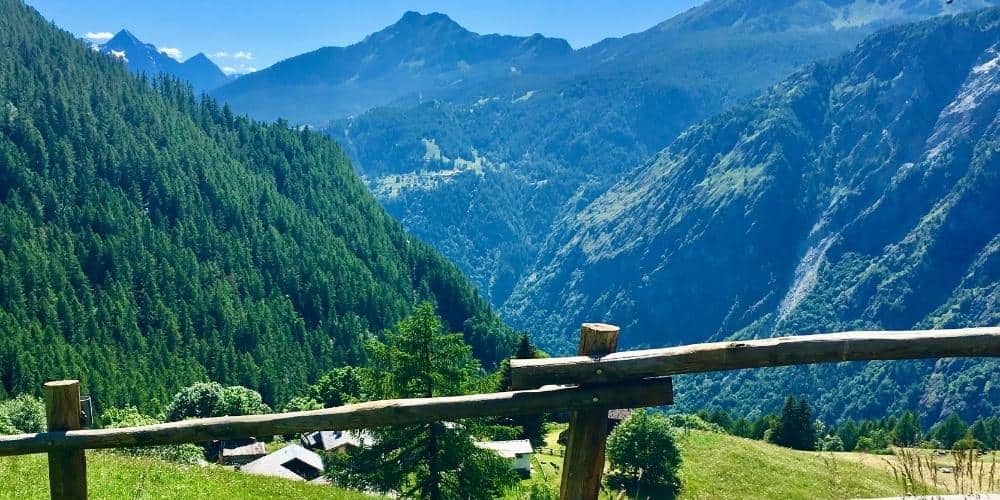
A 2-hour walk from the centre of the village and a 700-metre difference in altitude await us at an unmissable viewpoint, Le Point Sublime . From here you can enjoy a fantastic view of the Cervino , which is known the world over as "Europe's noblest rock" , as the English poet John Ruskin described it.
Le Point Sublime is also a starting point for skiing or snowshoeing in winter and spring.
Fascinating and suggestive is Lake Lord , one of the most characteristic corners of Chamois. It is located at an altitude of 2000 metres and can be reached by chairlift or on foot along simple paths. This place in reverse turns into a natural paradise for ski lovers, especially for children who are taking their first steps in this activity.
In Italy for a "Slow trip"

In this historical time of rediscovery of essential values for human life, such as family, health and serenity, in a time of crisis that the pandemic has caused in everyone's hearts, the way of travelling is also changing. The practice of Slow Tourism is making its way and growing.
Slow tourism represents a fundamental change for those who are used to desperate journeys to crowded cities, between work commitments and another. Today the priority is to leave with a greater awareness of oneself and what one wants to learn from that journey.
The choice is to experience, learn more about sustainability and experience destinations not as tourists but as part of the host community. It is also a straightforward way of travelling; the important thing is to arm yourself with a lot of willpower and curiosity.
Italy is rich in history, culture, good food, craftsmanship, nature, and above all, an unparalleled welcome. It is, therefore, a wonderfully suitable destination for experiencing this type of journey, which enriches the soul and satisfies all the needs to return to a peaceful and serene "modus vivendi".
We recommend


The Purposely Lost
- Get In Touch
- FREE Travel Planner
- Shop My Favorites
- Story Archives
Find Lyndsay's Favorites

History Travel + Local Experiences
February 25, 2023 By Lyndsay
How to Travel in Italy Without a Car: The Ultimate Guide
- 1 Do you need a car to travel in Italy?
- 2 Why travel without a car in Italy?
- 3.1 Train travel in Italy
- 3.2 Bus travel in Italy
- 3.3 Air travel in Italy
- 3.4 Ferry travel in Italy
- 3.5 Taxis in Italy
- 3.6 Motorbiking in Italy
- 3.7 Biking around Italy
- 3.8 Walking throughout Italy
- 4.1 Google Maps
- 4.2 Citymapper
- 4.3 Trenitalia and Italo
- 4.4 RyanAir and EasyJet
- 4.5 AppTaxi.it & Uber
- 5 Planning Your Italian Itinerary Without a Car
- 6 Tips for Traveling in Italy Without a Car
- 7 Challenges for Visiting Italy Without a Car
- 8 The Best Cities in Italy to Visit Without a Car
- 9.1 What is the best way of transportation in Italy?
- 9.2 What is the cheapest way to get around Italy?
- 9.3 Can I tour Italy on my own?
- 9.4 Is there Uber in Italy?
- 10 How To Travel In Italy Without A Car: Wrap-Up
This post may contain affiliate links! I will receive a commission, at no extra cost to you, if you purchase something recommended here.
How to travel in Italy without a car?
Many people might be tempted to answer “it’s not possible” right away because they tend to think of this beautiful European country as an unreachable car destination.
Italy is a country that begs to be explored, with its rich history, art, culture, and food.
But for many travelers, the thought of navigating Italy’s narrow and winding roads can be daunting, not to mention the cost and hassle of renting a car.
Fortunately, there are plenty of other ways to travel through Italy without a car–I should know; I’ve been living in Italy without a car for over a year now!
I asked my avid traveler Giorgy from G-Extreme Travel , to weigh in on this. She’s here to shine some light on the idea that you could travel in Italy without having a car!
From high-speed trains to scenic ferries, this post will show you how to experience the beauty of Italy without the need for a car.
Do you need a car to travel in Italy?
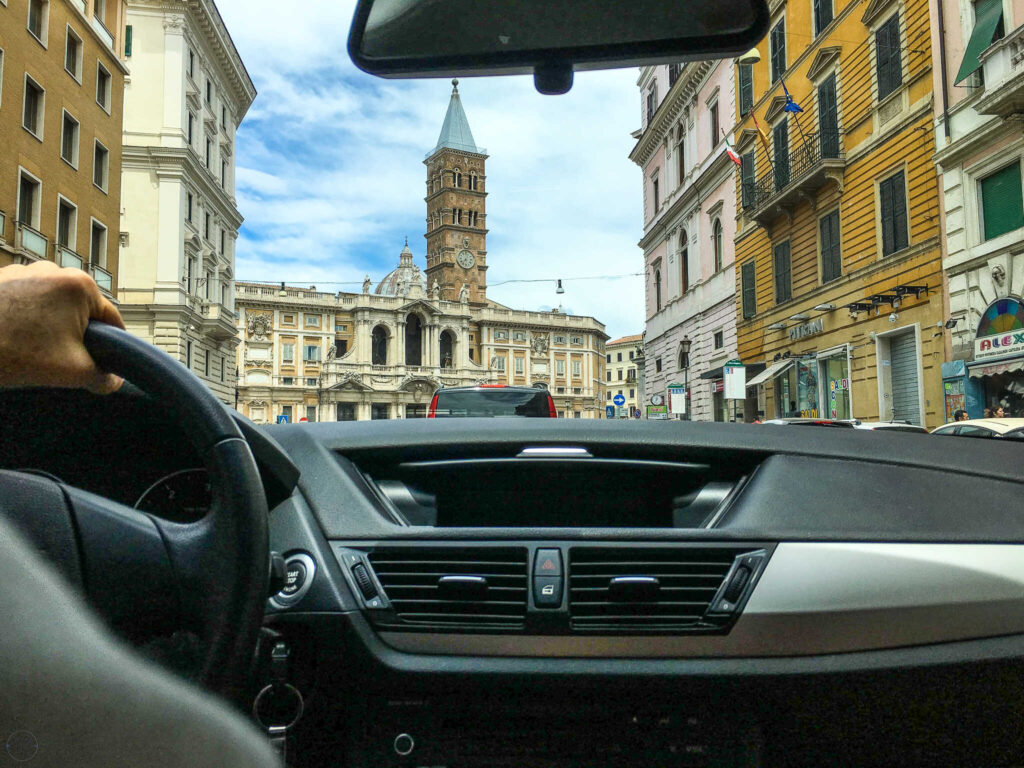
No! You don’t need a car to travel to Italy; public transportation is fantastic.
Therefore it is definitely not necessary having a car.
Although having your own vehicle can be very useful when traveling around some challenging or inaccessible areas.
I suggest renting a car for specific trips, such as traveling with kids or when you want to explore off-the-beaten-track Italian destinations .
Why travel without a car in Italy?
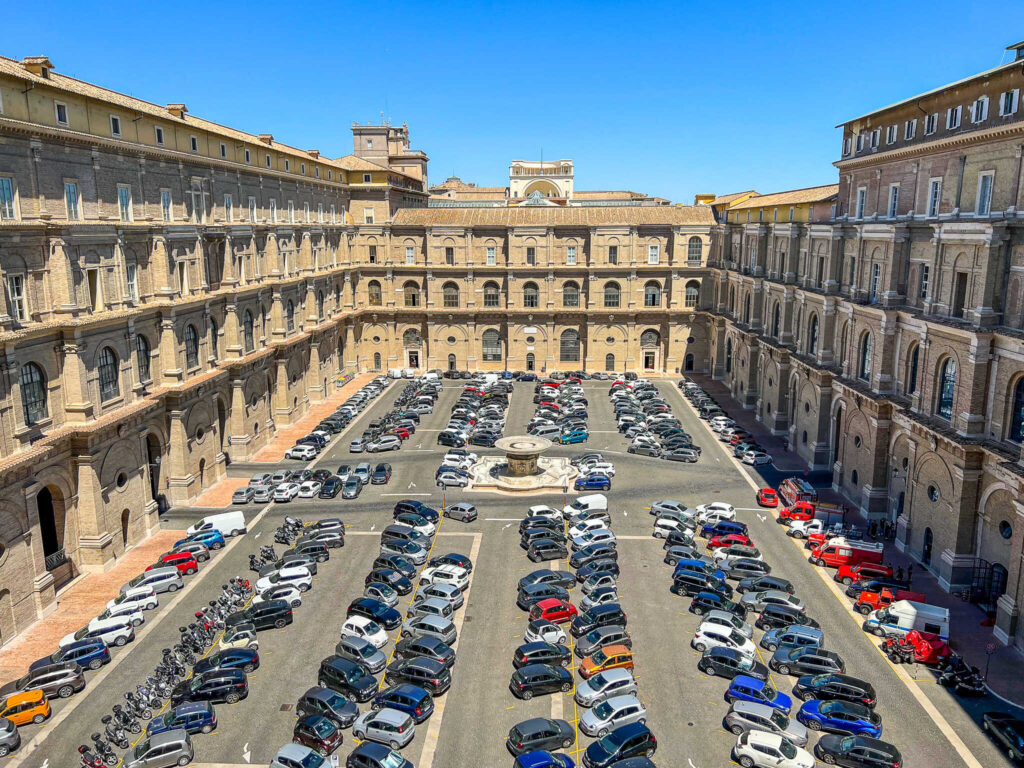
Italy is a country that begs to be explored, with its stunning coastlines, rolling hills, and charming cities steeped in history and culture.
But when it comes to getting around, driving in Italy can be challenging for even the most experienced drivers.
The narrow, winding roads, chaotic traffic, and confusing parking rules can quickly turn a relaxing holiday into a stressful one.
Fortunately, plenty of other ways to travel in Italy without a car offers a range of benefits over driving.
Public transportation in Italy is extensive, efficient, and affordable.
The country boasts an extensive rail network, connecting almost every town and city, with high-speed trains whisking you from one end of the country to the other in a matter of hours.
Buses and ferries are also popular modes of transportation, providing scenic and budget-friendly ways to explore Italy’s coastline and islands.
Renting a bike or scooter is a popular option for getting around cities, allowing you to navigate narrow streets and alleys and get up close and personal with the sights and sounds of Italy.
Finally, traveling without a car in Italy can be a greener and more sustainable way to explore the country.
Using public transportation or non-motorized modes of transport such as bikes or walking reduces your carbon footprint.
It supports sustainable tourism practices that help protect Italy’s natural and cultural heritage.
How to Travel in Italy Without a Car: Modes of Transportation
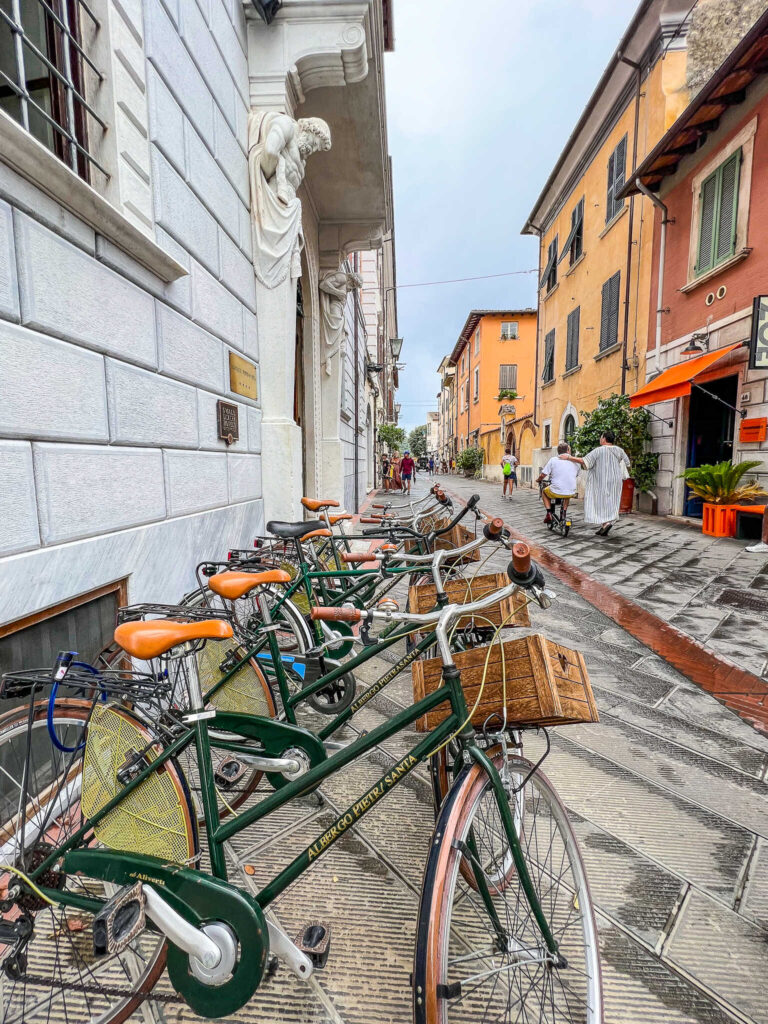
There are several different modes of transportation that you can use to travel around Italy without a car. Each has its own benefits and drawbacks, so finding the right one for your trip is crucial.
Strap yourself in because I will reveal all of them to you!
Train travel in Italy
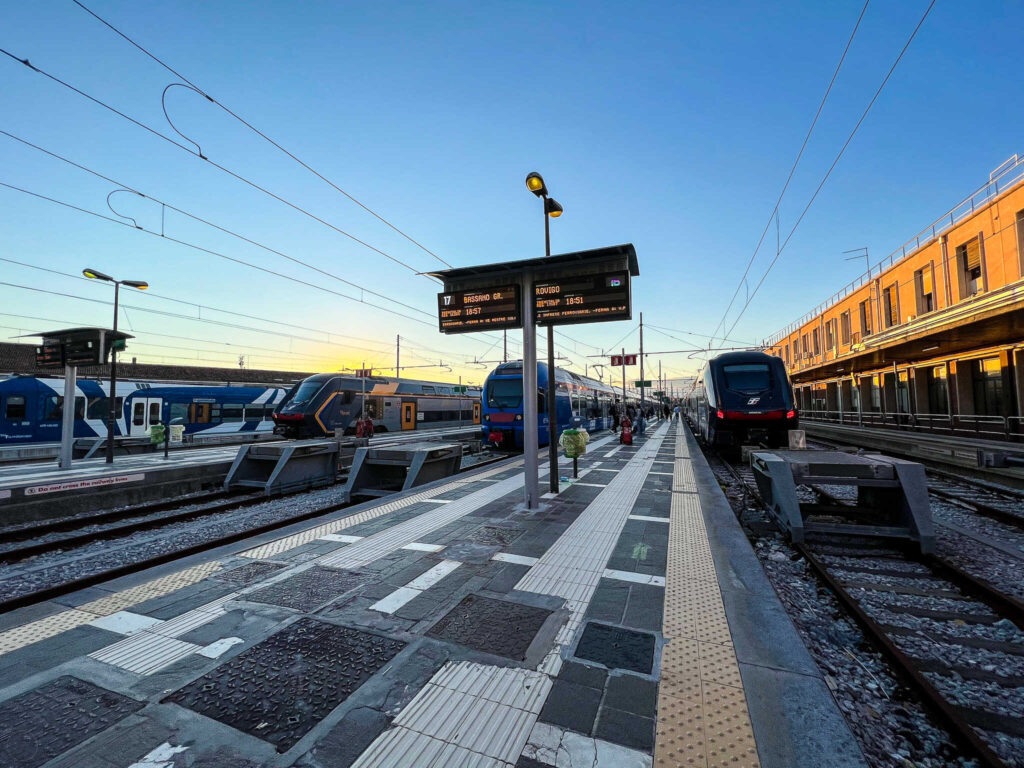
From the rolling hills of Tuscany to the stunning Amalfi Coast, over mountains, valleys, lakes, and rivers, traveling by train in Italy is a popular and convenient way to explore the country’s diverse regions.
This public transport method in Italy is highly reliable and convenient.
The train system covers most major cities and towns, and it’s very fast to reach your destination, making it easy to plan your travel itinerary.
The tickets are cheap, and you can book them in advance or at any train station, making it an excellent choice for budget travelers.
You can book tickets online through Trenitalia or Italo, the two main train operators in Italy, or through third-party websites like RailEurope or Omio .
However, it’s important to remember that trains in Italy can be busy and crowded during peak travel seasons. You may have to deal with delays or cancellations due to strikes or maintenance issues.
Bus travel in Italy
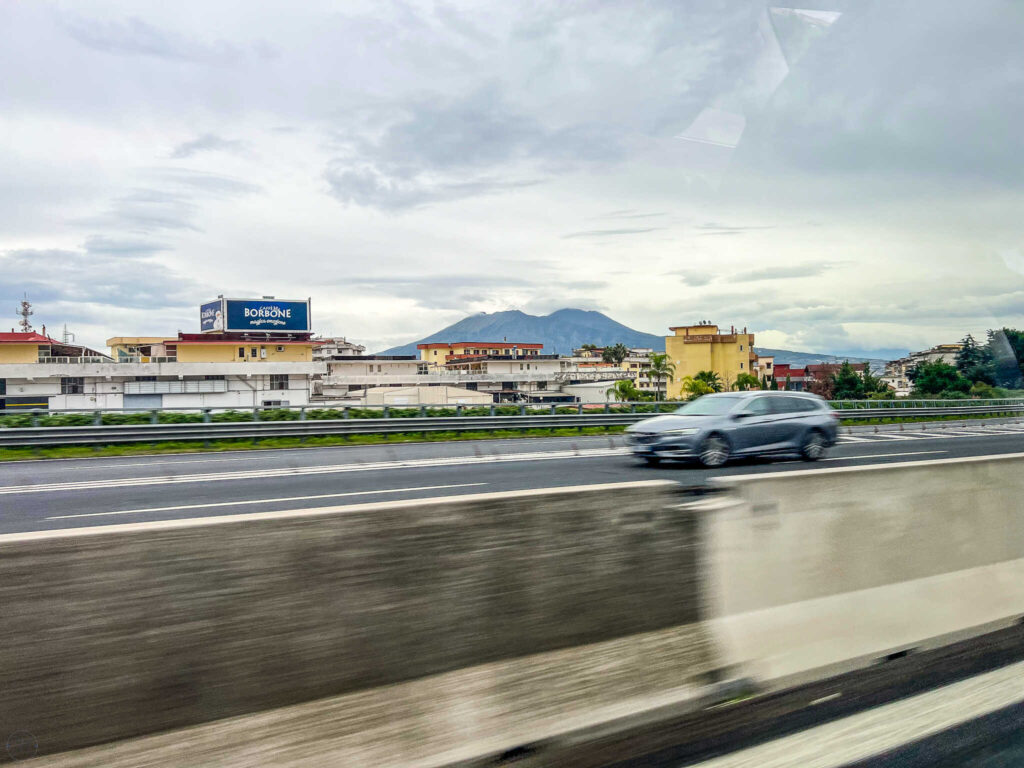
Another great option is bus travel.
It’s the most economical way to get around, and several companies operate nationwide.
The buses run frequently but are slower than the train if you want to go from one city to another.
Bus services and the metro system are the most optimal way to explore any city.
The costs will vary depending on where you’re traveling, but they should remain relatively low throughout the country.
Air travel in Italy
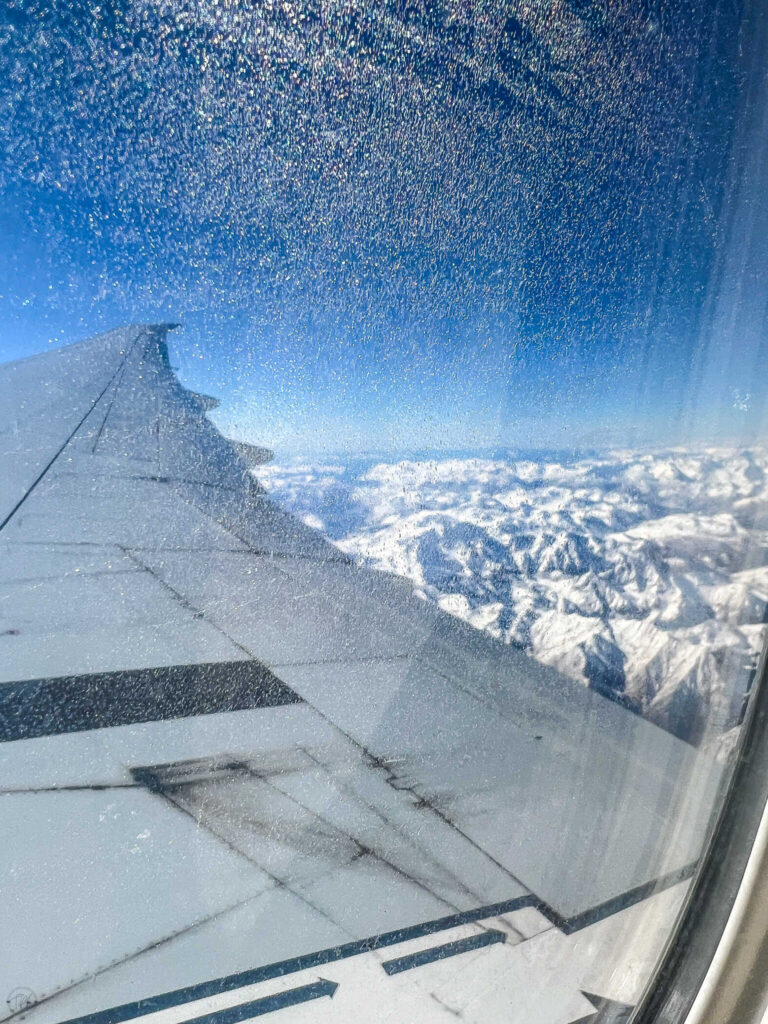
Not the best eco-friendly option, but if you’re looking to get to specific destinations that are far away quickly, then flying is the way to go.
There are many airports in Italy, and they offer domestic and international flights.
The prices vary depending on your destination, but it can be a great option if you need to get there quickly. And Ryanair might be your best choice here.
Ferry travel in Italy
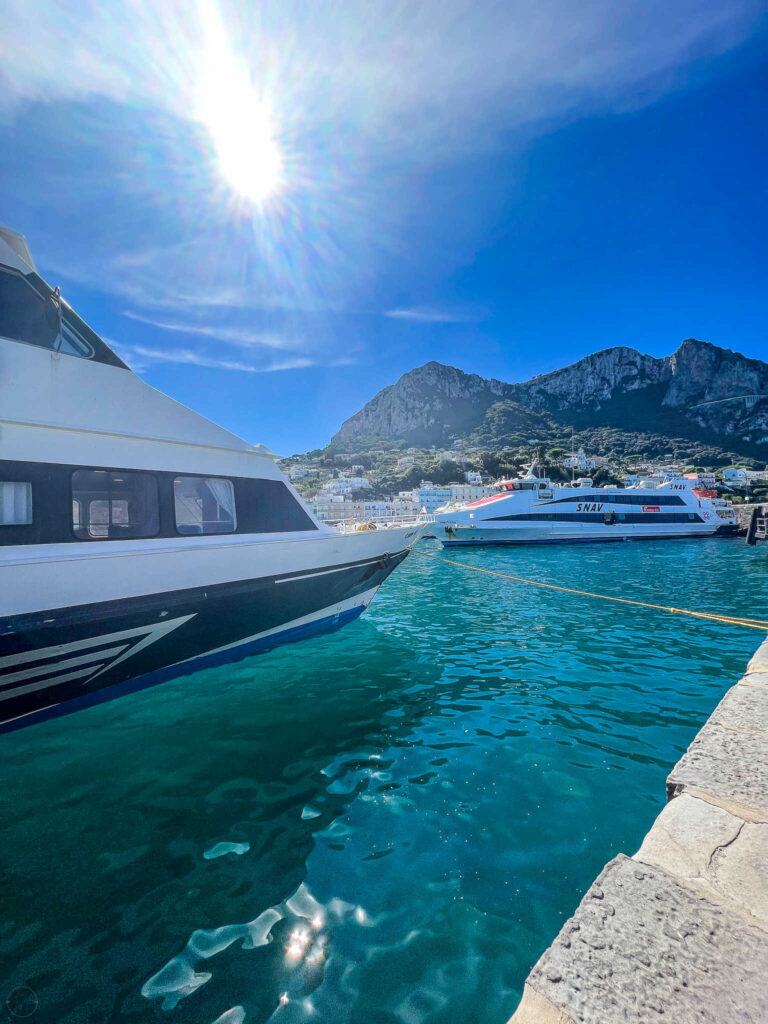
Italy’s ferry system is a great way to explore the country’s stunning coastline and the many islands that dot the Mediterranean.
Ferries and water taxis offer a more relaxed and leisurely travel experience compared to other modes of transportation, allowing you to sit back and enjoy the views.
When it comes to traveling by ferry, there are several tips to keep in mind.
It’s essential to book your tickets in advance, especially during peak season when ferries can sell out quickly.
Many ferry companies offer online booking services, making planning your trip in advance easy.
But, it’s important to check the ferry schedules and routes carefully, as some routes may only operate on certain days, or they might run less frequently than other modes of transportation.
Taxis in Italy
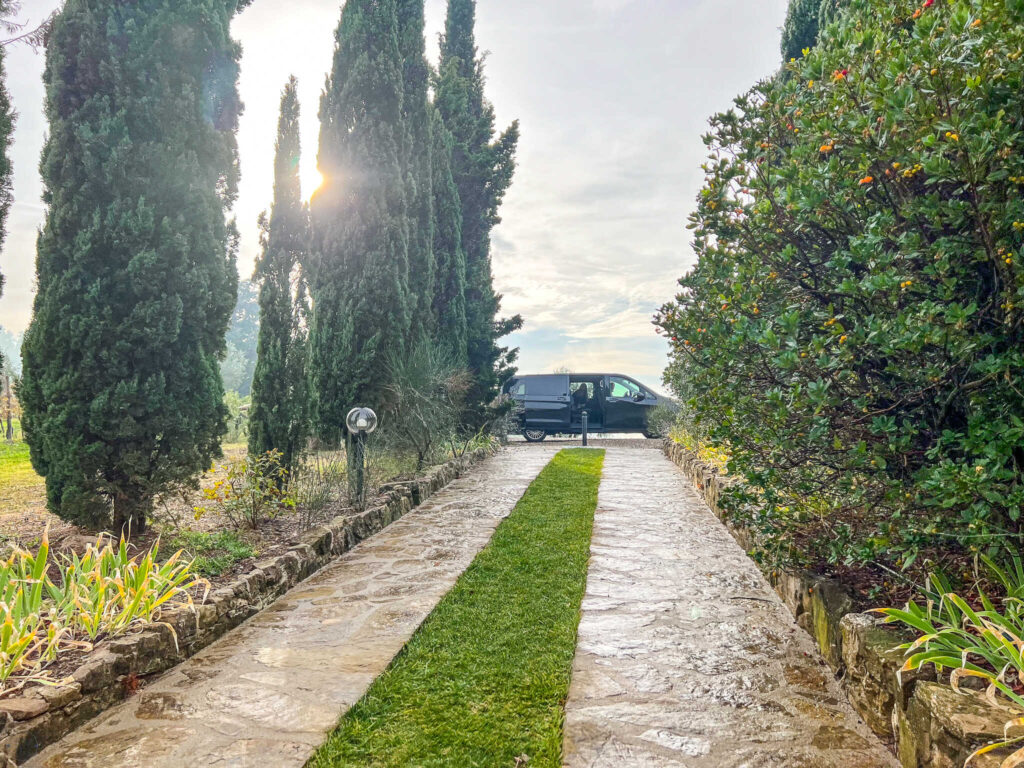
Consider taxis which are a great way to get around in Italy, especially in some off-the-beaten-track destinations.
Although they tend to be more expensive than public transportation.
You can find them at taxi stands throughout most cities and towns or hail one on the street.
Make sure to ask for an estimate before you get in the car!
Motorbiking in Italy
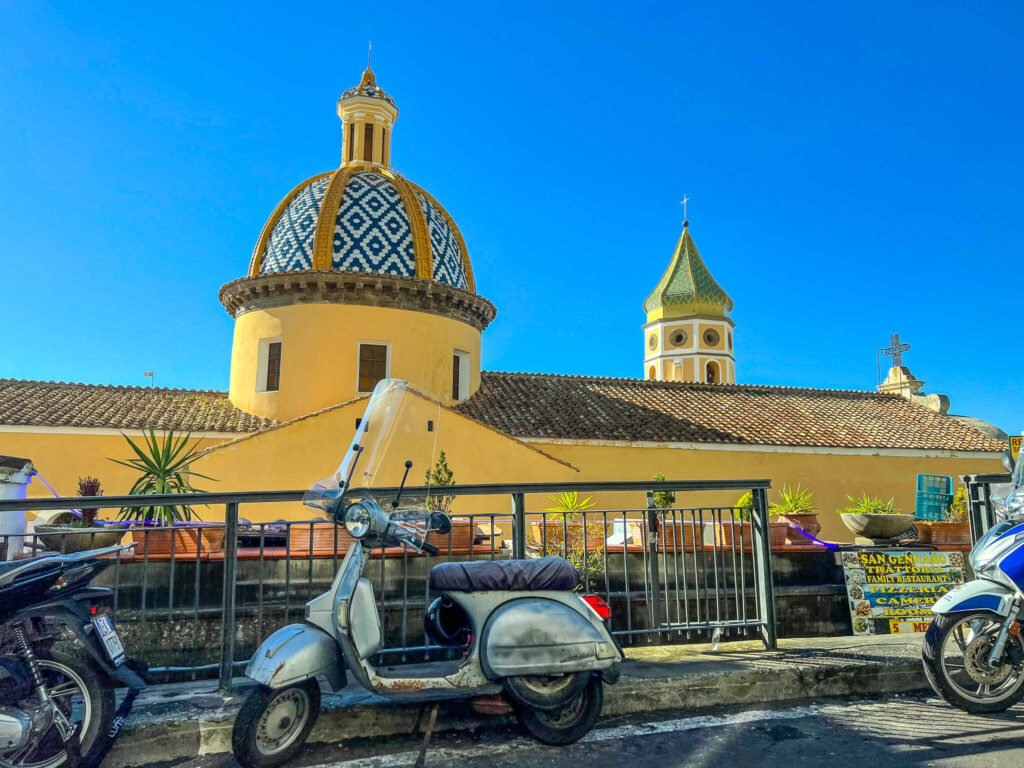
Italy is a country that’s made for motorbiking–there’s no shortage of stunning scenery to explore on two wheels.
One of the most iconic ways to experience Italy by motorbike is on a Vespa, the classic Italian scooter that’s become a symbol of the country’s style and culture.
If you’re considering traveling in Italy by Vespa or other motorbikes, make sure you have the appropriate license and insurance to ride a motorbike in Italy.
You’ll also want to be aware of local driving customs and road rules, as motorbiking in Italy can be more dangerous than other modes of transportation, especially if you’re not an experienced rider.
Biking around Italy
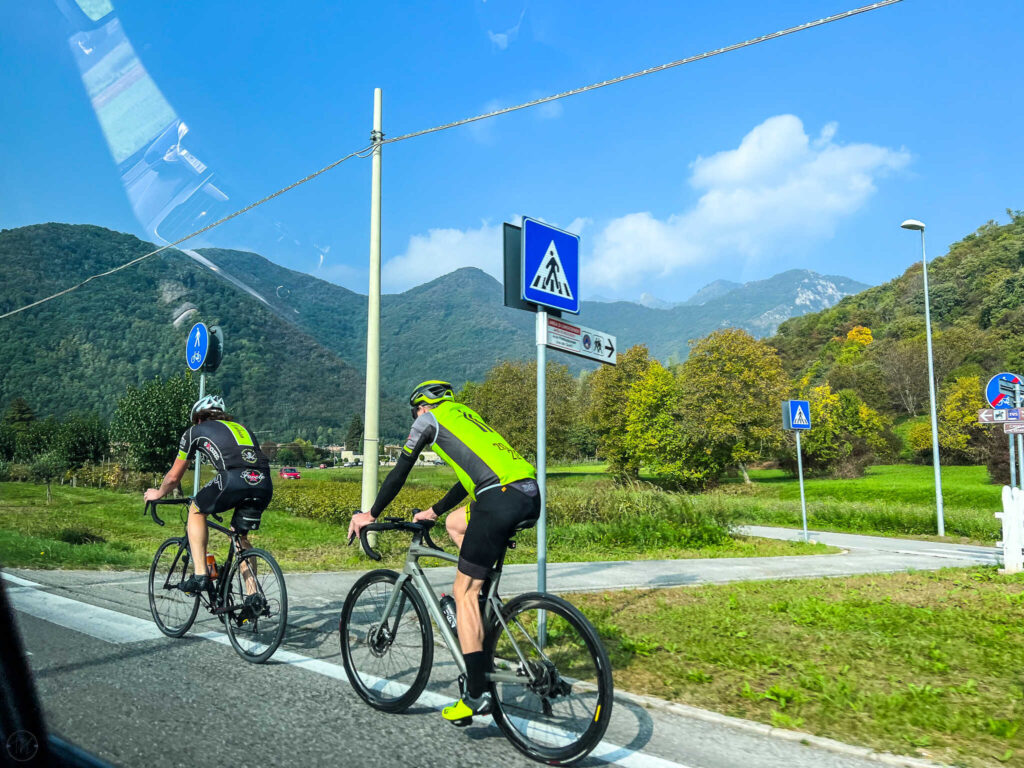
Italy is also a great country to explore by bike as it has flat terrain and plenty of cycling paths.
One of the biggest benefits is the freedom and flexibility it provides.
Bikes and scooters are great for getting around quickly and easily, allowing you to explore more of a city than you would on foot.
They’re also relatively affordable, especially when compared to other forms of transportation.
You can rent bikes in many cities; some even offer bike-sharing schemes.
Or, up in the mountains, you can travel between the beautiful towns by mountain biking.
Biking is a great way to get around, although it’s best suited for shorter distances.
If you are an enthusiastic cyclist and want to take in all of the beauty that Italy has to offer, cycling may be the perfect way for you to travel!
Walking throughout Italy
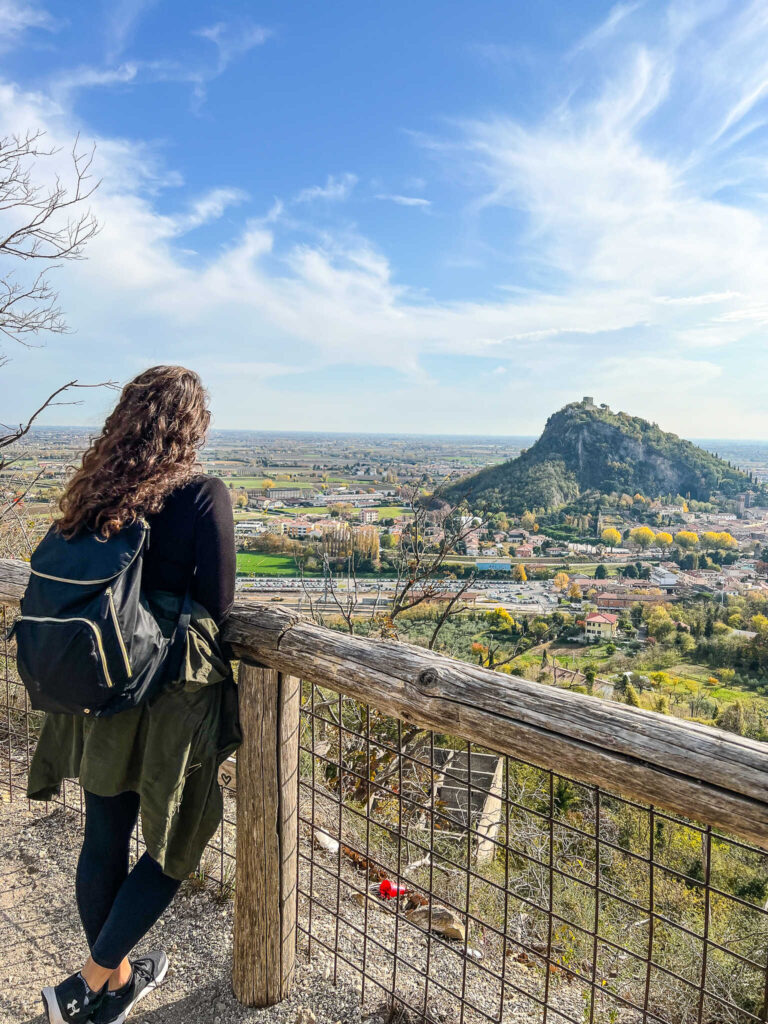
When it comes to exploring Italian cities, walking really allows you to soak up the atmosphere and experience the sights and sounds of the city, and it’s a great way to stay active while traveling.
It’s important to ensure you have a good map or GPS app on your phone.
This will help you stay on track and avoid getting lost, especially in cities with winding streets and alleys.
You can download specific areas to Google Maps for offline viewing or use an offline maps app like Maps.me .
Also, remember to stay aware of your surroundings, keep your valuables close, and avoid walking alone at night in unfamiliar areas.
Insider Tip : If you’re visiting during the hot summer months , one of the best times to visit Italy , wear comfortable shoes and bring plenty of water and sunscreen.
Best Apps for Transportation in Italy
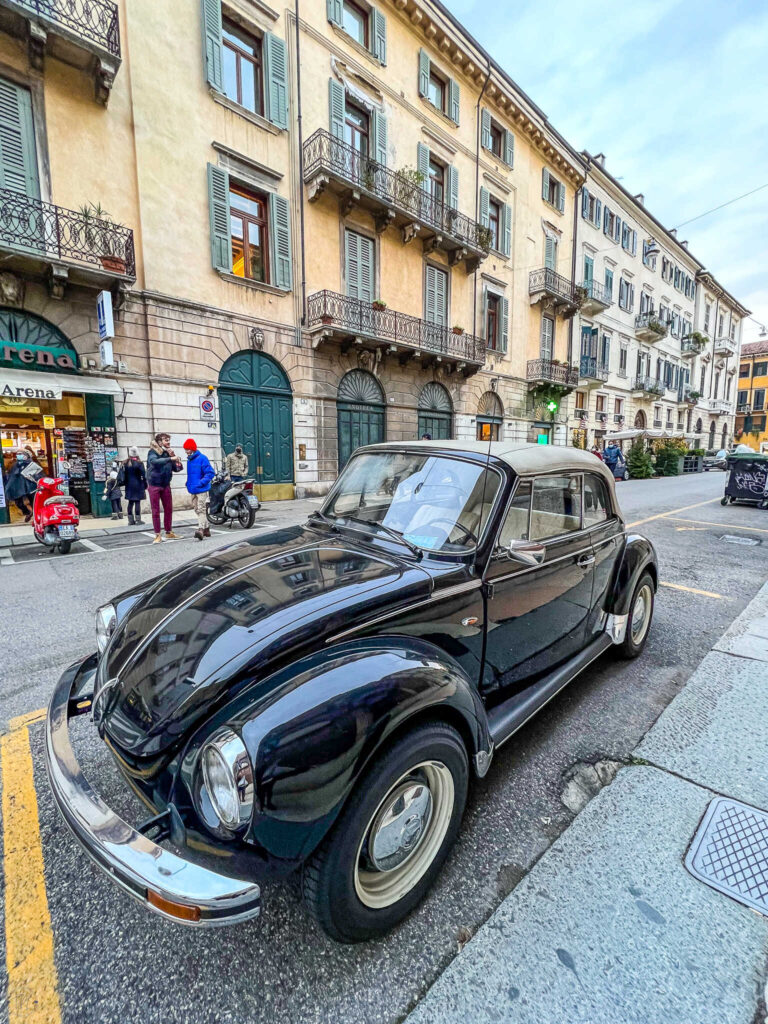
When planning your trip to Italy, it’s essential to know the best transportation apps to make the most of your journey.
The country has a fantastic public transport system.
Still, with the help of technology, you can make your travels even easier! I’ve rounded up our top picks of apps that will get you from point A to B in no time.
Google Maps
Who doesn’t know Google Maps ?
This popular app can take you wherever you need to go in Italy (even offline, just remember to download the area you visit beforehand).
All you have to do is input your starting point and destination, and it will show you the best route to get there by bus, train, bike, or by foot.
Citymapper
Citymapper is the perfect app for urban exploration.
It’s available in most major Italian cities and provides real-time information about buses and trains, so you’ll always know exactly when your next ride is coming.
Trenitalia and Italo
Trenitalia and Italo are two different train companies that operate in Italy. They both have apps available for easy access.
They allow you to book tickets in advance, and the best part is that it is even available in English.
RyanAir and EasyJet
Ready to find some exceptional cheap flight deals?
RyanAir and EasyJet are your best bet if you’re looking for a great way to explore Italy without breaking the bank.
Both airlines offer budget flights with low-cost fares, allowing you to get around quickly and cheaply.
With their easy-to-use apps, booking flights is a breeze–just enter your destination, and they’ll show you the best deals available.
AppTaxi.it & Uber
If you can’t afford to hire a private driver but don’t want to rent a car–there are always taxis!
No matter the time of day, you can find a taxi in most cities.
While your best bet is to call the local taxi company, the app AppTaxi.it will help you secure a local taxi wherever you are in Italy.
And although Uber isn’t available nationwide, it’s becoming more widespread.
You can check Uber’s website to see what regions of Italy they service.
Planning Your Italian Itinerary Without a Car
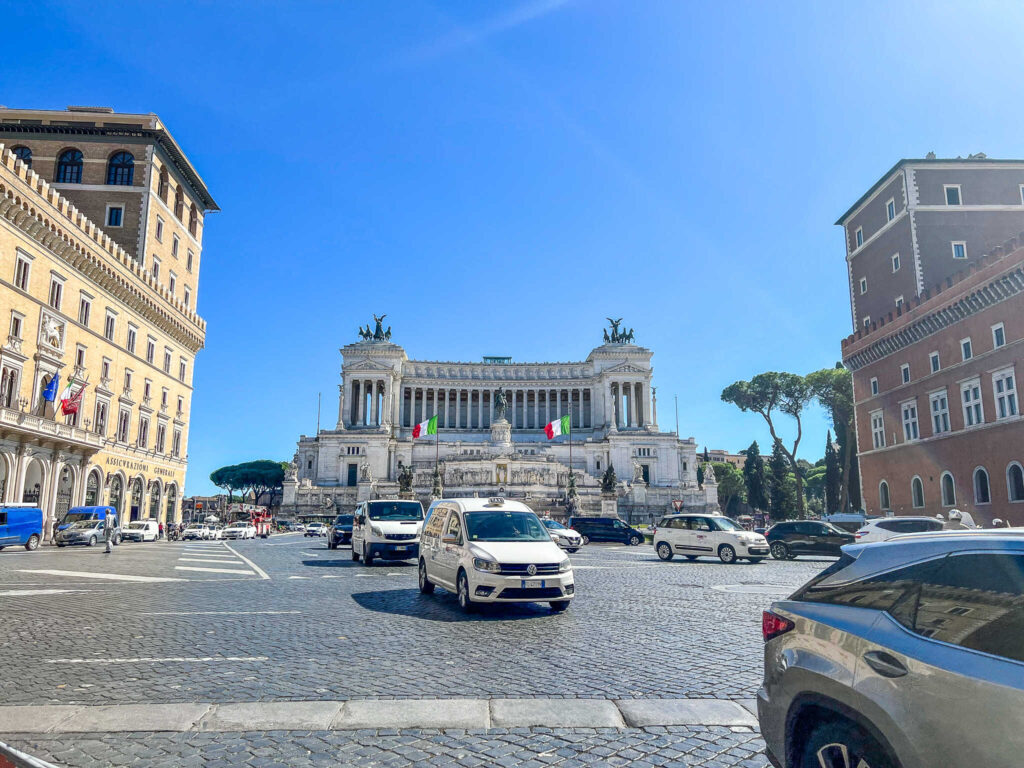
Creating an itinerary for traveling in Italy without a car can seem daunting. Still, with a bit of planning and research, it’s possible to have an amazing trip while relying on alternative modes of transportation.
When choosing destinations to visit, it’s vital to consider accessible travel options.
Look for cities and towns that are well-connected by train or bus. Consider staying in centrally-located accommodations to make it easier to get around on foot.
Train travel is the most popular and convenient option to travel between most cities and towns, with a well-connected rail network spanning the country.
Buses are also a good option for reaching lesser-known destinations and can be more affordable than trains.
Many cities in Italy have bike rental services, and walking tours can be a great way to get a more intimate view of the local culture and history.
When planning your itinerary, it’s important to factor in travel time between destinations and to allow for some flexibility in case of delays or unforeseen events.
Consider grouping destinations that are close together to minimize travel time, and prioritize the sights and activities that are most important to you.
Finally, make the most of your time in Italy by immersing yourself in the local culture and cuisine.
Take advantage of the many food and wine tours available, and try attending local festivals or events to get a taste of the local culture.
By considering accessibility and transportation options, prioritizing the sights and activities most important to you, and immersing yourself in the local culture and cuisine, you can make the most of your time in this beautiful country.
Tips for Traveling in Italy Without a Car
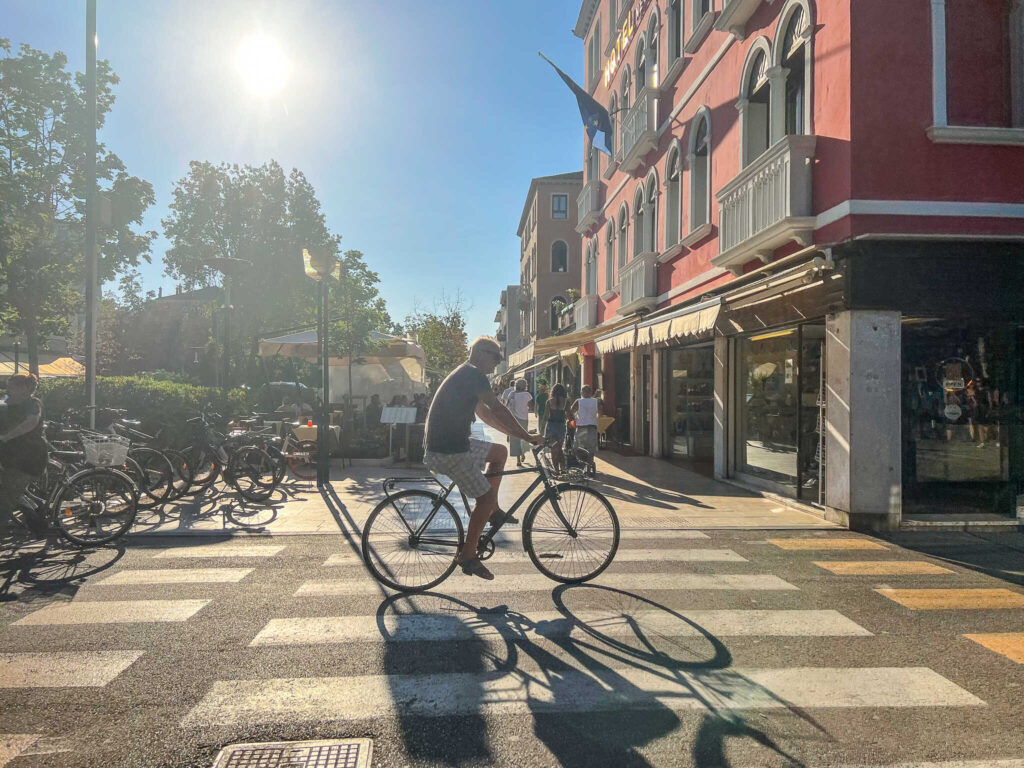
Traveling without a car in Italy can be pretty daunting, especially if you’re not used to it. However, with these top tips, you’ll be able to make the most of your journey and explore the country like a pro!
- Plan ahead: Research thoroughly before undertaking any travel plans. Check train and bus schedules and make sure you know the best routes to take.
- Take day trips from major cities: When visiting more prominent cities, it’s so easy to use it as your base for day trips to take regional trains or buses to visit smaller Italian towns.
- Pack the essentials: Don’t forget to pack all the travel essential items like a portable charger, downloading offline maps, guidebooks, water bottles, and snacks–just in case!
- Follow locals’ advice: Did you know Italians are renowned for using their hands and gestures when communicating? It might sound like an urban legend, but it’s true! Be bold and ask them for advice; Italians are friendly and helpful. They might even be able to show you the best places to go (you never know)!
- Go with the flow: Last but not least, remember to have fun! Italy is a beautiful country, and there’s so much to explore. Take your time and enjoy every moment of your journey. If your heart desires a change of course, don’t hesitate to follow it!
With these tips, you can travel to Italy without a car and make the most of your trip.
Challenges for Visiting Italy Without a Car
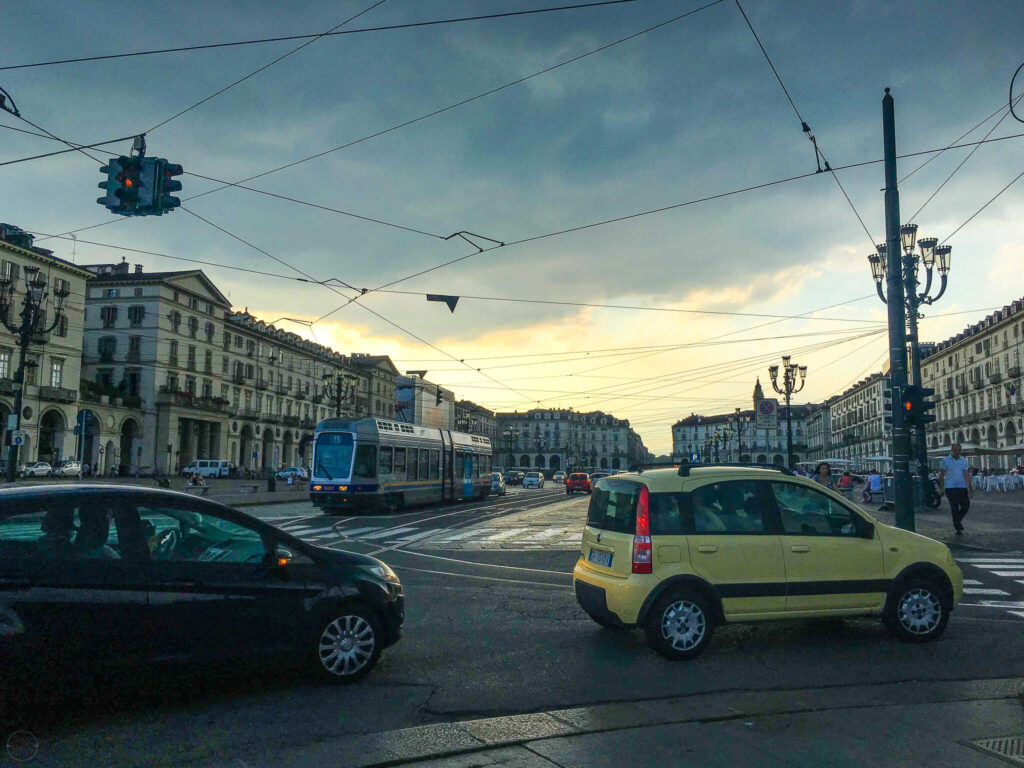
Visiting Italy without a car can be both thrilling and challenging. Without the convenience of having your own means of transportation, you’ll need to plan ahead and research thoroughly to ensure you get the best out of your travels.
Here are some challenges you might face when visiting Italy without a car:
- The public transport system in Italy can be a bit confusing. You’ll need to carefully research the timetables of buses and trains to make sure you make connections and arrive at the right place on time.
- Only some people speak English in Italy, especially in little towns, so it might be tricky to find your way around if you don’t speak Italian. Speaking slowly and using hand gestures might help you get your point across. Or, Duolingo could be your friend, in this case, learning some basics before heading to Italy!
Despite these challenges, visiting Italy without a car can be a great experience. You’ll get to explore the country like a local and make memories that will last forever!
The Best Cities in Italy to Visit Without a Car
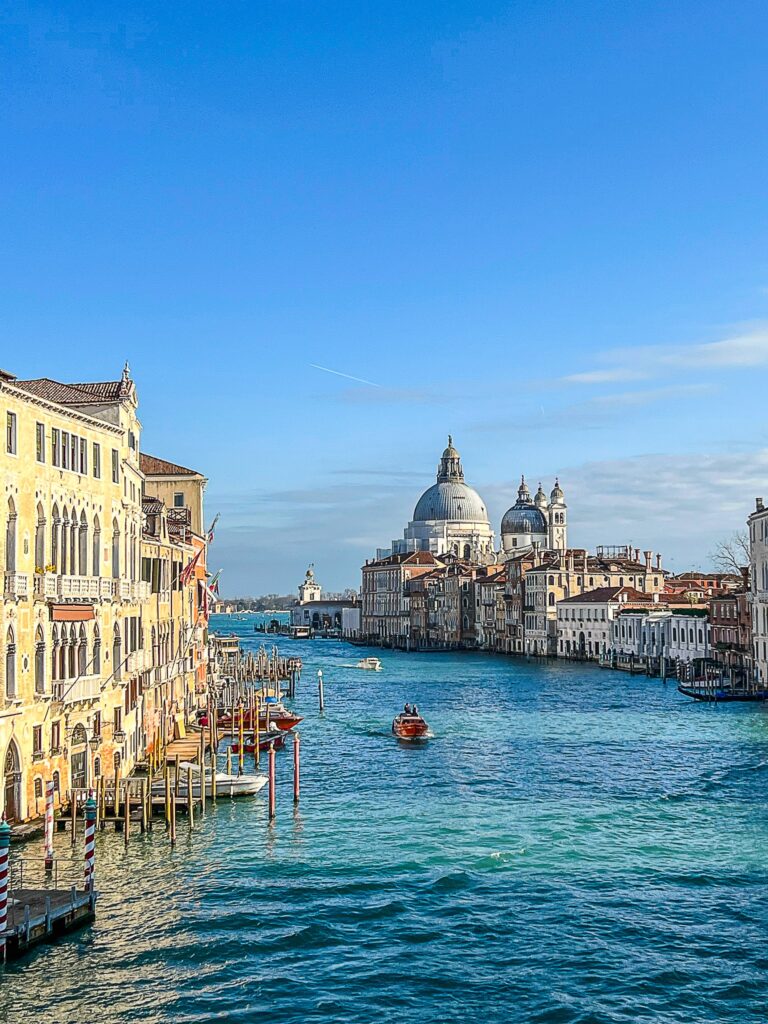
There are so many different destinations in Italy that are easy to reach by public transportation!
Here’s a look at some of the best cities in Italy to visit without a car:
⭐️ Florence : This Renaissance city is a must-visit for art and history lovers. Florence is easy to navigate on foot, with many of its top attractions located within a small area. The city also has an extensive bus and tram network, making it easy to explore beyond the historic center.
⭐️ Venice : With its canals, bridges, and narrow streets, Venice is a city best explored on foot or by boat. You can take water taxis or hop on a Vaporetto, a water bus that’s a popular and affordable way to get around if you’re spending 2 days in Venice .
⭐️ Rome : While Rome is a sprawling city, many of its top attractions, from the Colosseum to the Trevi Fountain, are located within walking distance of each other. The city also has a comprehensive metro system, as well as buses and trams.
⭐️ Milan : Milan has a comprehensive metro system with trams, buses, and other modes of public transportation. It also has two airports that are connected to the city center by train. One of the best ways to explore Milan in 3 days is on foot–you’ll be able to take in all the sights and sounds of the city as you wander through its narrow streets.
⭐️ Cinque Terre : This picturesque string of fishing villages along the Ligurian coast is car-free, making it a perfect destination for travelers without a vehicle. Visitors can hike between the villages, take the train, which runs along the coast or take a ferry between cities.
⭐️ Naples : This bustling southern city is known for its lively street life, delicious pizza, and historic sites. Naples has an extensive metro system with buses and trams, and a myriad of motorbikes, making it easy to explore the city and surrounding area.
⭐️ Verona : This romantic city in northern Italy is best known as the setting for Shakespeare’s “Romeo and Juliet.” Verona is easily accessible by train and has a compact historic center that’s perfect for exploring on foot.
⭐️ Amalfi Coast : For travelers who want to explore this stunning stretch of coastline, there are plenty of options for getting around without a car. You can take the local train service along the northern coast, use the public bus system, hire a private driver for day trips to towns like Positano , or rent a bike and go mountain biking on the trails that wind through the villages.
By taking advantage of public transportation or exploring on foot, you can experience the best of Italy without the stress of driving.
How to Get Around Italy Without a Car: FAQs
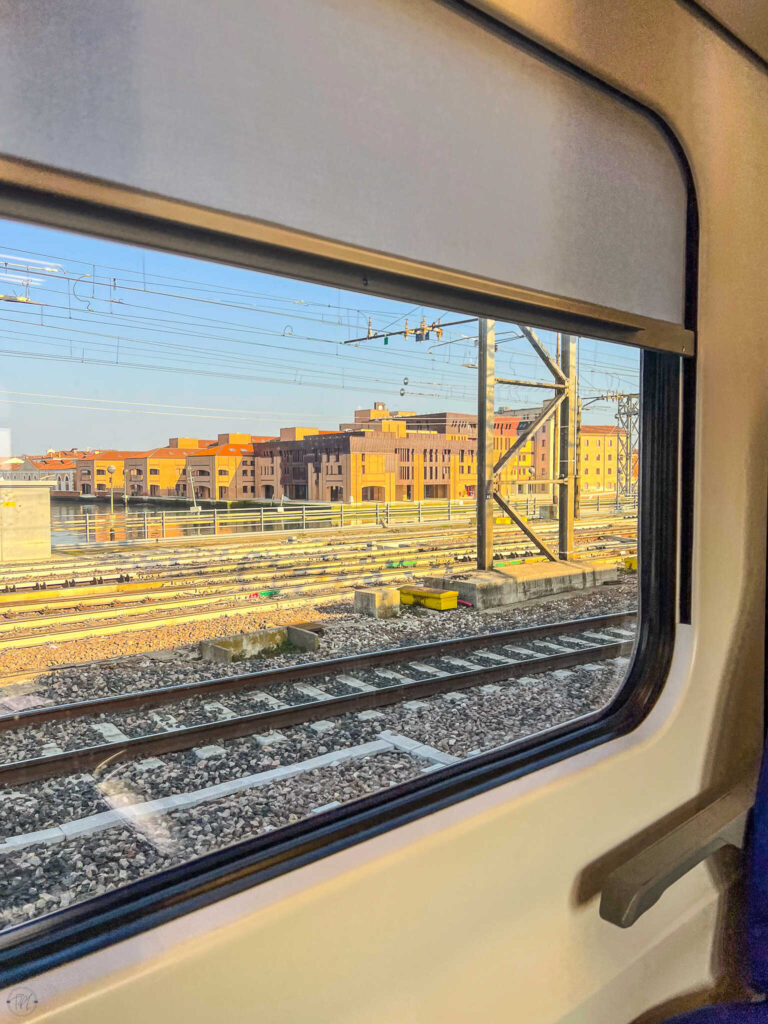
Now that you know whether it is possible to travel in Italy without a car, let’s move on to questions that might be helpful.
What is the best way of transportation in Italy?
For a hassle-free journey between cities and towns in Italy, the most reliable mode of transportation is via train.
However, renting a car would be your best option if you’re looking to explore quaint countryside areas or traditional villages.
To accurately plan out distances for traveling between different destinations, use Google Maps or Omio –both are invaluable tools!
What is the cheapest way to get around Italy?
Exploring Italy by train is the most cost-effective and convenient way to get around.
In contrast, traveling by car can be rather pricey for tourists.
So if you’re looking for an affordable option, look no further than going by rail!
Can I tour Italy on my own?
Yes, you can explore Italy on your own.
However, if you’ve never traveled to Italy before and are uncomfortable exploring a country on your own when you don’t know the language, private tours are an excellent option.
By taking a private tour by car, you can go at your own pace and hand-pick destinations based on what you and your travel companions desire to experience.
Not only is this incredibly convenient, but also it’s a great value to make the most of your travels and see all the country has to offer!
You can relax knowing that an expert will be guiding the way while enjoying all of the breathtaking sights along with incredible memories made together.
Is there Uber in Italy?
Despite rumors, Uber is not accessible across all of Italy.
As a result, travelers should be aware that if they plan on traveling to the country and utilizing Uber services, it may not always be available in certain areas.
The lack of Uber drivers in some Italian cities has everything to do with resistance from other taxi drivers.
To add to this, Italian authorities have also decided that Uber creates unfair competition, which may adversely affect the livelihood of regular taxi drivers.
But have no fear–you know there are plenty of alternatives to get around Italy, so don’t let the lack of Uber dampen your spirits!
How To Travel In Italy Without A Car: Wrap-Up
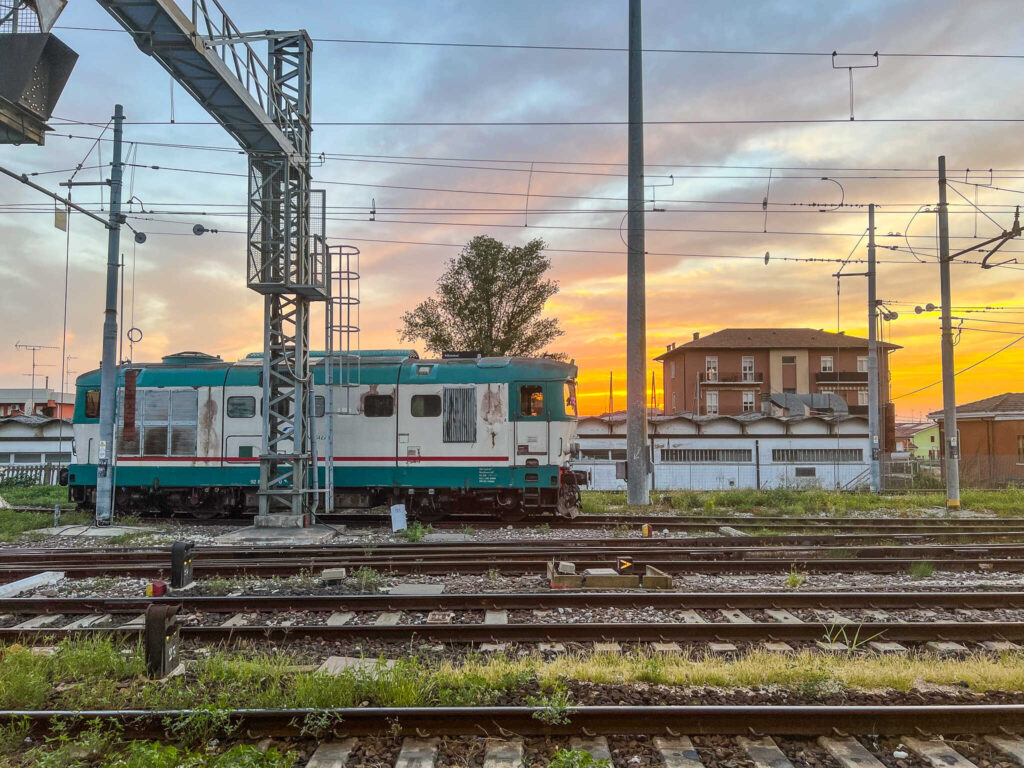
Although road trips are fun, they’re not for everyone.
Traveling to Italy without a car doesn’t have to be a daunting task–in fact, it can be quite an unforgettable experience!
With the right planning and research, you can easily explore this extraordinary country’s majestic beauty at your own pace.
Whether you’re looking for cheap transportation options or private tours that offer unique experiences, there are plenty of ways to make your trip unforgettable.
So don’t let the lack of a car stop you from immersing yourself in Italy’s culture and history–get out there and explore!
Buon viaggio 🙂
- Does It Snow in Italy? Your Ultimate Snow in Italy Guide
- Must-See Hot Springs in Italy: 10+ Natural Wonders to Discover
- Your Complete Guide to Wheelchair-Accessible Italy
- The Art of Riposo: Siesta in Italy
- A Quick Guide to the Drinking Laws in Italy
- Reviewing Castel Brando: An Unforgettable Italian Experience
Grab your Travel Planner
Planning your next adventure can become overwhelming. Stay organized with this free, printable travel planner!
You can unsubscribe anytime. For more details, review our Privacy Policy.
You have successfully joined our subscriber list.
You've successfully joined our subscriber list.
You’ll Also Love
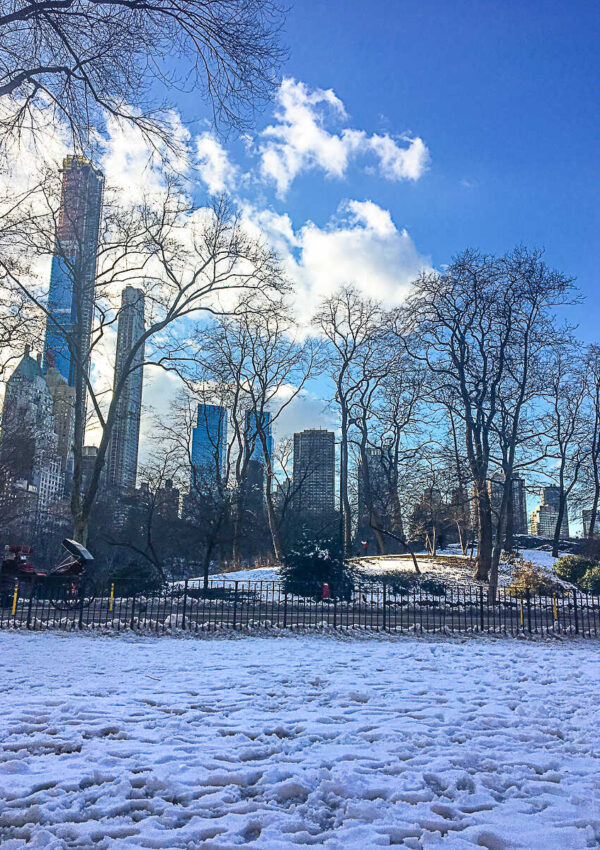
30+ Amazing Things to do in Pula, Croatia

Become Purposely Lost
I'm Lyndsay! Thank you so much for joining me here at The Purposely Lost.
Latest on Instagram
- Affiliate Disclaimer
- Cookie Policy
- Privacy Policy
- Terms and Conditions
- Accessibility Statement
- United States
- Travel Tips
Copyright © 2024 The Purposely Lost · Theme by 17th Avenue
Copyright © 2024 · Mia On Genesis Framework · WordPress · Log in
Privacy Overview
clock This article was published more than 2 years ago
Don’t let a rental car shortage keep you from these bucolic Italian destinations
If you’re ready to dip your feet back into European travel, Italy may be high on your list of destinations. After a brutal year-plus of pandemic lockdowns and restrictions, the country is cautiously open to foreign tourists. Reduced crowds — for now, at least — and businesses eager to welcome back customers make this a surprisingly splendid time to visit.
But if your plans for an Italian vacation involve a rental car, you may want to rethink that strategy. Record rental car prices and a lack of available cars, especially on short notice, mean that 2021 and 2022 aren’t the best years for the Great Italian Road Trip.
Fortunately, Italy provides options. Travelers with a little affinity for planning and an appetite for slow travel can find smaller cities and towns reachable by public transportation that can serve as bases for exploring the surrounding areas by foot, bike or motorized methods that don’t involve signing a rental car contract.
Fewer, costlier rental cars
The rental car shortage, well-documented in the United States , is no less dire in Europe. The causes behind it are much the same: companies sold off their fleets during the pandemic, factories suspended production of new cars and semiconductors are scarce. Giuseppe Benincasa, general director of ANIASA , Italy’s rental car trade association, explained that the Suez Canal blockage in March created a “pazzesca” (“crazy”) chain reaction, as massive containers full of materials were delayed for a month or more.
On top of the same perfect storm of problems afflicting North America, Italy’s rental car industry has additional challenges. Getting rental cars to islands such as Sicily and Sardinia is next to impossible, says Benincasa, because even if cars were available, “there’s no space on the ferries,” as Italians flock to these summer destinations with their own cars.
What to know as Europe reopens to U.S. travelers
And when inventories do start to return to pre-pandemic levels, prices are still going to be high as Europe gradually converts to a greener fleet. There’s an industry-wide commitment on the continent to move to hybrid and electric cars; Benincasa says rental car suppliers buy an average of 40 percent of all hybrids and electrics built in Europe. Not only can manufacturers not meet the demand for eco-friendly cars, but these cars also cost more. And until their technology and production become the industry norm, those costs will get passed on to renters.
The case for no car
Madeline Jhawar, who runs the aptly named trip-planning service Italy Beyond the Obvious , urges travelers to look at the absence of a rental car as a bonus. “Curious travelers can discover Italy’s magic in so many different ways,” Jhawar says. “Going without a rental car is not just ‘making do,’ since you can have an amazing trip, discover the sights and scenery, connect with locals and have an authentic experience, all without a rental car.”
Besides, as anyone who has ever tried to maneuver through the narrow streets of a centro or find a legal parking spot in a historic town knows, having a car in Italy can be a real hassle. Park in a residents-only lot in Florence, and you’ll risk being towed. Wander unwittingly into a ZTL (a limited traffic zone), and you’ll be greeted with a hefty traffic ticket as a post-vacation homecoming gift. Other places, such as the notorious Amalfi Coast drive, with its steep drop-offs and hairpin turns, or the vertigo-inducing roads around the lakes of Northern Italy, are nerve-racking enough to suck the joy right out of the scenery.
“Don’t think that you can’t get into the Italian countryside without a car,” Jhawar says. With trains, ferries, water buses, taxis, drivers, mountain cable cars and funiculars, bikes, e-bikes and hiking paths, “you can really explore the corners of Italy for quite a ways before you need a car.”
Jhawar says visitors are often surprised that many hotels — especially those just outside of smaller towns with train stations — offer free shuttle service for station pickup and drop-off. Some countryside restaurants even offer the service, so you’re not limited to eating just at places within walking distance of your lodging.
Everything you need to know about traveling to Italy this summer
By boat, bike or ski gondola
We asked Italian travel experts for their ideas on where to go and how to get there and around — all without a car. Here are some of their favorite destinations.
●Ponza, the largest of the Pontine Islands, is still less than four square miles in area. “Ponza is an island that is sure of itself,” says Rome-based blogger Gillian Longworth McGuire, who runs the Instagram account for Visit Ponza . Visitors to the island, which is connected by daily ferries from Anzio, Terracina and Formia (all on the Rome-Naples train line), don’t miss what’s missing here — namely the superyachts, high-end shopping and luxury hotels of tonier places such as Capri or Sardinia’s Costa Smeralda. Ponza, she says, “has a wild, rugged charm complete with electric-blue water, fiery sunsets and rocky paths that lead to secret coves. The food scene ranges from panini on the beach to fine dining on fresh fish.” Here, Longworth McGuire says, “the best parking spots in the port are for the local fishing boats and not the visiting yachts.” And there’s no place on the island that can’t be reached by foot, scooter, public minibuses, or self-driven or piloted boat or Zodiac raft. That said, it’s a summer-only destination, with most hotels, rentals and restaurants open only from May through September.
●With their toothy peaks, high mountain valleys and sheer vastness — more than 350,000 acres — the Dolomites don’t look easy to get to. But the dramatic mountain landscapes of Italy’s second-largest UNESCO World Heritage Site (just behind the Cilento and Vallo di Diano National Park in Southern Italy) are remarkably accessible, thanks to a system of major and secondary rail lines, buses, ski lifts and funicular railways. From Trento, Katia Vinco of Trentino Marketing recommends taking the local train toward Mezzana to reach the mountains. “You’ll pass through two of Trentino’s most enchanted valleys, Val di Non, with its orchards and castles, and Val di Sole, the realm of the Stelvio National Park, mountain biking and rafting,” Vinco says. Jhawar is a fan of Bolzano, with its pretty, walkable medieval center; excellent archaeological museum dedicated to Ötzi the Iceman; and connecting trains to Bressanone/Brixen and Merano. “There’s no need for a car in those towns,” she says, “and ski lifts connect to well-marked hiking trails of every level of difficulty.” In high summer season, hikers can take one lift up, hike for hours in one direction, then take a different lift back to lower elevation and catch a bus to their point of origin.
●If you’re set on exploring the smaller towns of Italy’s green, rolling heartland, don’t despair about a lack of wheels. Several of Umbria’s hill towns are on the main or secondary rail lines. At Orvieto and Spoleto, for example, trains arrive at the lower towns, and visitors reach the upper towns via funiculars, elevators or escalators cut into the “rocca,” or “rock,” on which the ancient settlements were built. Although the countryside around them is not always easily accessible without a car, the towns offer a slower pace, small museums, important churches and cathedrals, and plenty of opportunities to taste local food and wine. Orvieto (bias alert: this author lives nearby) was a major Etruscan city, and extant sites include a necropolis, remains of a temple, and an extensive cave network carved into the volcanic tufa plateau underneath. Its duomo, or main cathedral, has a soaring, mosaic-covered Gothic facade and is among the most famous in Italy. Spoleto also predates the Romans, but its oldest sites, including a theater, an amphitheater, a restored house and traces of an ancient road, all date to Imperial Rome. A massive 14th-century fortress looms over the upper town, which contains a dozen or so churches that date to the high and late medieval era.
●Not only do you not need a car to visit Lake Como, but you also really shouldn’t have one, says Samy Ghachem, managing director of Il Sereno , a lakefront hotel in Torno. “The real magic of Lake Como is best seen from the water, as all along the shores are charming little villages,” he says, noting that the road around the lake is at a much higher elevation than the waterfront. “When these lake towns were first built, they were connected by boat, not by roads,” Ghachem says, “and boats are still the best way to get around.” A network of ferries, including hydrofoils and historic steamers, has been in place since the 1800s and makes it easy to hop from town to town, either on day trips or in a multiday tour of the lake. Frequent direct trains from Milan reach the towns of Como and Lecco, at the southern end of each of the lake’s two forks. From there, several boats a day ply the lake, calling at small towns along the way — although we doubt actor and director George Clooney uses public transportation to reach his lakefront villa — and offering one stunning vista after another. On the northern Italian lakes of Maggiore and Garda, Jhawar likes the towns of Stresa and Salò, respectively, as car-free bases for exploring those waters. Direct trains from Milan serve Stresa, while Salò is reachable by bus from Brescia.
Heath is a writer based in Allerona, Italy. Her website is elizabethfheath.com . Find her on Instagram: @myvillageinumbria .
More from Travel:
Rome’s seven hills offer seven green respites from summer’s crowds
Paradise found: Lago Maggiore, the ‘Eden of Italy’
Europe travel is complicated. Take these 7 tips from travelers who just went.
The coronavirus pandemic has disrupted travel domestically and around the world. You will find the latest developments at washingtonpost.com/coronavirus

Tuscany Without a Car – Transport Options + Where to Stay
Are you dreaming of a visit to Tuscany but don’t want to drive?
Tuscany, one of Italy’s loveliest (and most popular) regions is really made for driving… zipping around in a FIAT 500 over rolling hills, and past vineyards, charming hilltop villages, beach towns, and incredible cities like Florence and Siena.
But, if you don’t want the stress of parking, getting gas, paying tolls, navigating, and avoiding ZTLs (phew, that’s a lot!) – Don’t worry, there are plenty ways to get around Tuscany without a car!
You’ll also need to be strategic with where you stay in Tuscany if you’re not planning on moving around by car. In Tuscany without a car, you have both city and countryside accommodations options, and each have their pluses and minuses.
Let’s take a look at:
- Transport options in Tuscany without a car
- The best places to stay in Tuscany without a car
When you’re done reading, you’ll have a good idea of where to base yourself in Tuscany for your travels here without a car.
Why listen to me? I’m a mamma of three who lives in Tuscany. I’ve been immersed in the Tuscan landscape since 2003 in many ways – as a traveler, a cycling and hiking guide, a vacation planner, and a mom. These are my personal recommendations, based on my experiences and those of visiting clients, friends, and family.
Andiamo – Let’s go!
This page contains affiliate links. If you purchase from the links, we may earn a small commission, at no extra cost to you. Please see our Disclaimer for more information.
Table of Contents
How to Get Around Tuscany – The Most Common Ways
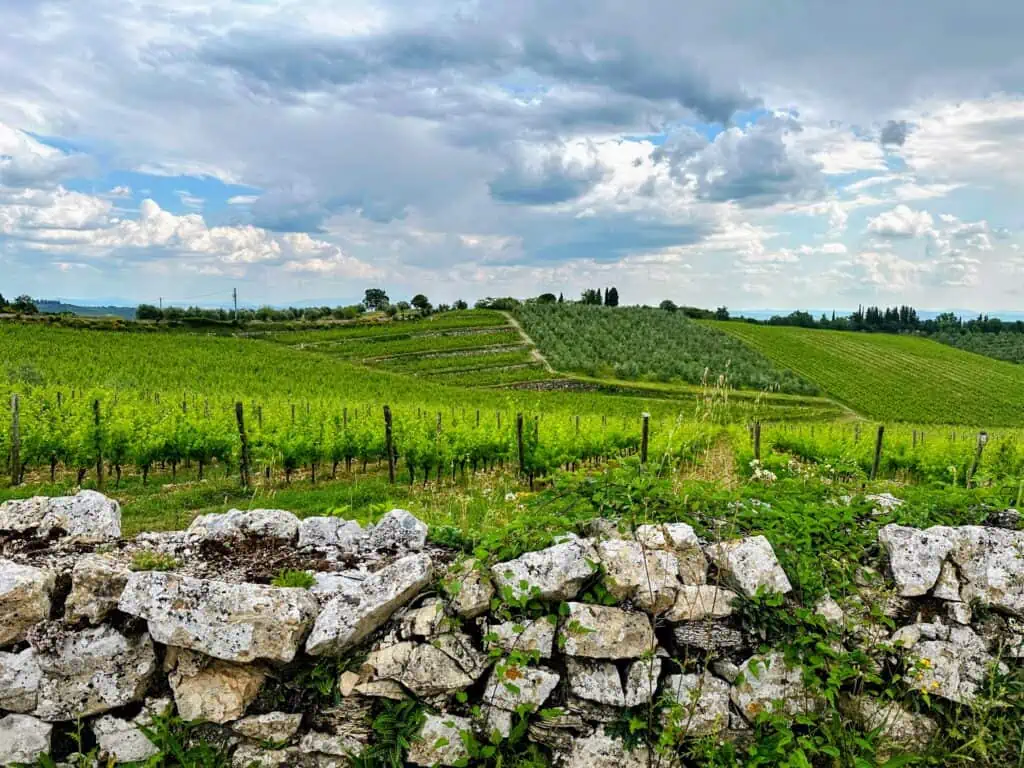
There’s not a perfect way to get around Tuscany – each method has its pluses and minuses. Let’s look at the most common ways of moving around Tuscany.
Good To Know: Cycling is another amazing way to move around Tuscany. You can go on a multi-day trip on your own (bring or rent a bicycle), with an organized group like Backroads, or take a day tour .
Good To Know: Don’t want to drive but don’t want to book a private driver? You can also use a taxi to get you to and from a day trip destination. This is often a good last-minute option, but be sure to check rates, and make sure you have a return ride (with the same taxi or a taxi in your destination).
How to Travel Around Tuscany Without a Car
Use the train to travel around tuscany.
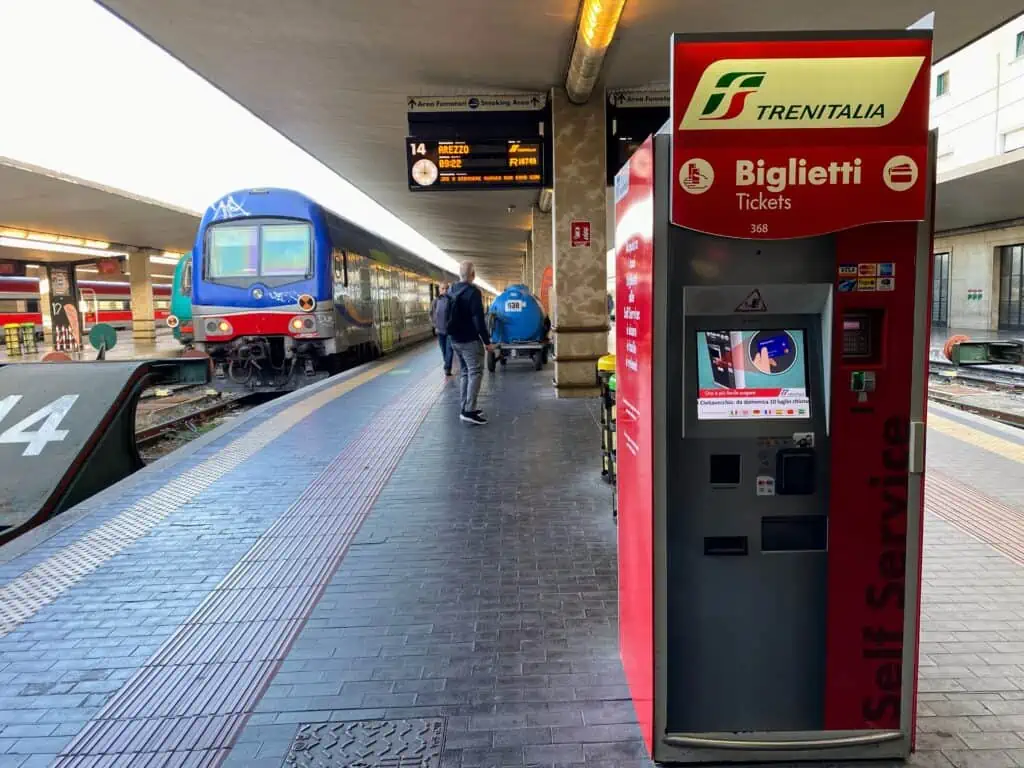
One of the easiest ways to see Tuscany without a car is by using the train. Many Tuscan towns and cities are well-connected by train, including Florence, Lucca, Pisa, Viareggio, Pistoia, and Arezzo.
You’ll be taking slower (scenic!) trains that connect the cities, and you can buy a ticket for these trains last minute, so trains are a nice option if you don’t want a strict Tuscan itinerary.
Keep in mind that you won’t be able to take trains to smaller villages (like in Chianti). And, you may need to take another form of transport to get to your final destination. For example, if you take the train from Florence to Cortona, you’ll need to take the bus or a taxi from the train station to the town center.
Read more about Train Travel in Italy
Travel Around Tuscany by Bus

Bus travel in Tuscany is comfortable and fairly reliable. Buses are a handy way to reach some of the special destinations in the Tuscan countryside that don’t have train service. But, you may be tied to a rigid schedule – some destinations may be served only once or twice per day.
I recommend using buses as a complement to other methods. For example, if you’re based in Siena, you could:
- Take a day trip to Florence by train
- Take an organized day tour to Pienza and Montepulciano
- Take the bus to Monteriggioni
- Take the bus to Chianti villages
Good To Know: Our main bus company is AT – Autolinee Toscane (used to be SITA ). But, there are also smaller companies in some places. I find the best way to know which bus company and route to take is to look at a Google Map of the route. You can even follow along while you’re on the bus to make sure you get off at the right place (I do this).
Hire a Private Driver to Travel Around Tuscany
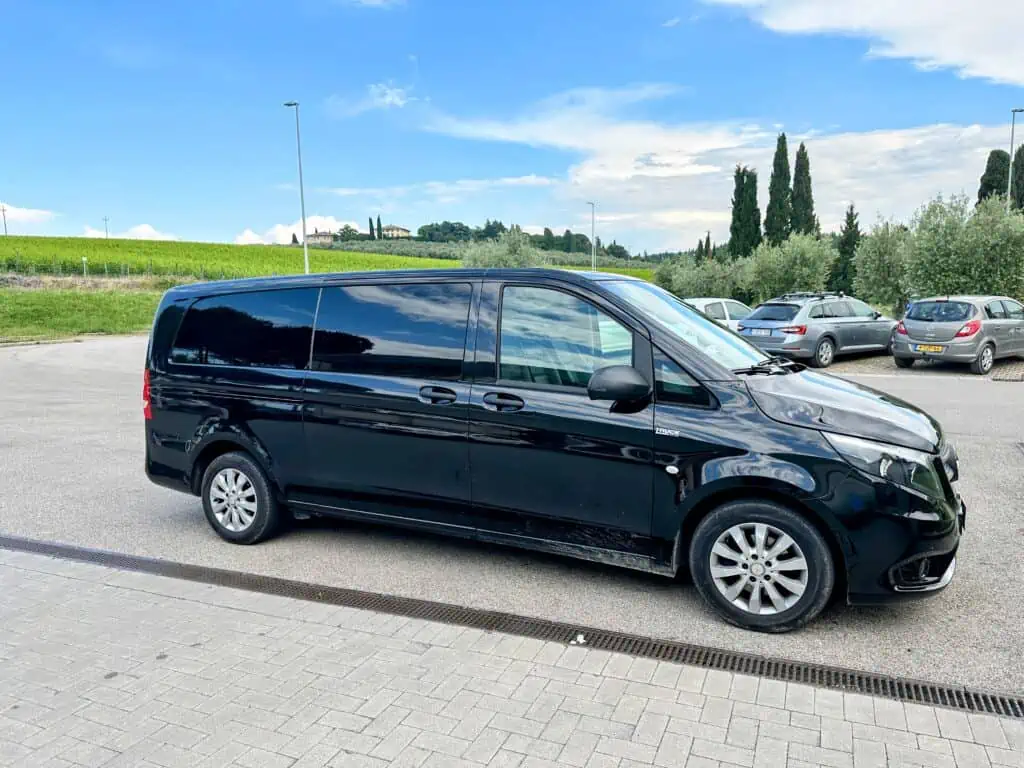
If it’s in your budget, hiring a private driver is an excellent way to see the parts of Tuscany you want to see, when you want to see them. You can organize your day(s) to fit your group, and if your driver speaks English, you can ask questions and learn about life in Tuscany.
Prices vary greatly by season, destinations, and length of tour.
A private driver in Italy is called an NCC – noleggio con conducente (rental with driver). These drivers have a special license and you can see an NCC decal on the back of their vehicles next to the license plate.
Feel free to contact some of my Recommended NCCs in Tuscany .
Take a Day Tour in Tuscany
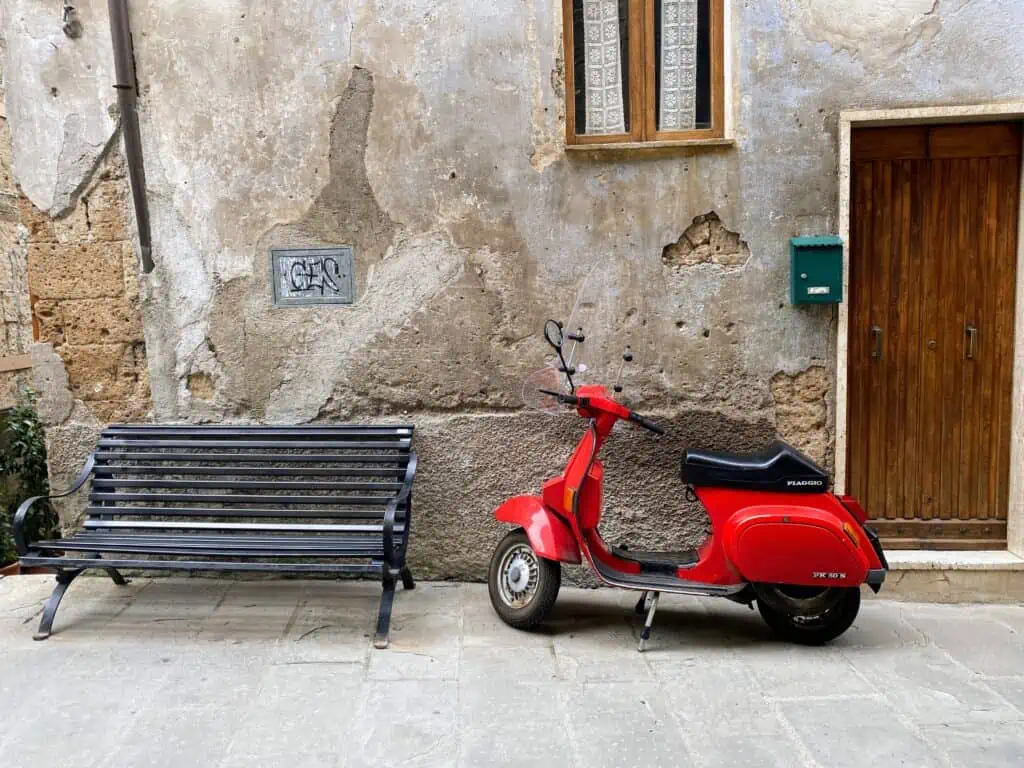
Day tours are less expensive than private drivers, but you lose the option to customize your tour, and you’ll be traveling with others.
Day tour experiences vary – some are large bus tours, other times you’re in a small van, and sometimes you’re on a bicycle or a vespa. It’s important to read the fine print and contact the tour operator if you need clarification on what the tour entails.
Although I prefer independent travel and private tours, I sometimes sign up for organized day tours. Why? Because they’re easy and you can meet other interesting people, and as long as you have the proper expectations, they can be a lot of fun!
You can book day tours through travel agents or using online resources like GetYourGuide or Viator.
Where to Stay in Tuscany Without a Car
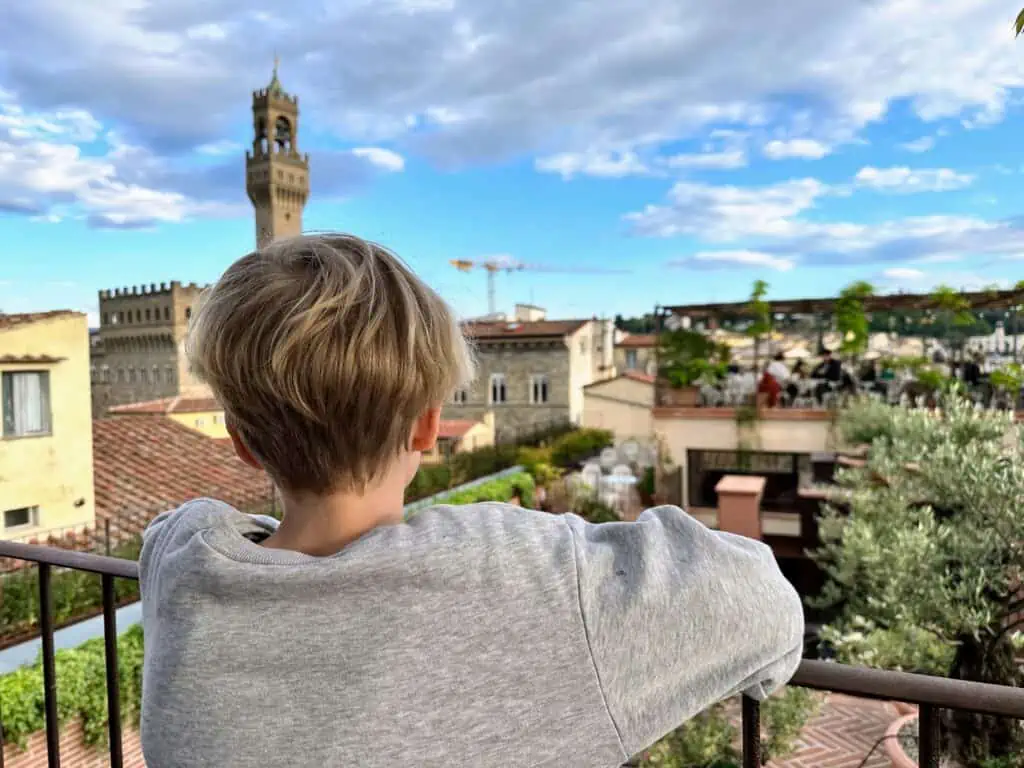
While you can stay anywhere in Tuscany without a car, here are a few suggestions that are popular and work well, based on my experience planning trips in the region.
I’m listing both city and countryside options. As you read through them, keep in mind some of the advantages and disadvantages of each type of stay:
Good To Know: You can reach most places in Tuscany (even many small villages) by public transport, but you may spend all day doing it. I’m only including places that are easy to reach by train or bus .
Florence (City)
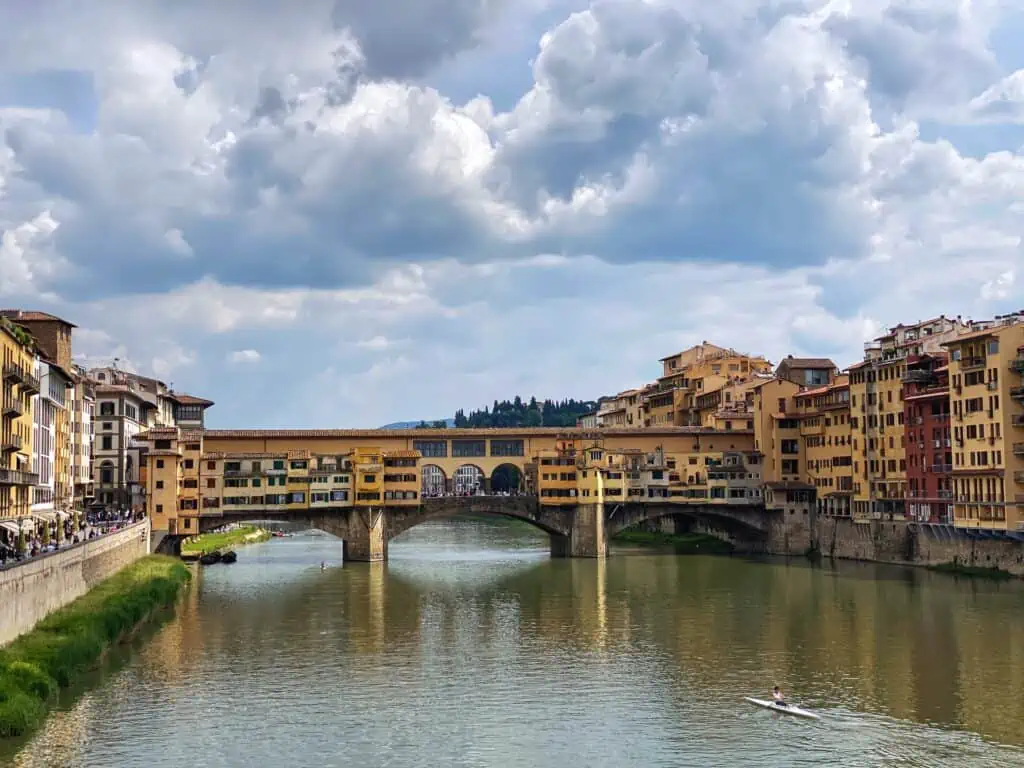
Stay in the birthplace of the Renaissance and the capital city of Tuscany – Florence. You’ll have plenty to do in Florence – like visiting Michelangelo’s David at the Accademia , strolling across the Ponte Vecchio with a gelato in hand, and walking up to Piazzale Michelangelo for sunset – and you can also take day trips (or overnight trips) into the Tuscan countryside.
From Florence, you can take public transport to many places, and utilize private drivers, buses, or day tours to access other destinations. For example, some places you can easily visit include:
Train – Lucca, Pisa , Siena, Pistoia, Viareggio, Arezzo, Cortona (with quick bus ride up to town)
Bus – San Gimignano, Siena, Greve in Chianti, Panzano in Chianti
Day Tour – Tons of options, like this Chianti Wineries Tour or this Val d’Orcia
Tour that includes Pienza, Montepulciano , and Montalcino. Check out GetYourGuide or Viator for tours in Tuscany – from wine tastings to city walking tours to cooking classes.
Private Driver – Anywhere in Tuscany!
Helpful Tip: If you’re planning on taking day trips into Tuscany by train, book your Florence accommodation in a neighborhood near the Florence Santa Maria Novella train station (aka Florence SM Novella or Florence SMN).
You may want to read about Where to Stay in Florence Best Views in Florence Best Day Trips from Florence Florence in December Day Trips from Florence with Kids
Siena (City)
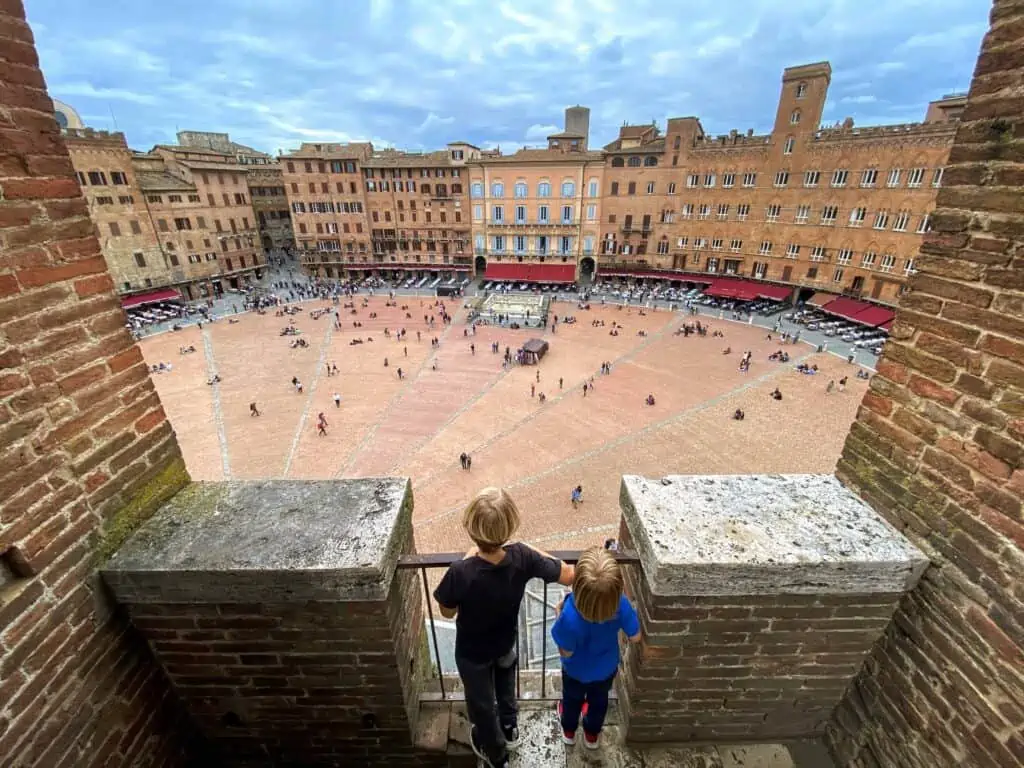
Siena, home to the famous Palio horse race, is quieter than Florence, but it’s gorgeous and you’ll find plenty to do in the city while you’re not out exploring Tuscany. Hang out in the Piazza del Campo, climb the Torre del Mangia, and check out the striking Duomo of Siena (and the Piccolomini Library’s incredible frescoes and illuminated manuscripts).
Siena was left off of the major train and road routes, so instead of experiencing growth like Florence, it’s maintained a small city feel.
While you won’t have as many train or bus options as you have in a larger city like Florence, you are closer to some parts of Chianti, the Val d’Orcia and its villages, and even gems further south like Saturnia hot springs and memorable villages in Southern Tuscany like Pitigliano.
Places you can easily visit from Siena include:
Train – Florence
Bus – Monteriggioni , San Gimignano, Florence, Volterra, Arezzo, Chianti villages (especially Castellina in Chianti and Radda in Chianti )
Day Tour – There are day tour options available from Siena, like this Montalcino Wineries Tour , this Pienza and Montepulciano Tour , or this Val d’Orcia Wine Tour .
Lucca (City)
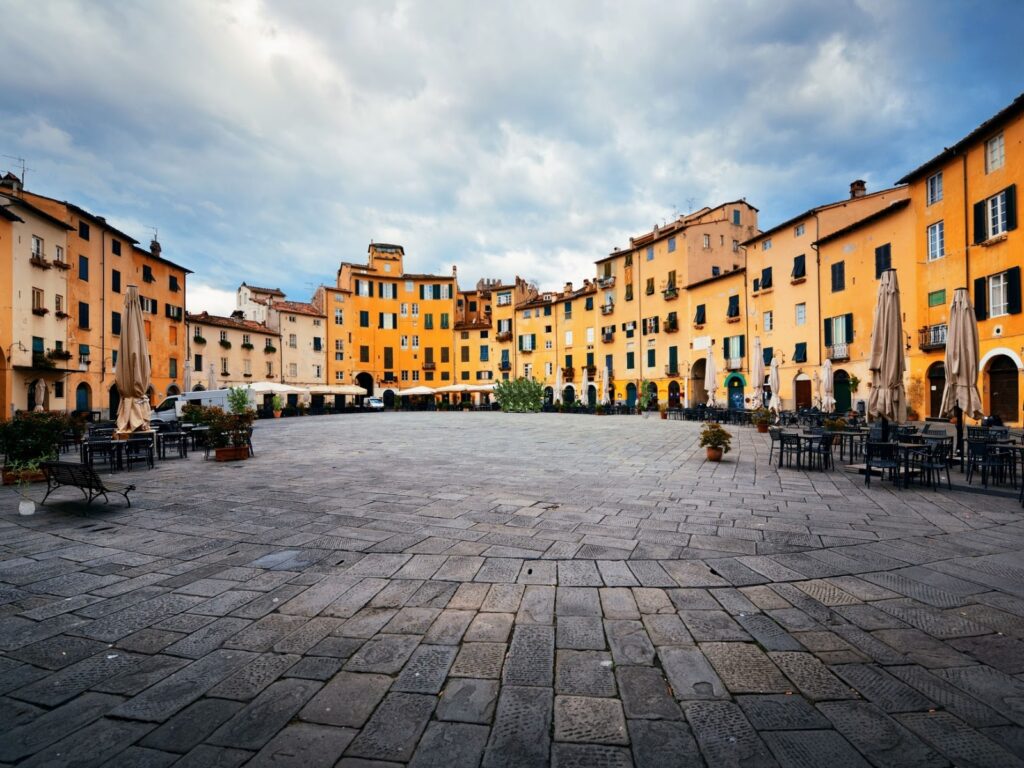
Most people who visit Lucca are pleasantly surprised by the ‘real’ town with gorgeous piazzas, narrow lanes full of shops and restaurants, the tower with the tree on top, and those famous ancient city walls that you can walk or cycle on(!).
Lucca is a smaller city by the Mediterranean Sea coast, so you’ll have access to Tuscan beach towns in addition to inland countryside towns.
There are both trains and buses leaving from Lucca, so you have options for day trip transport. And, in the evenings, you can enjoy local Lucca life.
Places you can easily visit from Lucca include:
Train – Florence, Pisa, Pistoia, Viareggio
Bus – Collodi (village and Pinocchio Park ), Florence
Day Tour – There are limited day tour options that depart from Lucca, like this Self-Guided Lucca to Pisa Bike Tour .
Chianti (Countryside)
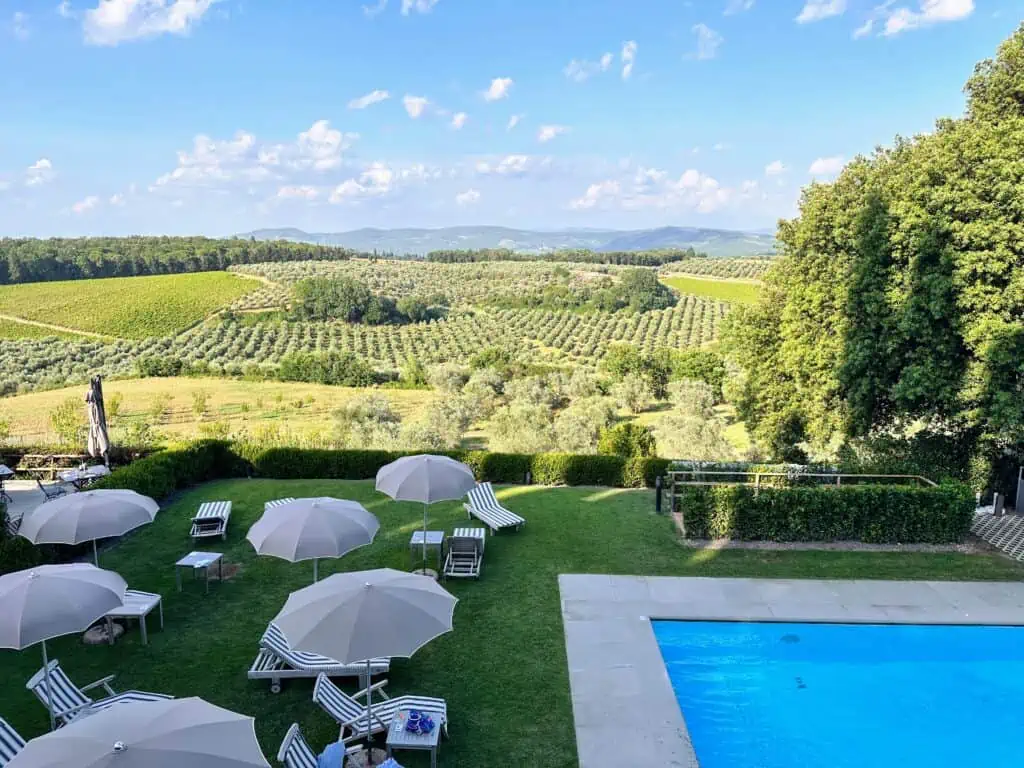
Are you daydreaming of a stay in the Chianti countryside and filling your days with wine tasting, lounging by the pool, and exploring the tiny Chianti villages?
Good To Know: While ‘Chianti’ is a large area, I’m focusing on ‘Chianti Classico,’ a much smaller area – and the zone most people are talking about when they mention ‘Chianti.’
While it’s much easier done with a car, you can manage a Chianti stay without a car. This type of stay is best if you’re planning on having a lot of relaxing/lounging time at your accommodation, punctuated with occasional trips into the countryside. While you’ll be able to use buses, depending on where you stay you may need to hire a taxi or private driver to get you to/from your accommodation. For example, if you decide to stay in one of the villages, you may be able to arrive by bus. But, for countryside agriturismo stays, you’ll need to hire a taxi or driver.
Your day trip transport options in Tuscany vary greatly depending on where you stay in Chianti. For example, if you stay in Castellina in Chianti , it’s easy to take a bus to Siena. Or, if you’re basing yourself in Greve in Chianti, you can easily catch a bus to Florence or Panzano in Chianti.
When thinking about where you can visit without a car:
Train – Don’t plan on utilizing trains if you’re staying in Chianti.
Bus –There is a decent bus system running through Chianti. You’ll find many of
Day Tour – Don’t count on having many private day tour options if you opt for a Chianti stay. Most day tours leave from cities.
Private Driver – Drivers can take you anywhere in Chianti, to villages or other destinations like cooking classes in the Tuscan hills or taking photos of the vendemmia . Or, a driver can take you into other parts of Tuscany.
Helpful Tip: Stay in San Casciano in Val di Pesa. It’s in Chianti and surrounded by beautiful countryside, and you can easily access Florence, Greve in Chianti, Montefioralle , Panzano in Chianti, and wineries like Antinori Chianti Classico.
Val d’Orcia (Countryside)

When you think of cypress-lined drives and rolling green hills, you’re thinking of the Val d’Orcia (in the spring). This UNESCO World Heritage Site in Southern Tuscany is one of the most beautiful places you’ll visit in Italy. In addition to the scenery, you’ll find charming hilltop villages like Montepulciano , Pienza, and Montalcino), excellent wines (like Brunello di Montalcino and Vino Nobile di Montepulciano), and one of our favorite hot springs towns , Bagno Vignoni.
The main differences between Chianti (in northern Tuscany) and Val d’Orcia (in southern Tuscany) are the locations and the scenery – Chianti is more closed with vineyards and forested land, while Val d’Orcia has a more open landscape with velvety rolling hills that change colors through the seasons. Of course, there are vineyards in the wine areas (like around Montepulciano and Montalcino).
Places you can easily visit from Val d’Orcia include:
Train – Don’t plan on using the trains in Val d’Orcia. You will find train service on the outer edges of the area, like in Buonconvento or Montepulciano.
Bus – You can use buses to get around the area. For example, it’s just a 20-minute bus ride between Montepulciano and Pienza… and then another 35 minutes to Bagno Vignoni. If you’re not interested in a private driver, this is the best way to get around the Val d’Orcia.
Private Driver – Anywhere in the Val d’Orcia and Tuscany!
I hope this helps you plan out your travels in Tuscany without a car. Buon viaggio!
You may also want to read about Visiting the Val d’Orcia Most Romantic Places in Tuscany Visiting Bagno Vignoni One Day in Pienza
Tuscany Without a Car FAQ
The UBER that you know and love isn’t available in Italy. You can find versions of it in some larger cities (not Florence ), but in Tuscany, it’s not a good option yet.
While it’s definitely possible to use Pisa as a base for visiting Tuscany without a car (it’s got great train connections), it’s a larger city and there are more charming options that do the job just as well (like Florence or Lucca). Pisa makes for a better day trip (gotta see the Leaning Tower !)
Hitchhiking is not common in Tuscany. I do occasionally see someone people with their thumbs out, but I’m not sure how successful they are. It’s illegal to hitchhike on the Autostrade (toll roads) or their gas stations.
You May Also Like
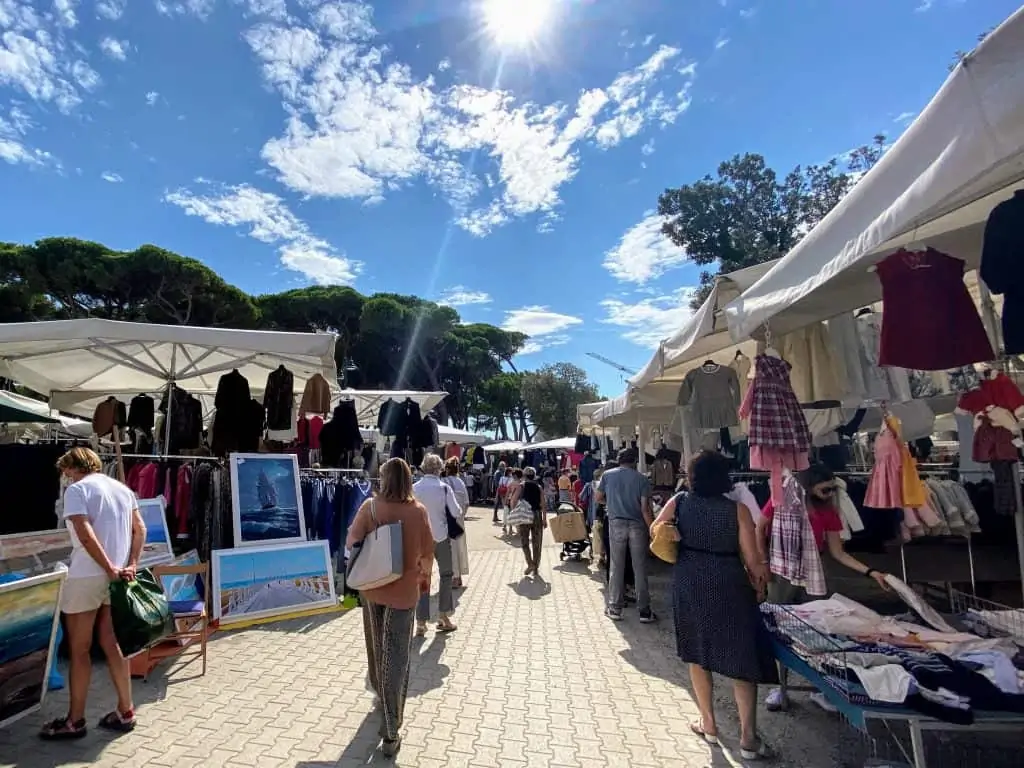
The Market in Forte Dei Marmi – My Top 10 Tips
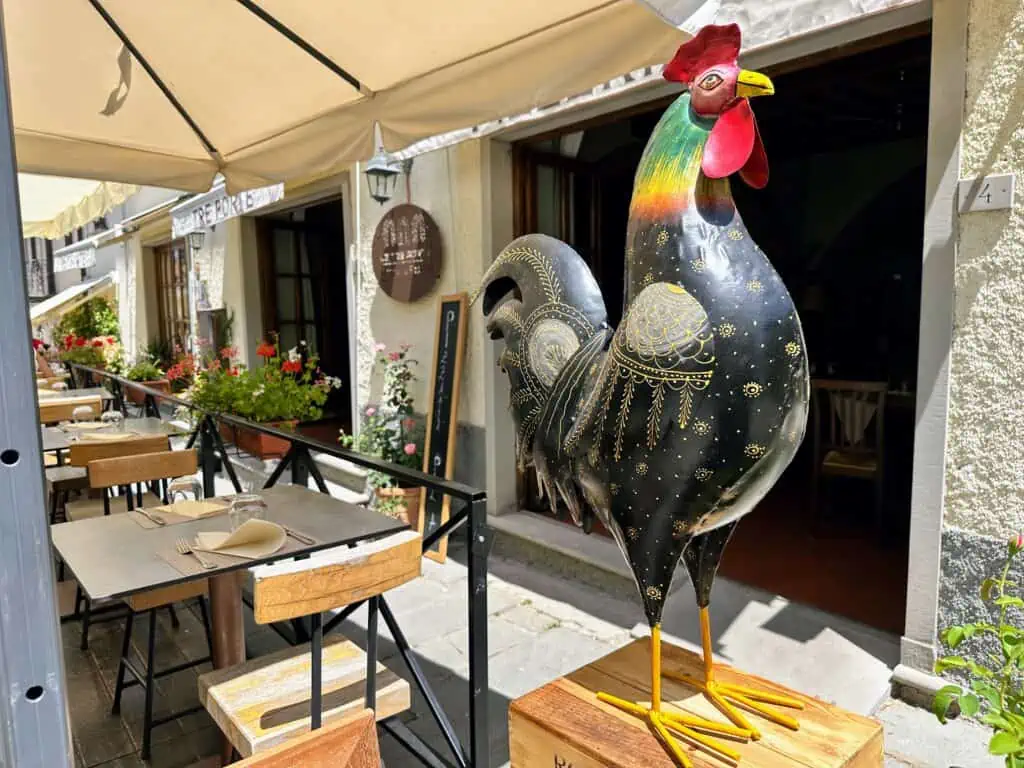
Castellina in Chianti – All You Need to Know for Your 2024 Visit
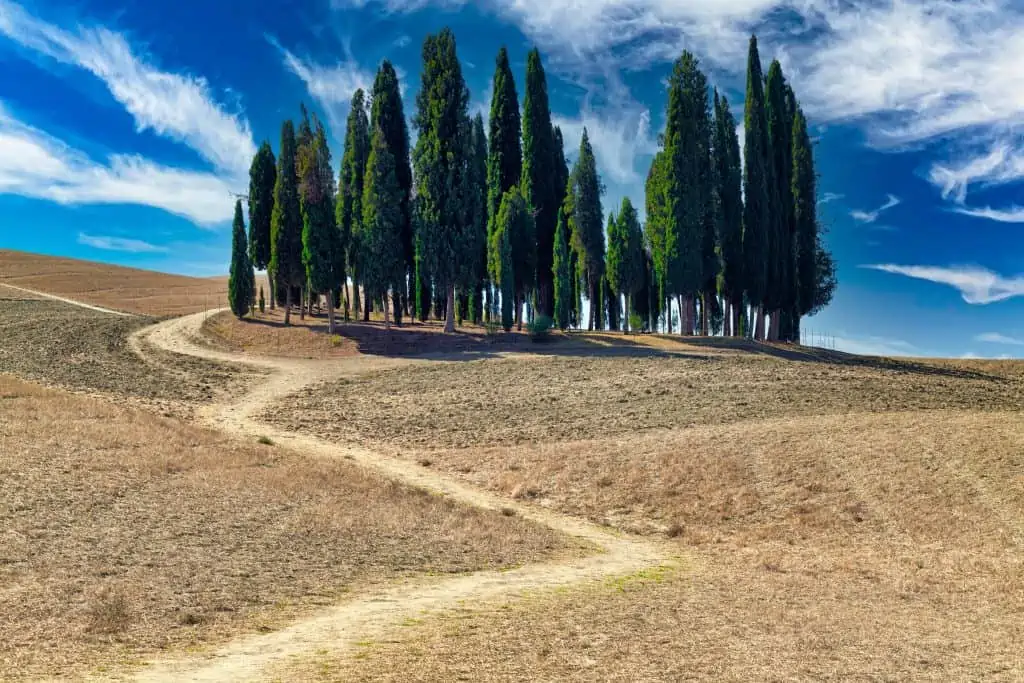
Iconic Trees in Tuscany + Where to Photograph Them
An Italian Mama's Guide to Italy
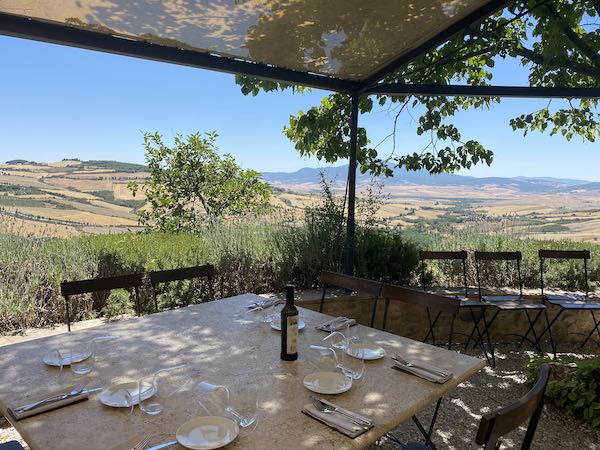
Tuscany without a car: 5 best ways to enjoy one of Italy’s most beautiful region
How to enjoy Tuscany without a car: five great ways to explore Tuscany and all it has to offer, without having to drive.
Tuscany is one of Italy’s most beautiful and popular destinations, an area famous for rolling hills, hilltop villages , and country stays in relaxing, picture-perfect surroundings.
It is at the top of most visitors’ Italy must-see areas and an easy, delightful place to explore slowly.
The best way to explore Tuscany is with your own vehicle.
However, driving in Tuscany is not for everyone, so while I strongly recommend getting your own car, today I want to share some tried and tested, fun ways to explore Tuscany without one!
In particular, we are going to look at the following:
- Challenges for visitors who do not drive
- Using taxis in Tuscany
- How to enjoy Tuscany by rain
- How to Enjoy Tuscany by bus (public service)
- Tuscany day tours
- Tuscany drivers for ad hoc transfer services
- The best places to see in Tuscany without a car
I hope this guide helps you find good ways to enjoy it!
Good to know: I have written this guide, like all other guides on this website, based on my experience and travels. I am Italian and have been going to Tuscany all my life for vacation, work and to visit family (my dad’s side of the family is from Florence). All tips on this page come from what I learned while planning my own trips.
Please note: this post contains affiliate links. Should you make a purchase through them, we might make a small commission at no extra cost to you.
Visiting Tuscany without a car: challenges
Tuscany is a large region with beautiful towns, extensive rural areas and a long coastline.
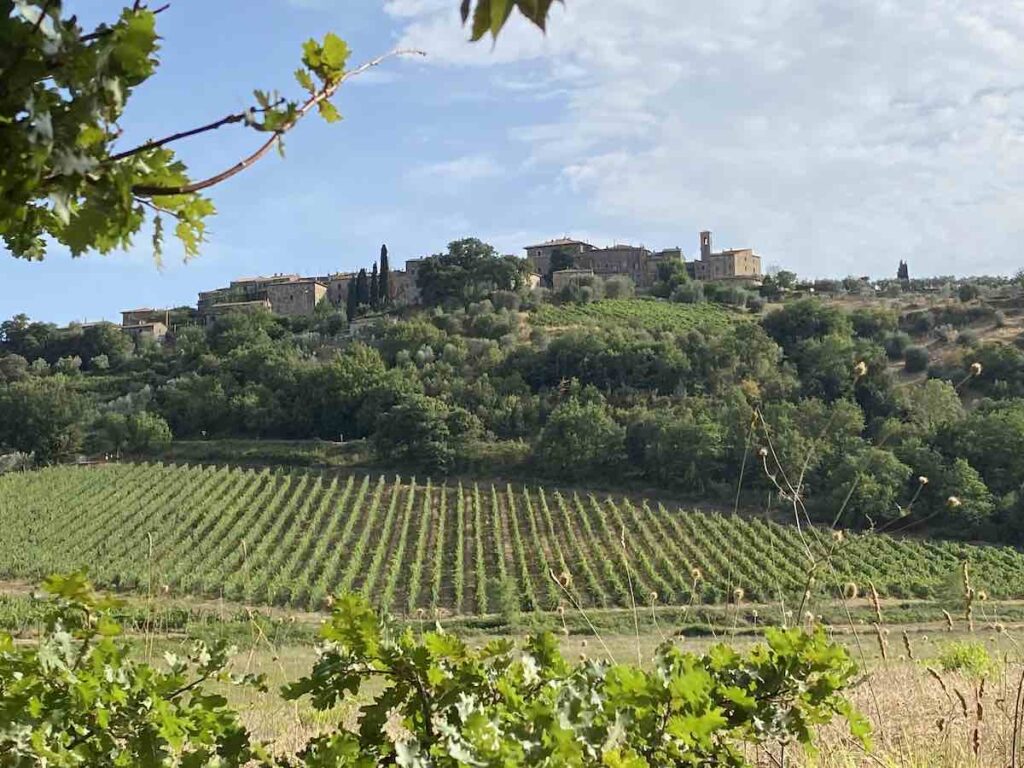
The main challenges you’ll encounter for car-free vacation in Tuscany are:
- Not all towns in Tuscany are served by train and not all those that have a station have accommodation nearby or a local transport network allowing for local sightseeing.
So while it is possible to get to many places by train, you may then find yourself anyway in need of a car for local tours.
- Country stays, Agriturismo, villas and Wineries are usually not served by public transport and usually not within a walkable distance of the train station or bus stop.
- Taxis are costly and may not be easy to get in remote country locations and isolated properties.
All this means that, when picking a place to stay, you need to consider how to get there, but also how you will explore locally.
In many cases, even agriturismos very close to a town are not at a walkable distance from it and may require the use of a car: unless they specify you can walk into the nearby town, always assume you won’t be able to get there without your own transport.
I highly recommend you plan your transport and accommodation simultaneously: sourcing a local driver afterward may prove difficult or prohibitively expensive.
Using taxis in Tuscany
Taxis exist in Tuscany but they are not always what you need to solve your Tuscany transport needs.
You can catch taxis in Tuscany cities, usually by going to a taxi stand or by ringing them on the phone.
Taxi apps do not work in the Tuscany countryside at present.
Taxis serve metropolitan areas and may be available for longer stretches.
However, taxis in Tuscany and Italy, in general, are not a good option for long-distance journeys.
While they are excellent for inner city stretches, their price goes up as soon as you leave the perimeters of the municipality and even a short out-of-town journey can easily set you back hundreds of Euro.
They may also be very hard to get in more remote locations and if you don’t have Italian, it can get even more difficult as getting one may require a phone call.
So while getting a taxi to reach your accommodation in the countryside is possible as a one-off, taxis are usually not a viable option for regular transport needs unless your budget is limitless.
Better solutions are below!
Using Uber in Tuscany
Uber does not operate in Tuscany at present. However, a limited uber service is available in Florence city, in the form of Uber Black.
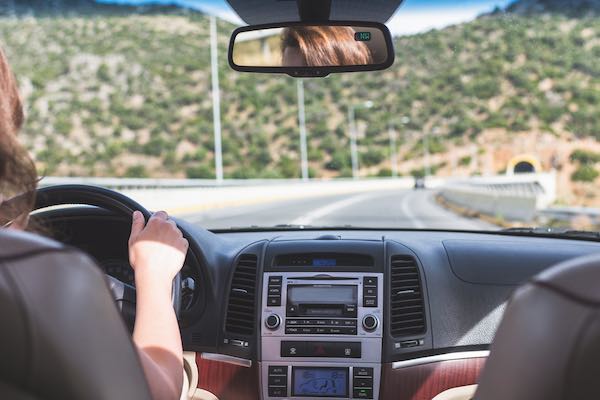
Using private drivers in Tuscany
If staying in the middle of the country, a better option than taxis and Uber is to get a local driver or transfer service.
The best and most convenient drivers are usually found locally.
I recommend asking your potential host if they can recommend someone and make a deal with them directly.
These are usually the people who know the area best, have the shortest to drive to come get you (hence the cost will be lower) and are often able to suggest hidden gems and scenic roads you may otherwise miss.
When sourcing a local driver, please check they are insured and match all the necessary legal and safety requirements. In Italia, the acronym for drivers’ services is NCC = Noleggio Con Conducente.
Another good option is to contact companies specializing in transport and taxi service.
Some reliable ones I have come across in my research are:
- Welcome Pickups – this company operates in most of the country and offers arrival transfers from train stations, airports etc, but also ad-hoc transport services. They have English-speaking drivers, can provide children car seats and they can also offer sightseeing services in addition to simple transfers.
- Mydaytrip – this is a company I have seen recommended more and more lately by readers of this website who told me about their positive experiences with them. Clients reported they have nice vehicles, children’s car seats and good guides.
Exploring Tuscany by train
Tuscany has a good network of trains serving several locations on the coast and towns inland.
Some towns such as Florence, Pisa and Lucca are great as a destination and also as a base for train day trips.

Others such as Siena, Cortona or many of the coast’s localities are reachable by train but are surrounded by countryside best explored by car.
So when you are looking at a town to make your home base, please don’t just check how to get there but also how you can move locally or may find yourself limited in what you can do
The best towns to use as a home base if planning on exclusively using the train in Tuscany are:
- Florence, close to Chianti and several other small towns, as well as a stunning art city
- Lucca old town, is especially suitable for families with young kids (see below).
- Pisa, suitable for people who want a more local experience (see below)
- Viareggio / Forte dei Marmi, good beach towns on the train line between Rome and La Spezia (Cinque Terre)
The best website to get tickets for train travel in Tuscany, both high-speed and regional, is trenitalia.com
You can find here >>> our guide to train travel in Italy
Exploring Tuscany by bus
Local buses are a fast and efficient way to explore Tuscany towns that are not on the train line.
There are several bus companies serving the region, all with buses of a decent standard and reasonable prices.
I usually look on Google Maps or Rome to Rio to get an overview of the options available for the specific journey I need.
Buses are invaluable in reaching many hilltop towns and smaller villages that either do not have a train station or have a very limited train schedule.
Buses cover almost all towns in Tuscany, especially if you are in Florence, which is a great train and bus hub as well as a wonderful destination in itself.

In most cases, buses run regularly between big cities and smaller centers and fewer regulars between one small center and another.
If you visit Tuscany by bus, I highly recommend you use Florence as a base and plan day trips from there.
Need to know! Buses are great for reaching villages, towns and some landmarks; however, they are often not a viable option to reach Agriturismo or isolated Airbnb in the countryside. If you are looking at that type of accommodation, I recommend you contact your local host to make sure there is a bus stop where you are staying and the schedule is reliable and satisfactory for your needs.
Tuscany by organized day tours
One of the easiest and stress-free ways to experience Tuscany without a car is to join a day tour.
Day tours come at all costs and sizes and cover many destinations: group ones tend to cover the most requested destinations and tend to depart from a limited number of popular departure towns.
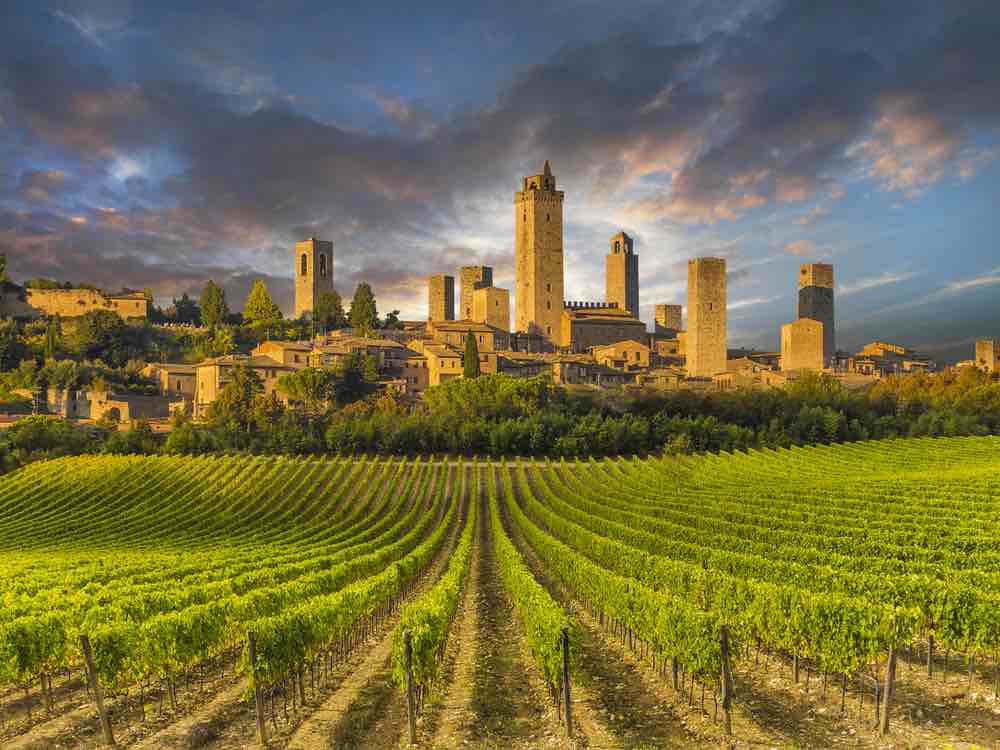
Private ones offer more flexibility and, if you are traveling with kids, offer the advantage of car seats. They do, however, have a much higher cost.
Good to know: many of the small towns in Tuscany are swamped with day trippers, and if you go with a big group tour, you may find it very hard, if not impossible, to lose the crowds. I personally recommend opting for a DIY trip by train or bus if on a budget, or for a private tour, as the best ways to minimize the crowded feeling.
Tuscany tours and day trips I recommend are:
Private Chianti Tour by LivTour – this is a wonderful, half-day (6h) private experience with a private driver who leads you to explore two wineries in one of the best wine regions in Italy and the world.
Chianti is a beautiful area, with beautiful hills, medieval towns and one of the places people think of when they think of quintessential Tuscany. The tour can be tailored to your needs and it is family-friendly.
All info here >>> Chianti private tour by car (day trip)
Tuscany countryside experience with cooking – this is not a tour but a wonderful day out in the country suitable for anyone who wants to spend a relaxing day in the Tuscan countryside and also learn how to cook a real Italian meal.
The day is great for all types of travelers, including families with kids and comes with an extra plus: the option of using the estate’s swimming pool, a lifesaver during Tuscany’s hot summers! Find info >>> here <<<
The best places to stay in Tuscany without a car
Florence .
Florence is one of the easiest places to visit in Tuscany without a car and a great base for day trips.
Fast and comfortable high-speed trains connect the city to Rome, Venice, Bologna, Milan and all main Italian cities.
In addition, a well-functioning network of local trains and buses connects it with towns such as Lucca, Pisa, San Gimignano, Siena and many more.
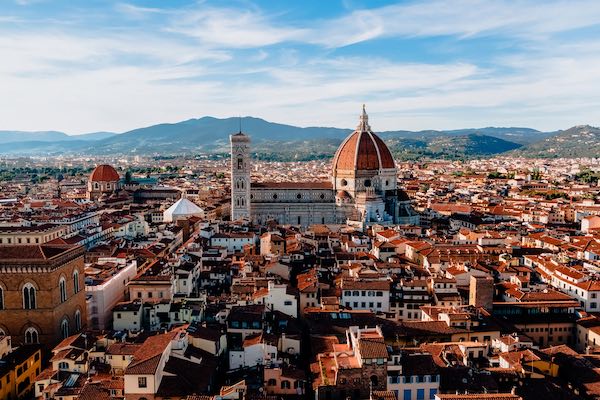
The main station in Florence is called Firenze Santa Maria Novella and it is in the city center. Florence is easy to visit on foot and perfectly located to arrange day trips to the country by bus or train.
If you are looking at visiting Tuscany without a car, Florence is a fantastic base!
Travel guides to the area you may enjoy:
- 24 Top things to see and do in Florence
- The best day trips from Florence
- Visiting Florence with kids
Lucca
Lucca is a delightful small town in Northern Tuscany, famous for its many churches, a walkable town center and wonderfully preserved medieval walls surrounding the city.
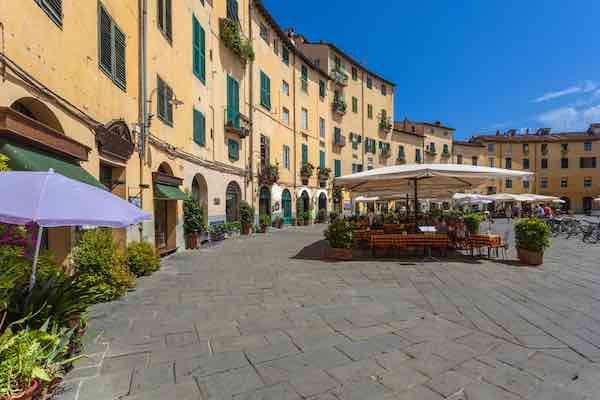
Lucca is a great base to visit in northern Tuscany if you have kids in particular since it is a fantastic small town for families.
You can easily reach Lucca from Florence and you can use it as a base to explore Pisa and the beautiful beaches of Versilia.
Please note: if you are staying outside of the town center, you may need to get taxis of local transport to reach your Agriturismo. If you are in town, the old center is all walkable.
Travel guides to the areas you may enjoy are:
- The best beaches near Lucca
- Visiting Lucca with kids
- What to see in Lucca in a day
Pisa is one of the famous destinations in Tuscany, usually visited for its astounding tower and surrounding piazza, piazza dei Miracoli.
Psa is a town with a long history but suffered greatly during the war and lost part of its center to air strikes.
Because of this, while it is a stunning city to visit for day or so, it is rarely chosen as a base to discover the area, its modern feel not matching what most visitors look for when planning a stay in Tuscany.
However, Pisa is one of the best places to visit in Tuscany without a car as it is a walkable town, it is one train line and on well connected to Rome, Florence, Lucca and Cinque Terre.
Outside of the main piazza, Piazza dei Miracoli, Pisa is a local town where you can feel like a local (visitors hardly ever leave the area of the square, the rest of the town is much quieter!)

Viareggio
Viareggio is a beautiful seaside town in the north of Tuscany blessed with large sandy beaches and views of the mountains as a backdrop.
Viareggio is well connected by train to Rome, Lucca, Florence, Pisa and Cinque Terre and a good place to use as a base in summer if you want a beach location but also the option of the occasional day trip by train.
Viareggio is one of the best beaches near Florence.
Visiting Tuscany to visit without a car: summary
In my opinion, the five best ways to explore Tuscany without a car are:
- Using the train, using Florence Pisa or Lucca as a bases
- Using local buses, especially using Florence as a hub – best budget option
- Hiring a private driver for ad-hoc transfers – highest budget option
- Staying in Florence and taking a private tour of Chianti
- Staying in Florence and spending the day in Tenuta Chiudendone
These last two tours are fantastic for experiencing the Tuscany countryside in a day, without the stress of driving.
I hope you found this overview useful and it helped you plan your stay. Safe travels!
If you want even more help or you have any questions, please in my FREE Facebook group about traveling to Italy with kids: I will be happy to have you there and the tips from me and the other members are FREE!
Marta Correale
Marta Correale is an Italian mama of two. Born and raised in Rome, Marta has a passion for travel and especially enjoys showing off Italy to her kids, who are growing up to love it as much as she does! A classics graduate, teacher of Italian as a second language and family travel blogger, Marta launched Mama Loves Italy as a way to inspire, support and help curious visitors to make the most of a trip to Italy and learn about Italian culture on the way.

You May Also Like
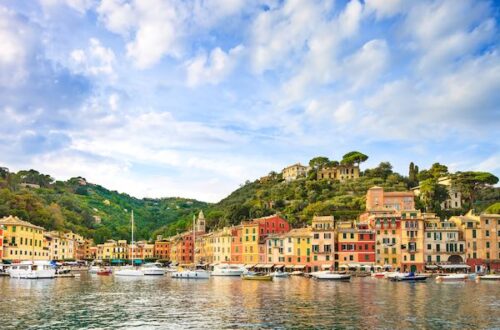
One week in Italy itinerary ideas for families: how to spend 7 days in Italy

Beach clubs in Italy: how they work + all you need to know to book a spot

Tipping in Italy: all you need to know
Privacy overview.
Getting Around
How can i travel in (and to) tuscany without a car.
By Italy Genius
August 4, 2021
You cannot claim you have been to Italy until you have experienced Tuscany! From the wealth of Renaissance art, culture and architecture to the breath-taking landscapes, villages and vineyards. Out of all the regions in Italy, Tuscany will undoubtedly be the one to steal a ‘ pizza your heart’ .
Whether you are a local or tourist, you are able to travel in (and to) Tuscany without a car. Italy has incredible and affordable public transport. As Tuscany is one of the most popular tourist destinations, you can easily visit all of the towns and main attractions by bus, Vespa, bicycle or train.
If you are planning a trip to Tuscany without a car and don’t know where to start, consider the following tips and suggestions from experienced travelers to make your journey a simple, efficient and truly memorable one!
How Do I Travel to Tuscany Without a Car?
If you are a foreign tourist, you will most likely land at one of Italy’s major airports – Fiumicino in Rome or Malpensa in Milan. You will need to make your way to the Tuscany region from either one of these airports.
Here are a few viable suggestions:
- Make Florence the Base for Your Stay In Tuscany
- As you will be depending on public transportation during your stay in Tuscany , Florence would make the perfect base to begin and end your trip . This is the most straightforward way to arrive from and return to Rome or Milan.
It is also easier to travel from Florence to the other regions of Italy.
- Florence is the headquarters of Tuscany, with an airport and bus or train connections to all of the other popular Tuscan attractions and towns.
How To Get from Fiumicino Airport (Rome) or Malpensa Airport (Milan) to Florence
- Fiumicino to Florence:
- A flight from Fiumicino to Florence Airport will only take around 1 hour and 15 minutes.
Click on the link below to view flights and pricing:
- You will then take a taxi or shuttle bus to reach your accommodation, most likely in the city center (around 15 minutes travel time).
Click on the link below to view taxi and shuttle options:
It is not feasible to fly from Malpensa to Florence, as there are no direct flights and it will cost considerably more than a bus or train trip.
- Fiumicino to Florence:
– Le Frecce High-Speed Train will take around 2 hours to get to Florence.
– The Leonardo Express Train includes a connecting train, and the total travel time is 2 hours and 20 minutes.
Click on the link below to view train options:
- Malpensa to Florence:
– As there are no direct trains to Florence, you will need to catch a connecting train:
a) Take the Malpensa Express shuttle to Milan Train Station (50 minutes).
b) The high-speed Alta Velocita will be your connecting train which will take 1 hour and 40 minutes to reach Florence.
Arrival at the Florence train station:
Florence Santa Maria Novella Station is right in the city center. You will easily find a taxi or shuttle to your accommodation.
Click on the link to view transfer options from the train station to your hotel:
- Depending on the bus route, travel time is approximately 3 to 4 hours long.
View the Fiumicino Express Bus Schedule below:
- Travel duration can range from 4 to 6 hours.
View the timetable for the Malpensa Express Bus below:
Arrival in Florence:
The bus will arrive in the city center , with simple access to your accommodation via taxi or shuttle.
How Do I Travel In And Around Tuscany Without A Car?
You have sorted out the logistics for traveling to Tuscany without a car – the next step is to strategize how to travel in and around Tuscany without one!
Here is a feasible plan that eliminates most of the guesswork:
- Book accommodation in Florence for the entire length of your visit to Tuscany.
Travel experts recommend that you base yourself in Florence for the entire visit to Tuscany. Florence is the prime hub for business and transportation in Tuscany, which means that you will have easy access to public transportation and many guided tour options.
You can rely on the abundance of public transport and guided tours available to help you reach every corner of Tuscany!
The major benefits of setting up base in Florence:
- You do not need to waste precious time checking in and out of various hotels/ accommodations throughout your stay.
- Your luggage remains in one place for the entire stay – this eliminates potential security and logistical issues. You can save your energy for all the exploring instead of hauling heavy bags up and down!
- There are far more transportation options and guided tours based in Florence compared to the rest of Tuscany.
- Arrival from and departure to the international airports is quick and straightforward.
Traveller Tip:
Where is the best place to stay in Florence?
Remember that you will be without a car – locate and book accommodation where you will be able to access public transport, restaurants, info centers and other facilities hassle-free.
Accommodation in the City Center of Florence is highly recommended because you will be in walking distance to most of the museums, churches, monuments and other main points of interest.
Consider booking lodging in Piazza Della Signoria or Piazza Del Duomo . These are the two major squares in the heart of Florence.
Because the town is fairly small, exploring most of Florence by foot is definitely possible . Walking will allow for a more wholesome experience of the city.
- Plan day trips.
Basing yourself in Florence means that you can plan numerous day trips to most of Tuscany’s beautiful attractions . You will be surprised to discover just how much you can see and explore in a single day!
Travel Options for Day Trips and Exploration:
- Public Transport
Locals and seasoned travelers agree that a car is not essential for travelling in and around Tuscany. Trains, buses, taxis and shuttles are available around the clock. They will get you to the doorstep of all the major sites and attractions.
- Walk or Cycle
Trains and buses come in handy for reaching distant locations, but once you arrive at your destination, you can go on your own adventure on foot or by bicycle . Walking or cycling enables you to see and encounter a lot more .
Most Italian streets are extremely narrow – unlike other modes of transport, walking or cycling won’t restrict your ability to reach all of the attractions, discover hidden gems and immerse yourself in the culture.
- Car or Vespa Rentals
If you are not keen on public transportation and bigger crowds, you have the option of renting a car or Vespa for the day (or longer). This option does allow for more flexibility and independence.
Lonelyplanet.com has a very informative post on car and motorcycle rentals, rules and regulations:
Popular Car Rental Companies in Italy
Avis – www.avisautonoleggio.it
Europcar – www.europcar.it
Italy By Car – www.italybycar.it
Florence Vespa Rentals:
The Top Day Trips in Tuscany
Historic towns, picturesque landscapes and vineyards, quaint villages, magnificent art, churches and architecture… experience the very best of Tuscany in a matter of days – no car necessary!
- Siena – a Medieval Experience
Best mode of transport : Bus
Travel time: 1hr 20min
Highlights:
– Duomo di Siena
– Piazza del Campo
– Cathedral of Santa Maria Assunta
– Palazzo Pubblico
- Pisa – Lively Atmosphere and Magnificent Architecture
Best mode of transport: Train
Travel Time: between 50 mins to 1hr 20mins (depending on train route)
Highlights:
- Leaning Tower of Pisa
- The Square of Miracles
- Church of San Nicola
- The River Arno
- Lucca – a Charming City Rich in History
Travel Time: 1hr 20min
- Lucca Cathedral
- The Town Walls
- Guinigi Tower
- San Michele in Foro
- Roman Amphitheater
- Chianti – Wine and Dine with a View
Best mode of transport : Bus
Travel Time: 1 hour
- Montefioralle
- Vineyards and Wine Tasting
- Stunning landscapes
- Florence – Tuscan Culture, Renaissance Art and Architecture
Best mode of transport: Walking or Bus
Travel Time: 10 mins or more (Depending on your accommodation)
- Cathedral of Santa Maria del Fiore
- Uffizi Palace and Gallery
- Palazzo Vecchio
- Ponte Vecchio
- Santa Croce
Top-Rated Guided Tours in Tuscany
Guided tours and private excursions are extremely popular and highly recommended when visiting a foreign country. Tourists have peace of mind because they have the opportunity to travel easily and safely.
Click on the links below for more information about each tour.
- Florence Hop-On-Hop-Off tour bus
- Pisa, Siena and San Gimignano Day Trip from Florence (Includes Lunch and Wine Tasting)
- Tuscany in a Day: Siena, San Gimignano and Chianti (Includes Lunch and Wine Tasting)
- Tuscany Bicycle Tours
Tuscany & Umbria
The Top 3 Benefits of Guided Tours
- Informative : gain more insight and learn interesting facts about the local culture and history.
- Convenience : your transport and itinerary are already planned and sorted! On most occasions, people doing guided tours get to skip the queue and have VIP access to all of the sites.
- Complete experience and relaxation : you will be able to relax and enjoy a more memorable experience as a passenger. You won’t miss out on the breath-taking views along the journey.
A Summary Of How To Travel In and To Tuscany Without A Car
- Make Florence the base for your stay in Tuscany. (Book accommodation in the City Center).
- Book a train, plane or bus ride from Fiumicino or Malpensa international airport to Florence.
- Plan day trips and make use of public transport options (train or bus).
- Consider renting a Vespa or bicycle for the day.
- Take advantage of the many guided tour options available.
Traveling in (and to) Tuscany without a car has been proven to be both possible and preferable. Avoid the red tape, hassle and difficulties of driving in a foreign country and embrace the opportunity of having a more intimate, laid-back and wholesome Tuscan experience.
How to Rent a Car in Italy (the right way)
Best restaurants on the amalfi coast (with a view), 1 thought on “how can i travel in (and to) tuscany without a car”.
We are in Tuscany right now. Staying three days at a beautiful spa resort in Radda. Arrived from Florence with a driver only to find there is no transport to see the sites. Only two public buses 6am or 3pm! No taxis available, they come from Florence or Siena… so very scarce! If we had of known we would have stayed in Siena.
Leave a Comment Cancel reply
Save my name, email, and website in this browser for the next time I comment.

Getting Around Tuscany Without a Car: All You Need to Know!
Get the lowdown on getting around Tuscany without a car, from how to do it to the best places to stay.
I’m not going to dress it up. In terms of convenience, flexibility and accessibility, it’s hard to beat exploring Tuscany by car. However, this is not for everyone and is certainly not for me.
The good news is that getting around Tuscany by public transport is easy, affordable, reaches the region’s main attractions and is user-friendly. And for the places that are more challenging to visit, there are always day tours or private drivers.
The key is knowing how to do it and identifying the best places to stay in Tuscany without a car.
Leave your driver’s licence at home and start planning with this guide to a car-free visit to one of Italy’s most enchanting regions.

Some articles on this website contain affiliate links. This means that I may earn a small commission if you make a purchase through these links. As an Amazon Associate, I earn from qualifying purchases . Read the full disclosure here .
TUSCANY WITHOUT A CAR AT A GLANCE
How to get around Tuscany without a car
- Taxi / private driver
Where to stay in Tuscany without a car
- First choice: Florence
- Good alternatives: Siena, Pisa, Lucca, Viareggio
Recommended day tours
Tuscany Day Trip with Lunch at a Chianti winery
Chianti and Castles Tour with Wine Tastings
Best of Tuscany tour from Florence
Is a Car Necessary in Tuscany?
You do not need a car if your itinerary is confined to the major Tuscan towns and cities. However, a car is convenient to experience the rolling landscapes and vineyards for which the region is famous. Convenient, yes. But not essential. Buses and trains serve most places in Tuscany and for the rest, there is a good choice of day tours from the main hubs. Having a car in Tuscany’s towns and cities is of little value. Driving in the historical centre of many towns, including Florence and Siena, is either prohibited or restricted. Finding a legal parking spot can be challenging and it may cost a premium to park near your hotel or apartment. For me, one of the biggest disadvantages of not driving is that it puts a quintessential Tuscan experience out of reach. Staying in an agriturismo is still on my Italy bucket list. However, unsurprisingly, these are usually not close to a town and not served by public transport. Although this is also the case with wineries , you can usually pick up a day tour if a vineyard visit is on your agenda.

Getting Around Tuscany Without a Car
Broadly speaking there are four ways of getting around Tuscany without a car:
- On a day tour
- By taxi / private driver
Over the years, I have tried all of these transport options.
Exploring Tuscany by Train

All of Tuscany’s cities and major towns, not to mention some of its smaller towns, are connected by rail. For example; Pisa, Lucca and Siena all have direct rail connections to Florence, meaning you can visit them as day trips
When planning your car-free Tuscany itinerary, the rail network map and train timetables are your best friends. There are two rail companies in Italy : Trenitalia and Italo.
The state-owned Trenitalia is your best bet for getting around Tuscany by train. You can check train times here . For planning on the go and to book and download your ticket, grab the Trenitalia app here .
Most of your train travel in Tuscany will be on the regional services. There is no advantage in booking your ticket in advance. The ticket price is fixed and as a reservation is not necessary – or even possible – the train can never ‘sell out’.
Booking your ticket in advance is advisable for the high-speed Frecciarossa, Frecciargento, Frecciabianca & InterCity services.
Italo has cherry-picked the most lucrative Italian train routes. However, in my experience, it is of limited value when travelling in Tuscany.
Although Italo is a useful option for getting to and from Florence – I have used it for getting from Rome to Florence – it does not serve other stations in Tuscany.
Exploring Tuscany by Bus
For the parts of Tuscany that trains do not reach, there is usually a bus. They are especially useful for reaching most of the region’s hilltop towns – Montepulciano and Volterra, for example –and its smaller towns and villages.

Identifying bus routes in Tuscany can be challenging. Several bus companies move people around the region and your best bet is to use Google Maps , Omio or RometoRio to identify your options.
Fares are based on the distance travelled and it can be cheaper to buy your tickets in advance.
Florence is the best place to base yourself if you plan to travel around Tuscany by bus. Many of the bus companies use Florence as their hub and the services stop close to Firenze Santa Maria Novella, Florence’s main train station.
Day Tours of Tuscany
Even as an independent traveller, I am a huge fan of day tours.
Not only do they get you to places that are difficult to reach but you also benefit from the knowledge of a guide. A day tour allows you to squeeze more than one place into your day’s itinerary and there’s much to be said for letting someone else take care of the arrangements for you.
Day excursions are a stress-free way of exploring Tuscany’s cypress tree-studded landscape and visiting its many vineyards.
Here are a few examples of day tours that would fit the bill:
This tour from Florence packs a lot into one day. There’s a guided tour of Siena, free time in San Gimignano and Pisa, and lunch and wine tasting at a vineyard in the Chianti hills.
>>> CLICK HERE TO FIND OUT MORE
This half-day tour from Siena visits two wineries and makes several stops, including Castellina in Chianti. I like that one of the wineries visited is exclusive to this tour company.
There are day tours to fit every traveller, from coach tours to a more bespoke experience with a smaller group. My go-to platform for sourcing and booking day excursions is GetYourGuide which usually offers the reassurance of free cancellation within 24 hours of your tour should your plans change.
I avoid the larger groups and usually opt for a minibus-sized group at the largest. This is a popular tourist destination and you won’t want to be more lost in the crowd than you need to be.
Exploring Tuscany with a Private Driver
For a completely bespoke experience, you can hire a private driver. Of course, a private guide is not cheap, but if there are a few of you this may not be much more expensive than joining a group tour.
This does pretty much what it says on the tin. Pisa, San Gimignano, Siena, Monteriggioni and Chianti.
Chianti Wine Paradise Tour
The title says it all. This 7-hour tour in the heart of Chianti includes tasting the region’s delicious wines.
If you want to stay in a more remote corner of Tuscany without a car – perhaps that agriturismo – using a local driver is another option. This is where local knowledge is your best tool and I suggest asking your host who they would recommend.
Currently, Uber and Lyft do not operate in Tuscany.

Best Places to Stay in Tuscany Without a Car
Choosing the right base is the key to a successful car-free holiday in Tuscany. Pick a base and stick with it. Vacation time is too precious to waste on changing accommodation every one or two days.
If you stay in one of the larger towns in Tuscany, you can use this as a base to visit other cities, towns and villages by public transport on day trips.
Florence is the best place to stay in Tuscany without a car

Florence is the region’s most important transport hub with frequent trains and buses to all of the best bits of Tuscany, including the great cities of Siena and Pisa as well the smaller gems of Lucca and Arezzo . You can even visit Venice from Florence , or Rome for that matter.
Firenze Santa Maria Novella train station is an easy ten-minute walk from the city’s historic centre, and Florence has accommodation to suit every budget .
Florence is one of the most attractive and alluring cities on the planet. From the masterpieces of the Uffizi Galleries to the sculptures of Michelangelo , it has a wealth of artistic treasures that are hard to equal.

Other places to stay to explore Tuscany without a car
If you are a return visitor, you may want to consider other places to stay in Tuscany.

Florence’s erstwhile Tuscan rival is known for its striking striped Duomo and magnificent shell-shaped Il Campo. This is the setting for the world-famous Palio horse race. Siena is a good base for exploring southern Tuscany by public transport. The city centre is a 20-minute uphill walk from its train station.

Although most people visit Pisa to snap a shot of them holding up its tipsy tower, it is much more than this. This historic city is home to many architectural treasures and outside of the tourist-clogged central zone feels like an authentic Tuscan city. Pisa is close to a major airport and is an important rail hub, connected to Rome, Florence, Lucca and the Cinque Terre. Walking from Pisa train station to the Leaning Tower will take you around 20 minutes.

Lovely Lucca is one of my favourite towns in Tuscany and is a good base for visiting the north of the region. This picturesque fortress city is enclosed by one of the longest intact walls in Europe. Lucca’s train station is a ten-minute walk from the city centre.

This charming seaside town has good rail connections to Florence, Pisa, Lucca and the Cinque Terre. It’s an excellent choice if you want to inject some beach time into your Tuscany trip. It will take you around 20 minutes to walk from Viarregio train station to the town centre.
Tips for Visiting Tuscany Without a Car
I have travelled around Tuscany without a car on multiple occasions. It is easy but there are two caveats:
#1 Pick the right base for your itinerary (but you can’t go far wrong with Florence)
#2 Sketch out an itinerary and, with the help of a timetable and online journey planners, figure out where it will be useful to join a day tour or hire a private driver. To avoid disappointment, organise these before you arrive in Italy.
There is one other option for a stress-free way of visiting multiple destinations in Tuscany.
Small group tours of a week or more can be an excellent way of getting under the skin of a country and offering experiences that would be otherwise hard to come by. For example; well-travelled friends have recommended this walking and wine tour of Southern Tuscany . It would work for me!
Plan Your Car-Free Holiday in Tuscany
I hope this article gives you some pointers on exploring Tuscany without a car. If you have found it useful and need some more information or inspiration to plan your trip to this gorgeous region of Italy , take a look at a few of my other guides:
- How to Take a Florence to Lucca Day Trip
- How to Do a Florence to Arezzo Day Trip by Train
- An Easy Day Trip from Florence to Venice by Train
- Where to Stay in Florence, Italy: The 7 Best Areas
Happy travels!

Bridget Coleman is an award-winning travel blogger who is an incurable Italy addict and has travelled its length & breadth on multiple occasions. Find out more here . To get in touch, email her at [email protected]

Travel tips and inspiration for fun and authentic adventures abroad
Italy , Dolomites , Guide
The ultimate guide to visiting the dolomites without a car.
- July 23, 2023
Table of Contents
The Dolomites is one of those places that just doesn’t feel real.
Rolling meadows decorated with colourful wildflowers nestled between hillsides covered in thickets of trees, all culminating in gigantic rocky peaks jutting out into the heavens… it feels like stepping into a fairytale.
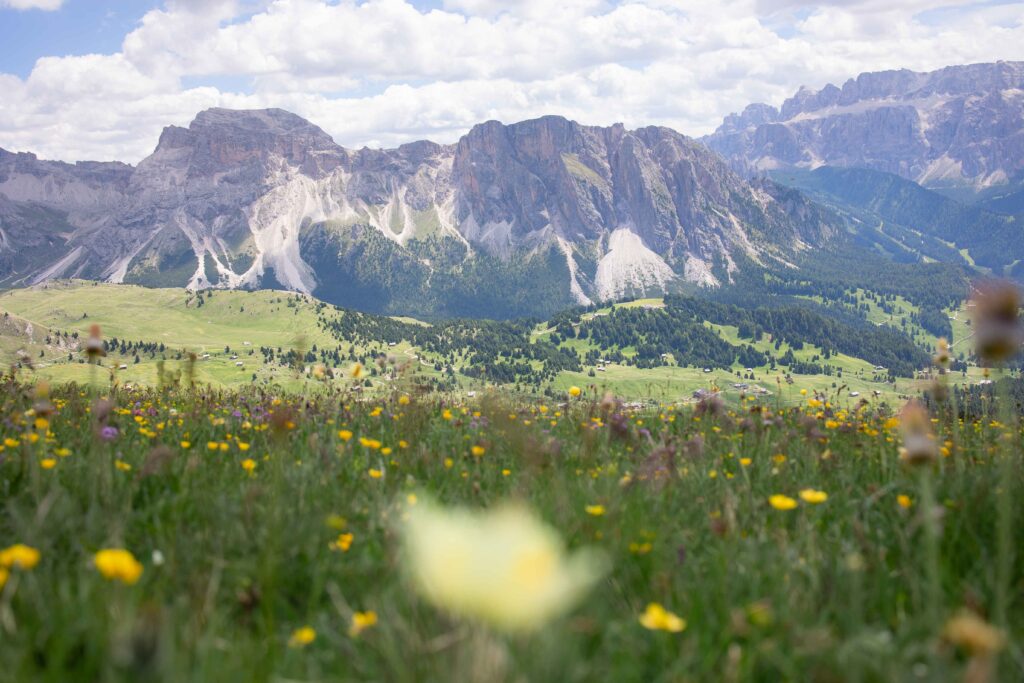
I’m lucky to have spent 9 blissful days there, and have documented my best advice on how to experience the magic of this special place, all without a car. So, if you’re on the fence, I’m here to tell you that it’s easy and absolutely worth it!
Backstory: Huzai and I originally intended to rent a car, but when we went to book one (albeit very last minute), we found that there were only a handful of overpriced options available. We decided to try it without a car, and needless to say, we’re so glad that we did!
This guide covers all the essential things you need to know before you start planning your first (or perhaps even second) trip to the Dolomites : where the Dolomites are and which towns are best to base yourself in without a car, how to get to the Dolomites without a car, advice on finding your accommodation, when the best time of year is to visit, a perfectly crafted 5 day itinerary for visiting in the summer, how to get around to various hikes and attractions without a car, and tips on what to eat and drink while you’re there.
I hope you find this guide useful and would love for you share your thoughts in the comments at the end!
1. What / where are the Dolomites
The Dolomites is a mountain range in the north eastern Italian Alps, with 18 peaks rising above 3000 metres. It is protected as a UNESCO world heritage site for the aesthetic value of its beautiful landscape and the scientific importance of its geology.
Though the Dolomites is technically part of the Alps mountain range, it is quite distinct in its appearance. The peaks tend to look more rugged, and at dawn and dusk they exude a pinkish glow due to the large amount of dolomite mineral found in their rocky walls . In Italian, this phenomenon is lovingly referred to as Enrosadira.
The protected mountain range covers more than 140 thousand hectares that sprawl across three distinct regions of Italy (Veneto, Trentino-Alto Adige / South Tyrol (Südtirol), and Friuli Venezia Giulia). The Dolomites only recently became Italian during WWI , when the Italians annexed the previously Austro-Hungarian Empire-ruled region .
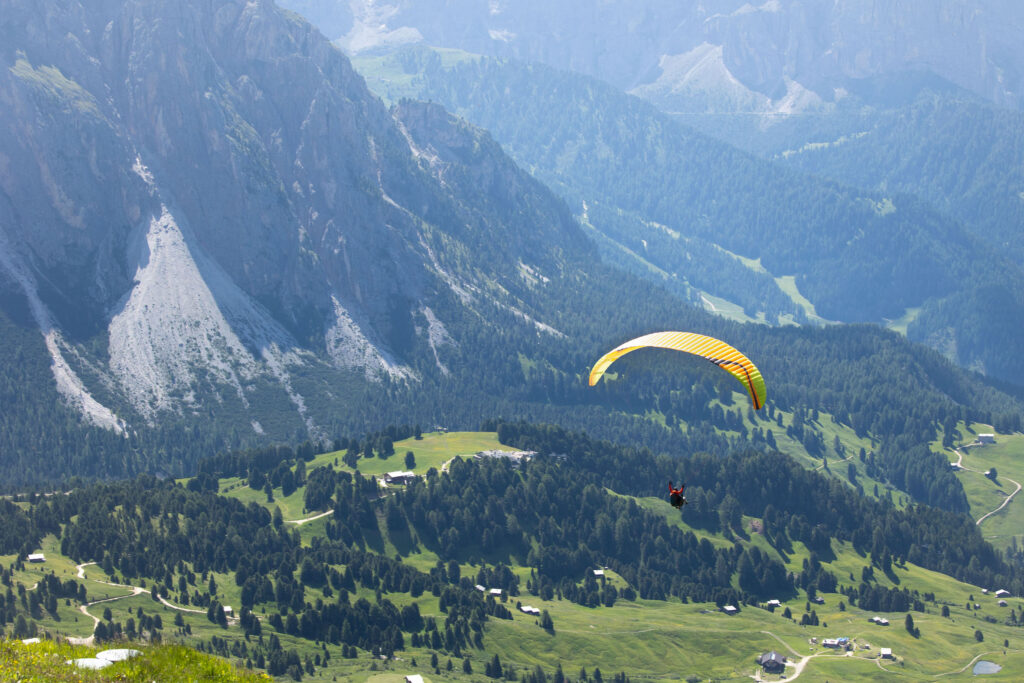
2. What is the Dolomites known for
It’s known for hiking, mountain climbing, cycling and paragliding in the summer , and snow sports like skiing, snowboarding, snow shoeing in the winter .
It’s also known for hypnotic photos of alpine lakes and lonely mountain huts, thanks to Instagram.
Less known and harder to photograph is the Dolomites’ vibrant culture, stemming from its history which dates back many millennia.
Before people were even around, the Dolomites was once an enormous coral reef, formed in the primordial ocean, Tethys . You can see fossils from the primordial ocean creatures in museums across the region. From prehistoric times, to the earliest records of humans in the stone age, to the period of Roman rule, to the Middle Ages, to WWI and WWII, through to today, the region has experienced so much transformation.
The region’s rich history is very much alive today in its people’s traditions, food and languages (there are 3 official languages in the Dolomites: German, Italian and Ladin… which means that everything has 2 or 3 names, including town, road and trail signs… fun times) and is definitely worth spending time learning about during your stay.
The Dolomites is a place to indulge in the best wine, eat delicious tagliatelle alla tartufo and speck, and experience for yourself.
3. Where to stay in the Dolomites without a car
There are so many great options when it comes to choosing where to base yourself. However, if you are travelling without a car, there are some important criteria you’ll want to consider. You’ll want to choose a base that:
- Is easy to get to without a car
- Has accessible day hikes and points of interest
- Has a variety of restaurants, cafes, bars and and other amenities within walking distance
Based on this, if you are visiting for the first or second time, in the western Dolomites, the Val Gardena area makes the most convenient base, and on the eastern side, the town of Cortina d’Ampezzo is your best bet.
From Val Gardena, you will be closer to sights including Alpe di Siusi, the Seceda ridgeline, Resciesa, and the Sassolungo group.
Staying in Cortina d’Ampezzo, you will be closer to different but equally beautiful sights, like Cinque Torri, Giau Pass, Lago Federa, Tre Cime di Lavaredo and Lago di Braies.
While Val Gardena and Cortina d’Ampezzo both have impressive hikes and views in their vicinities, there are a few things that give Val Gardena an edge:
Why you should stay in Val Gardena
- Val Gardena has access to different hikes, landscapes and sights from a more compact area. Access to most of the hikes in Val Gardena is contained within about a 5 km radius. This means you just need to walk 5-10 minutes to one of the lifts in town or take a short bus to a lift in one of the neighbouring towns in the valley. In Cortina on the other hand, most of the hikes and attractions are at least a 30 minute bus ride away from the town centre.
- Public transportation is free for visitors within the valley. All overnight visitors of Val Gardena can use any bus in the area for free throughout their stay via the Mobil Card, as long as your accommodation is a member of the Tourist Association (which almost all of them are).
- Val Gardena has the longest summer season in the Dolomites. In most places in the Dolomites, amenities including hotels, cableways, and mountain huts are open only from late June through September. However, in Val Gardena, many amenities stay open through October and later.
The bottom line: Val Gardena (specifically Ortisei – more on Ortisei below), is the top choice if you are travelling to the Dolomites for the first or second time time (i.e. you haven’t already experienced the main attractions around Val Gardena like Alpe di Siusi, the Seceda ridgeline, etc.) and won’t be using a car . While there are other destinations that are also easy to reach via public transportation and have great amenities, Val Garden wins out because the area has the most access to awesome day hikes within a short walk or bus ride from your accommodation and has free public transport for visitors that connects all 3 towns / villages in the valley.
Where to stay in Val Gardena
Val Gardena is composed of three lovely little mountain towns within a 10 km radius of each other: Ortisei, Santa Cristina and Selva. Which one you should choose to stay in really depends on what you’re looking for.
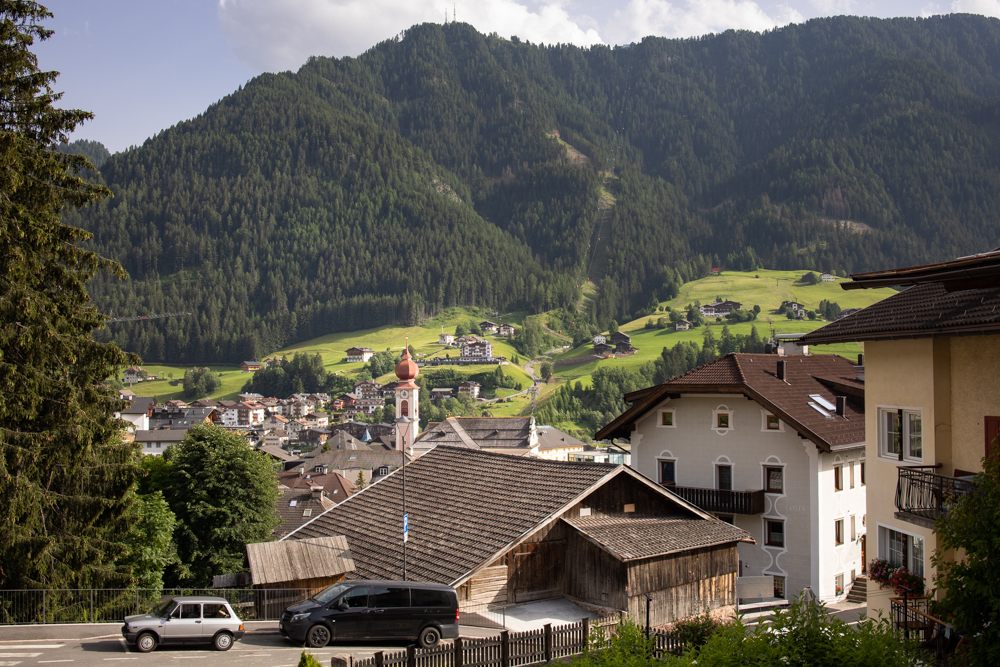
Ortisei is largest and the liveliest of the three, featuring a good selection of restaurants, bars and cafes and a pedestrian zone that’s perfect for evening strolls. It’s the closest to well-known sights like the Seceda ridgeline, Resciesa, and Alpe di Siusi. We enjoy food and convenience, so this was an easy winner for us and is where we stayed during our trip.
Santa Cristina is the smallest and is centrally located in the heart of the valley. While it doesn’t have the same level of amenities as its neighbours, it also feels the least “commercialized” and tends to get less crowded.
Selva di Val Gardena sits at the foot of Sella Massif, one of those mountains in the Dolomites that just takes your breath away. You can find incredible views of the Sella Massif from throughout the village, including from some of the accommodations. Also, thanks to its positioning at the highest elevation in the valley, Selva tends to have cooler temperatures, so it can be more comfortable on hot summer days.
The bottom line: While the towns are well connected enough that you could choose any of them as a base, Ortisei stands out because it’s the most accessible for getting to major attractions including the Seceda ridgeline, Alpe di Siusi and Receisa. Also, it’s the most convenient in terms of amenities (i.e. there are lots of great food options :).
4. How to get to the Dolomites without a car
Ortisei and Val Gardena in general are very well connected, so getting there without a car won’t be an issue.
There are plenty of airplane, train and bus options which I’ve outlined below.
If you are flying in for the trip, there are 10 airports that service the area and have some combination of train, bus and taxi connections available that will get you to Val Gardena in no time. You should fly in to the airport that makes the most sense for you based on flight availability, cost, time, etc.
Below are the airports in order of distance from Ortisei:
- Bolzano (BZO): 40 km
- Innsbruck (INN): 120 km
- Verona (VRN): 190 km
- Treviso (TSF): 190 km
- Bergamo (BGY): 270 km
- Venice (VCE): 270 km
- Munich (MUC): 300 km
- Milano (MXP): 350 km
- Salzburg (SZG): 320 km
- Zurich (ZRH): 420 km
To get from the airport to Ortisei, there are train, bus and shuttle options available.
Getting from the airport to Ortisei by train
If you are travelling by train or bus, you will need to get to Bolzano first. All of the cities mentioned above have trains that go to Bolzano. Check out the links below for prices and timetables:
- Innsbruck (INN) to Bolzano
- Verona (VRN) to Bolzano
- Treviso to Bolzano
- Bergamo to Bolzano
- Venice to Bolzano
- Munich (MUC) to Bolzano
- Milano to Bolzano
- Salzburg (SZG) to Bolzano
- Zurich (ZRH) to Bolzano
For details on how to get from Bolzano to Ortisei, check out the Getting from Bolzano to Ortisei section below.
Getting from the airport to Ortisei by bus
As mentioned above, if you are travelling by train or bus, you will need to get to Bolzano first. A budget-friendly option to get you to Bolzano from the airport is Flixbus , which offers service from all of the 10 airport cities mentioned above to Bolzano. Check out the Flixbus website for prices and timetables.
Note that some of the airports listed above don’t have a Flixbus bus stop at the airport itself, so you will need to use local transit to get from the airport to the bus stop.
Getting from the airport to Ortisei by shuttle
A super convenient option is the AltoAdigeBus airport shuttle, which offers direct transfers from all of the major airports in northern Italy, Austria, and Germany listed above to Ortisei. Check out the AltoAdigeBus website for timetables and pricing.
Travelling by train optimizes for the things I care about the most – speed, comfort and environmental impact, so it’s my favourite way to get around, especially in Europe.
You will need to get to Bolzano first, and then take a local bus, shuttle or taxi to Ortisei.
Check out the links below for prices and timetables:
- Trenitalia or Italo (Italy)
- Deutsche Bahn (Germany)
- ÖBB (Austria)
- SBB (Switzerland)
A great low-cost option to get to Ortisei if you are travelling from a nearby region such as northern Italy, Germany, or Austria is to take a bus. As mentioned, you will need to get to Bolzano first, and then take a local bus, shuttle or taxi to Ortisei.
For route information, timetables and pricing, check out the bus companies below, all of which offer bus service to Bolzano:
- Alto Adige Bus
Carpooling is a great way to get to your destinations and perhaps meet some new friends on the way. Check BlaBlaCar or another carpool platform for rides to Val Gardena from your area.
Getting from Bolzano to Ortisei
From Bolzano, you can get to Ortisei via public transit, the Sudtirol Transfer shuttle service, or taxi.
Public transit: take the 350 line from Bolzano to Ortisei. You can use the Suedtirol Mobil journey planner here and download PDF timetables for 2023 here or 2022 here . Shuttle bus: arrange to get picked up from the bus or train station in Bolzano and be driven to your accommodation in Ortisei. Check out the Sudtirol Transfer website for prices and timetables. Local taxi: contact a local Val Gardena taxi company and arrange to be picked up and dropped off whenever is most convenient for you. Check out the Val Gardena website for a list of companies and their contact info.
Depending on your chosen mode of transportation, it takes between 40 minutes to an hour of winding through the mountain roads to get from Bolzano to Ortisei. The views are incredible and will get you pumped to explore the mountains. The trip from Bolzano to Ortisei pretty windy. If you’re like me, and windy mountain roads tend to make you nauseous, keep some spearmint or peppermint mints or chewing gum handy for the ride. This has always been a lifesaver for me!
5. Accommodation in Ortisei
We were blown away by the incredible hotels and B&Bs in Ortisei. While there are plenty of great options, many were unavailable by the time we were looking to book (which was only a few days before we planned to leave).
Insider tip #1: Val Gardena is one of the most popular places in the Dolomites and gets a lot of both local Italian and international visitors year-round, so more often than not, the nicest and best-value-for-dollar places are booked months in advance. Don’t be like me, and book your accommodation in Ortisei as soon as you confirm your travel dates .
Insider tip #2: Many of the accommodations in Val Gardena require you to stay for a minimum of 3 nights, and some even require 7 nights. They will show up as unavailable on the booking websites if you search for a shorter duration stay . Keep this in mind when you’re looking for your accomodation.
Below are my recommendations depending on your budget.
Budget | Hotel Garni Plances
We got lucky with our last minute-booking and snagged a stay here for 8 nights, and I couldn’t recommend it enough!
The location is perfect – it’s situated in the heart of Ortisei, steps away from 2 grocery stores, 200 m from the Alpe di Siusi lift and 300 m from the Seceda lift.
It offers both en suite rooms as well as apartments, most with a balcony. The interior is thoughtfully designed, with lots of cozy wooden finishes. The rooms overlook the main promenade or the grassy hillsides across from the southern (back) side of the building.
Their breakfast buffet is a real treat, with amazing local & seasonal products (think fresh eggs, artisanal bread, homemade wild blueberry jam, and the creamiest ricotta cheese… *wipes drool*.
Included with your stay, you get access to a great nearby spa and wellness facility, with a 25-metre indoor lane pool, outdoor & saltwater pools, saunas, steam rooms & Turkish baths. The facility gets busy in the evenings with lots of families and children once everyone is done with their activities for the day, so try to avoid going between 6 pm and 8 pm if you’re looking for some quiet time.
The owner is incredibly kind and always available to answer questions and dish out insider tips.
Mid-Range | Casa al Sole
Casa al Sole is conveniently located in Otisei town centre, 350 m from the Seceda lift and 450 m from the Alpe di Siusi lift.
It has newly renovated en suite rooms designed with meticulous attention to practical living, some of which feature a mountain view.
Wonderful à la carte, continental or Full English/Irish breakfast can be enjoyed at the property. It also has a lovely bar with a thoughtfully curated wine, beer and cocktail menu to wind down after a long day of hiking.
The owners are repeatedly praised by guests for their warm hospitality and for going above and beyond to make sure guests have an amazing experience.
Luxury | Hotel Angelo Engel
Hotel Angelo Engel is situated in the centre of Ortisei, 600 m from the Seceda lift and 500 m from the Alpe di Siusi lift.
The alpine style rooms are elegant without compromising on comfort, including bath robes and slippers for each guest. Most rooms have a balcony.
The hotel features all the amenities you could think of. Guests especially appreciate the traditional South Tyrolean food served at the restaurant and the varied breakfast buffet offered each morning.
The spa area is another guest favourite, and includes an indoor pool, a hot tub, a Turkish bath, several saunas and an outdoor heated pool with a hydromassage area available for use year-round. Beauty treatments and massages are also available.
Free hiking excursions are offered in the summer.
6. Best time of year to visit
The inconvenient truth is that every season in the Dolomites is special in its own unique way.
Huzai and I visited during the last week of June, which worked out perfectly for us. We felt like we got to experience all the advantages of the summer season (ideal weather, wildflowers in full bloom, all of the amenities like mountain huts, restaurants and cable cars being open) before the summer tourist crowds picked up July.

That being said, there are pros and cons to visiting in each season, which I’ve summarized below.
Insider tip #3: In addition to the points below, if you’re travelling without a car, keep in mind that public transportation options will generally be more limited in the fall, winter, and spring, with bus routes running less frequently and many cable cars closed.
The itinerary I’ve provided is based on visiting during the summer. It may still be doable in the shoulder season (late spring and early fall), though some trailheads, towns and other points of interest may be closed or more difficult to get to.
The bottom line: If you’re interested in hiking and you’re travelling without a car, summer is the most convenient time to visit because all buses and cable cars run at their maximum frequencies. To avoid the tourist crowds, target the very beginning of the season (late June) or the very end (late September).
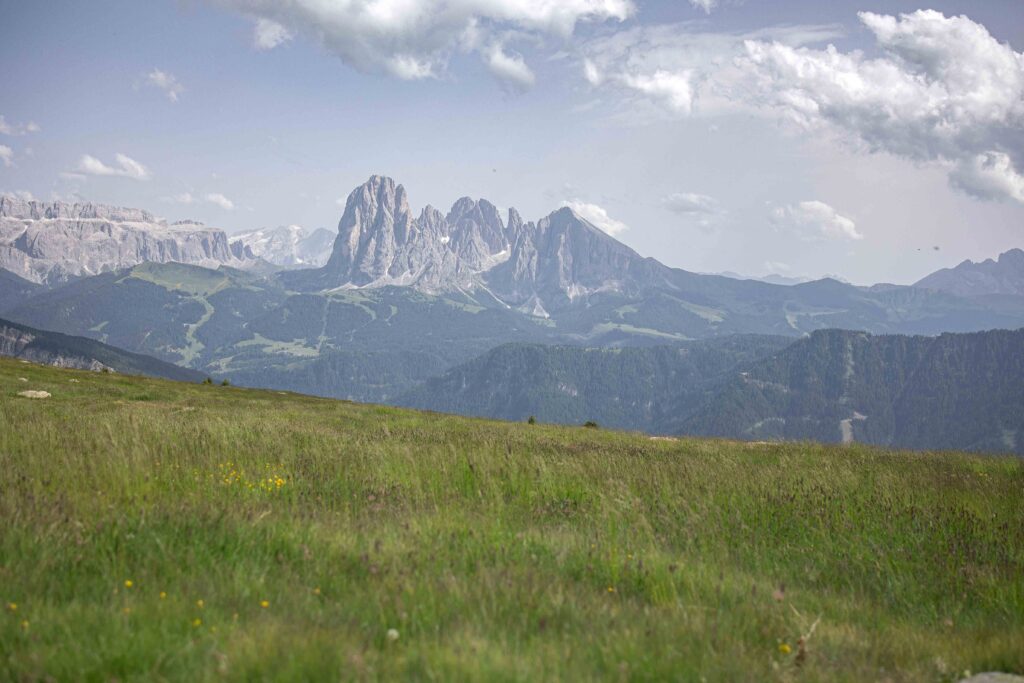
7. Perfect itinerary for 5 days in the Dolomites (without a car needed)
Day 1: hiking resciesa to seceda.
For your first day, dust off your hiking shoes and get ready to dive into the beauty of the Dolomites, with a panoramic 14 km trek across the Resciesa mountain plateau to the staggering Seceda ridgeline. The hike will take you on an elevation gain of just over 1000 metres, so unless you’ve been training, you will be pretty tuckered out by the end, but the views are so worth it!
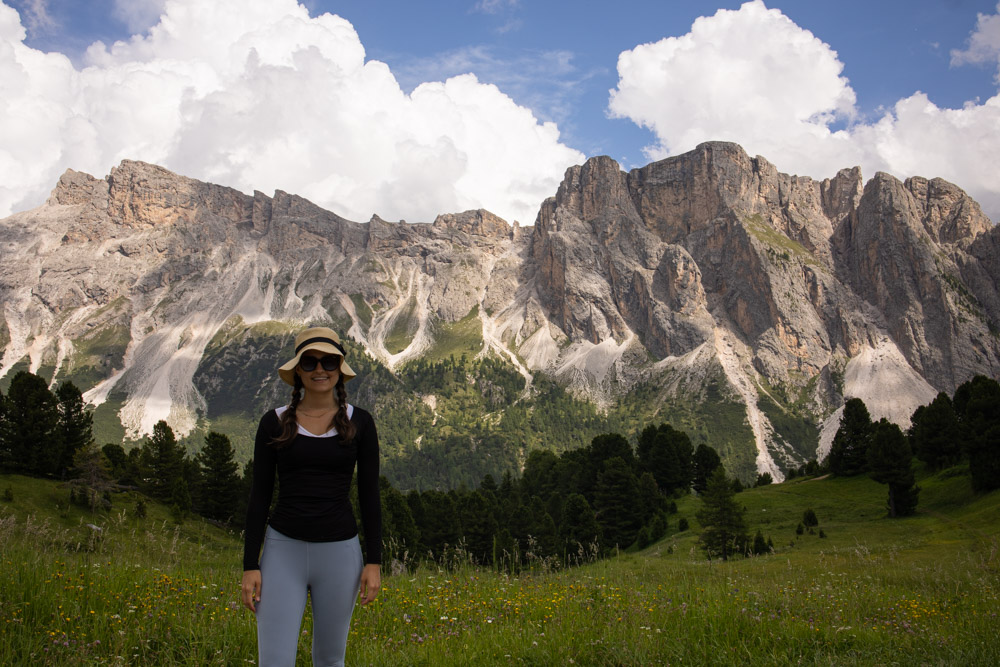
Day 2: Paragliding over Val Gardena and exploring Alpe di Siusi
Day 2 gives you a chance to recover from the long hike from the day before while getting a true bird’s eye view of Val Gardena by spending the morning paragliding across the valley.
In the afternoon, take a leisurely hike around Alpe di Siusi. The trails are well maintained and relatively flat, and it’s one of the most beautiful areas in the Dolomites, in my opinion.
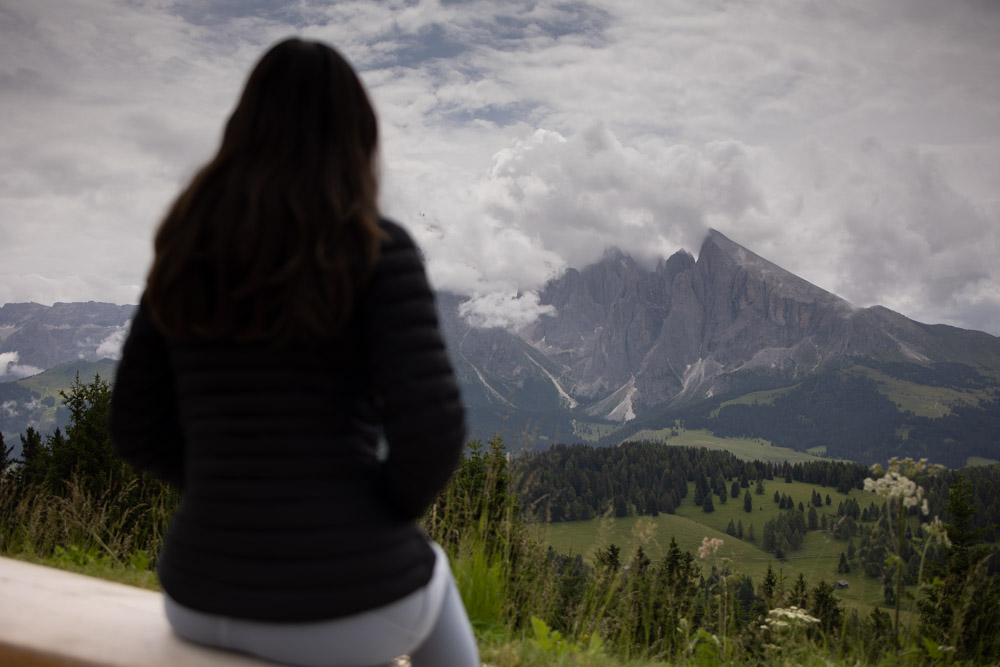
Day 3: Hiking around the base of the Sassolungo Group
On day 3, you’ll get to admire all the wild faces of the towering Sassolungo group of mountains during a challenging but ever so scenic 17 km loop, climbing and descending about 800 m.
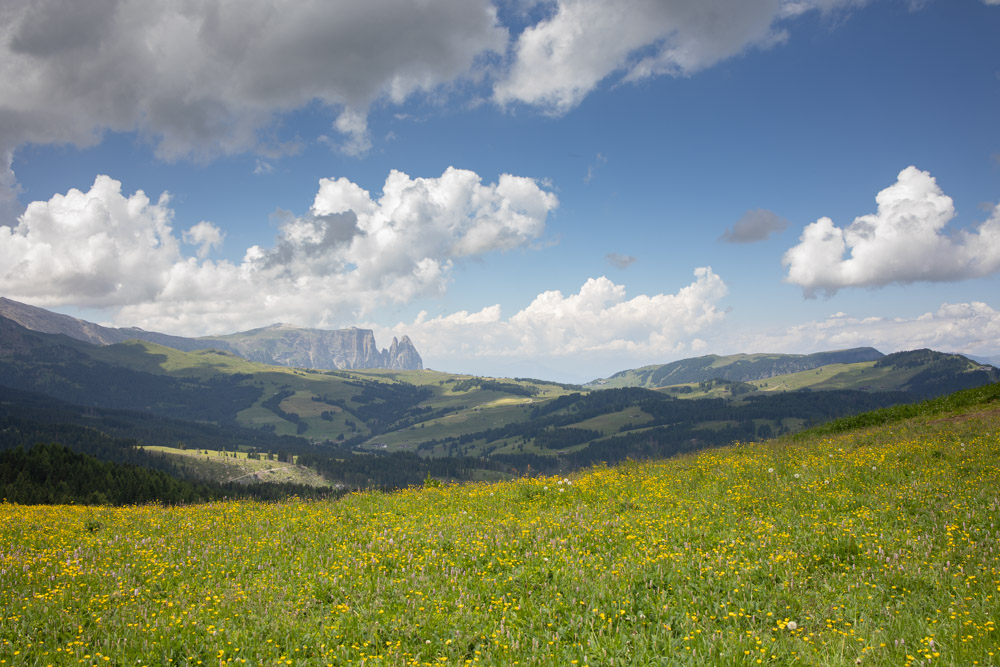
Day 4: Resciesa summit loop
On day 4, you’ll go back to Resciesa, this time hiking 5 km and ascending 185 m to the summit, where you’ll enjoy breathtaking panoramic views of the surrounding area.
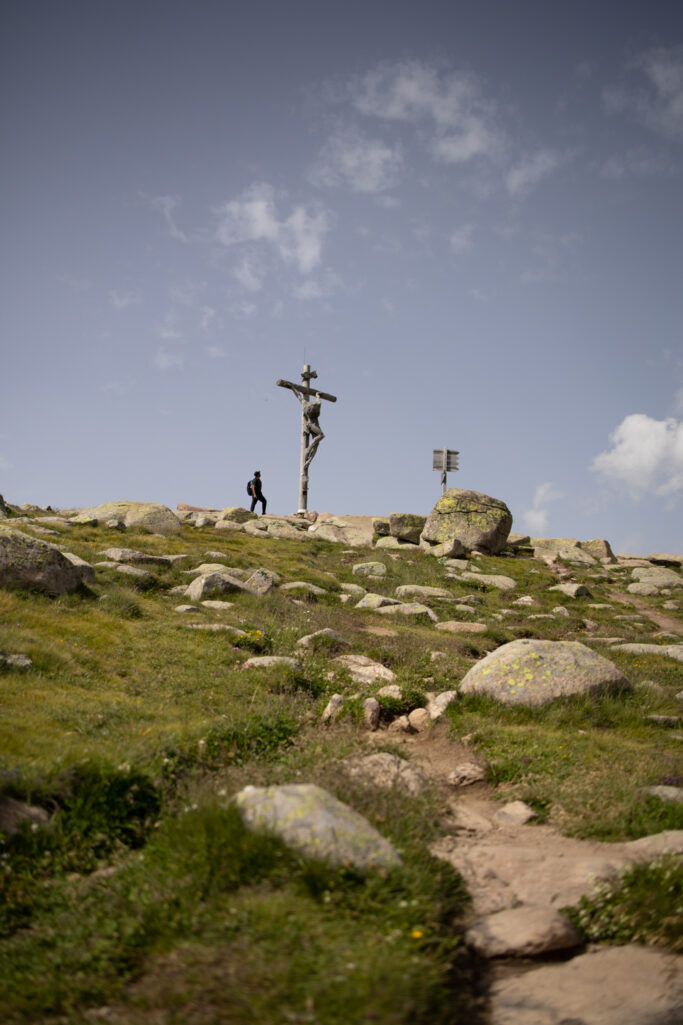
Day 5: Exploring the Vallunga and spa afternoon
For the last day, take it easy and explore the Vallunga valley in the heart of the Puez Odle Nature Park. Keep an eye out for wildlife, including deer and chamois in the steep meadows and rocky walls on either side of the hiking trail, as well as for eagles soaring above!
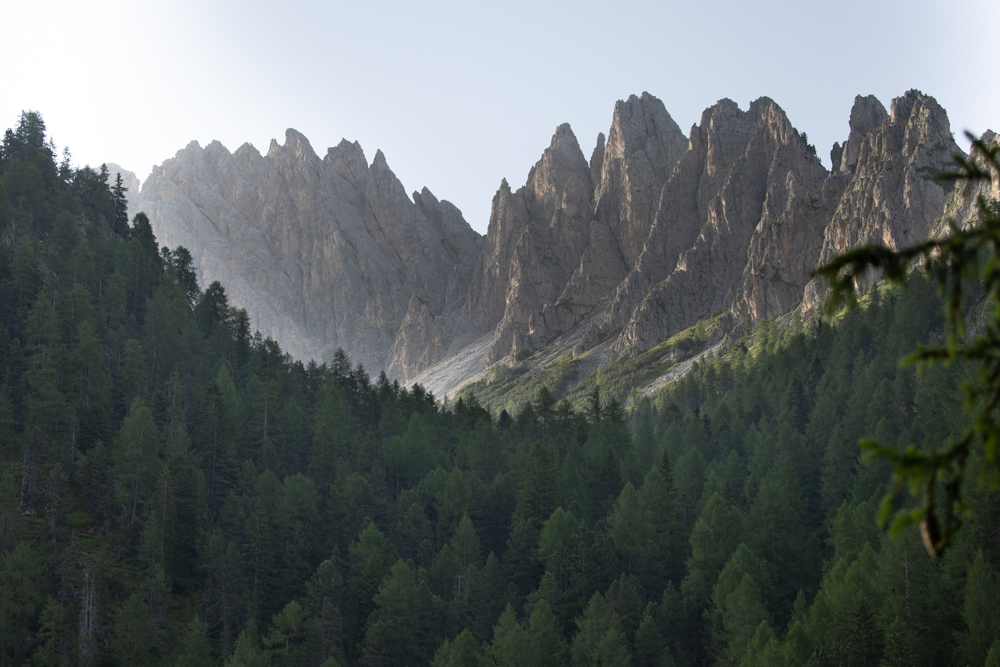
Before you leave, take the afternoon to get some well deserved R&R and perhaps a massage at one of the many world class wellness centres in the area.
Bonus activities
There are a couple of things that I didn’t get to do on my first trip to the Dolomites that I definitely want to do when I go back, including climbing a via ferrata and a hut to hut hike. For details about these and the other activities outlined in this itinerary, make sure to check out my other post, The perfect 5 day Dolomites itinerary without a car .
8. How to get around Ortisei and Val Gardena without a car
Free public transportation.
As mentioned, overnight visitors of Val Gardena receive a Mobil card, with provides free access to transportation in Val Gardena. This makes it easy and inexpensive to travel between the towns / villages (Ortisei, Santa Cristina and Selva) and explore the whole valley .
You can plan your trips using their journey planner .
Lifts and cable cars
There are many lifts scattered throughout Val Gardena that save you from having to ascend to the various sights and trailheads and give you more time to explore the tops of the mountains. You will use them for most hikes that you do as part of this itinerary, although we did see people walking up the trails, so it’s possible!
Purchasing a Gardena Card
Purchasing a Gardena Card allows you to use of all local lift facilities in the summer. The card can easily get you to destinations including the Seceda, Alpe di Siusi, Col Raiser, and Monte Pana. Check out my perfect 5 day Dolomites itinerary without a car for more info on the Gardena Card.
e-Bikes and mountain bikes are another popular way to explore the mountains. I didn’t get to try it on my own trip, but hope to someday!
9. What to eat and drink in the Dolomites
There is no shortage of delicious things to eat and drink in the Dolomites – below are just some of our favourites . 🙂
Charcuterie at a mountain hut
Stopping at a mountain hut for some charcuterie and a drink is part of the experience of hiking the Dolomites. And not all huts are made equal.
On the Seceda, there is Curona Baita , a hut where we had amazing, local, artisan charcuterie with incredible views.
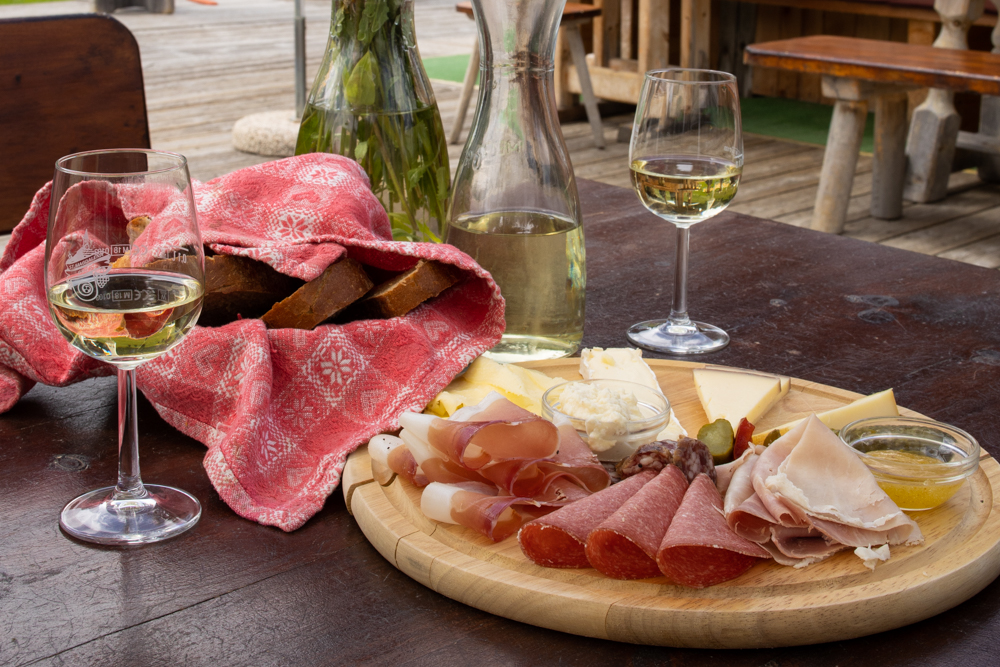
Traditional South Tyrolean cuisine
Try out some traditional local South Tyrolean cuisine for dinner at Mauriz Keller . The portions are generous and the ambiance is warm. They have a large menu and in addition to South Tyrolean specialties, they also serve a good selection of popular Italian dishes, including wood-fire oven pizza.

Nothing hits the spot after a long day of hiking like some pizza and wine! You have to try Turond a , a pizzeria and bistro in Ortisei (that we went to twice during our stay… oops). Their pizzas are truly divine. You can choose from several styles of dough, made with different types of flour, varying fermentation times, and unique cooking methods. The place does cater to a Western customer, so I wouldn’t necessarily come to experience traditional South Tyrolean food, but the pizza is bomb!
For amazing sunset views of the mountains, ask to sit on the outdoor patio. 🙂

Pack your own gourmet deli sandwiches
The grocery stores in Ortisei are stacked with the best meats, cheeses and spreads you could imagine. Huzai and I really enjoyed picking out the bread along with the other ingredients we wanted and putting together our own gourmet sandwiches. You can take them on your hikes and enjoy them high up in the mountains 🙂
That good good
Sign up to get occasional newsletters with exclusive content and updates from me!
Leave a Reply Cancel reply
Your email address will not be published. Required fields are marked *
Save my name, email, and website in this browser for the next time I comment.
Share this post
Related articles.
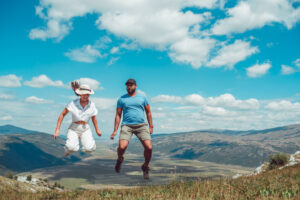
15 adventurous things you need to do in Bosnia & Hercegovina
Though I was born in Bosnia and Hercegovina (or BiH for short), my family and
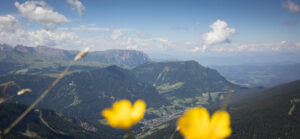
The perfect 5 day Dolomites itinerary without a car
Ah, the Dolomites… an etherial place to truly let the senses indulge, with its rolling
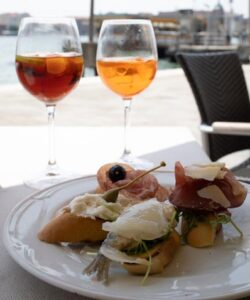
8 must-know tips to find good food in Venice, Italy
Both within and outside of Italy, Venice has a bad rap for overpriced, underwhelming food.
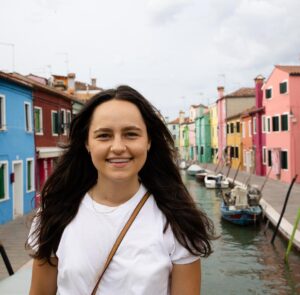
Dajana Radic
A bit about me.
My name is Dajana (pronounced like “Diana”) and I’m an adventurer, data nerd, travel blogger and photographer, currently based in Toronto, Canada.
My favourites
Wheresdeenow.
Follow me on Instagram

- 2024 TRAVEL UPDATE
- Work with us
- Beyond Bologna
- Regions of Italy
- Travel books
- Best group tours
- Itineraries
- Accommodation guide
- Italian phrases for travel
- Rocket Italian review: 2024 update
- Ultimate Italy Travel Planner
- City Planners
- Essential Guides
- Italy themed gift ideas
- Trip planning services
How to plan an Italy trip
Want to know how to plan an Italy trip? You’ve come to the right place. Italy trip planning is one of our favorite things to do. So much so that we set up this website.
We wrote this article to take you step by step through planning your trip. From deciding when to go and how much it will cost to what to take and how to use your mobile phone, it’s all here to remove the overwhelm and make your trip planning easier. Even if you choose to hire a travel agent to assist with your bookings, it is a good idea to walk through these steps as it will help the agent build the best trip for you.
You can see an overview of the steps you need to follow in the article contents below. Follow our guide and you’ll be on your way to planning your own trip or choosing the right tour for you and your travel companions.
Article contents
Step 1 – Decide when you want to go and your budget
When to go to italy.
There is no bad time to visit Italy but there may be one that suits you better. Depending on your interests and the places you want to see you need to be aware of seasonal differences that you need to know about:
- Summer – June to August: peak tourist season, weather is hot and prices higher. Many Italians are on vacation and the coastal areas are very busy especially in mid August
- Fall / Autumn – September to November: September remains hot and busy in most of the major tourist centers. By October the weather is cooling and ferry services on the coast and lakes stop running. At this time grape harvest is in full swing. November is generally quite wet but there is lots of sunshine between the showers.
- Winter – December to February: As the weather cools so do the crowds. Attractions are much less busy and the lead up to Christmas is magical with lights and decorations in shop windows. In January and February restaurants in many coastal areas are closed. February’s Carnevale in Venice is generally one of the most expensive times to visit the city
- Spring – March to May: In March and April wildflowers bloom and the countryside is awash with color. Easter is a popular holiday for Europeans to visit Italian cities especially Rome, Florence and Venice.
NOTE: peak season in the most visited destinations is May – October.
Our favorite time to visit Italy in the shoulder months. In April and May and October and November the weather is generally sunny and mild, the crowds are manageable and you can find great value deals on your flight and accommodation.
Although we are past the worst of the pandemic and travel restrictions, things can change quickly – you can check our article Can you travel to Italy plus current situation. We update this regularly with the latest travel news.
READ: Our full article on the best time to visit Italy
How much will it cost?
This will depend on your expectations, interests and travel style. You can travel very cheaply in Italy if you visit lesser-known regional areas and avoid the big cities. Even in the big cities it is possible to find free attractions and budget accommodation if you know where to look.
If you want to see the main sights and enjoy experiences such as cooking classes, private boat cruises and wine tours then the sky is really the limit when it comes to cost.
Most travelers fall somewhere in the middle however and a reasonable daily budget per person for food, transport and activities is around €100 on top of flights and accommodation.
READ: Our full article on Budgeting for your trip to Italy.
Expert Assistance
Need some help planning your trip?
Book in for a trip consultation with our expert Italy travel planners ready to help you build your dream vacation in Italy whether that be a classic first timer trip or an off the beaten path adventure
Step 2 – Do some preliminary research and preparation
Where to research your trip to italy.
From online news and magazines, blogs, Instagram, Facebook groups (check out Italy Travel Planning ) and even podcasts like ours – there are thousands of resources online. I am sure you’ve already seen quite a few of them already. Sometimes endless options can be overwhelming so we recommend collecting ideas in an online folder or scrapbook and organizing them into destinations that you really want to see.
You’ll probably want to “do it all” but really have a think about your interests and what will best suit you and your travel style. Once you have some ideas, it’s best to consult a structured resource to check your assumptions and thoughts.
Traditional guidebooks definitely have their place for planning a trip to Italy. Well researched and structured, they’ll give you in depth information on destinations and sights to see as well as practical tips to help you plan. Even after 30+ trips to Italy we still consult guidebooks for new destinations we want to visit. You can find our favorite Italy guidebooks here .
Italy travel planners
We noticed that even guidebooks can provide too much information in the planning process so we created one page travel planners for the top places to visit in Italy. Our planners tell you the top sights, best viewpoints, must have experiences and our favorite places to eat (including best gelato stops) in each place.
You can print them off or keep them on your phone and there’s a link to an online map so you can map out your days. We have guides for Rome, Florence, Venice, Milan, Cinque Terre, Amalfi Coast and Sorrento. Our goal is always to simplify the trip planning process and we know you will find them useful.
DISCOVER: Our Digital travel guides and planners .
Group tour itineraries
Tour companies – like ours ! – put a lot of effort into designing tours that cover the main sights and even lesser known regions. They know the times it takes to get around and how long you can stay in each place to get a taste or feel for the destination.
We often check itineraries of places we would like to visit as an input into our own planning. Here are some recommended tour companies and itineraries to investigate.
Private tours
If you want maximum flexibility and comfort, consider a private driving tour . From the moment you land, to when you depart, you’ll have a personal driver with local knowledge making sure your trip is exactly what you imagined.
Passports and visas
At this stage of your planning it is a good idea to check the validity of your passport and if you require a visa. Citizens of the United States, Australia, Canada, United Kingdom and New Zealand may enter Italy and stay up to 90 days without a visa within an 180 day period. You must have 6 months validity on your passport when you enter Italy. Go and check this now as it can take several months for new passports to be processed.
All other nationalities should check this Italian government site that will walk you through whether a visa is required for your visit.
Citizens of the European Union can travel with photo identification.
Please note – this information is subject to change and it is always best to check with your local foreign office for the latest advice on travel to Italy.
- United States – click here
- Australia – click here
- United Kingdom – click here
- Canada – click here
READ: Can you travel to Italy plus current situation .
Step 3 – Confirm your itinerary
Itinerary planning is where many people get stuck. We understand. There are so many amazing places to see in Italy that deciding where to go and how much time to spend there can be hard. As a general rule, we like to spend a minimum of three nights in each place to minimize time spent traveling and also enjoy each place as much as possible. So if you have a 10 day trip then 3 main stops would be a good baseline to start with.
Where to go
From your research, you probably have an idea of where you want to go. You may want to visit the popular cities and regions on your first trip however each city and region in Italy offers something special.
Most popular cities
Most popular regions.
On our site, you can also browse Italy’s lesser-known cities and regions on the destinations page or visit our article on hidden gems in Italy for inspiration.
Itinerary suggestions
As a general rule, for a 3-5 day trip we suggest choosing one destination – a city or region. If you have a week to 10 days then you can plan 1-3 places in either the north OR south of Italy. In a two week trip you could cover 3-4 places and see both north and south.
Try not to squeeze too much in. It’s easy to underestimate transit times and getting in and out of airports and train stations. Plus you want to have plenty of time to enjoy yourself and soak up every last moment.
Suggested itineraries
If it is your first trip to Italy, like many first-time visitors you may choose to start your journey in Rome and visit Florence and Venice. This 10 day Italy itinerary covers that route. It includes detailed instructions on how to make the most of your time in Italy.
Want our FREE Italy trip planning checklist? >> Click here .
Alternative 10 day itinerary suggestions
Most people travel to Italy for 10 to 14 days so we built some itinerary suggestions to cater for that time frame that cover both northern and southern Italy.
Group Tours
Packaged group tours of Italy are a popular way to travel and avoid the stress of planning your own trip. They are also a great option if you would like some company along the way. Here is a quick summary of popular tour companies:
- Untold Italy small group tours – we run exclusive small group tours for food and wine-loving travelers wanting to get off the beaten path to see hidden Italy beyond the major cities and tourist areas. We lead groups of 14 people on journeys of discovery to experience the regions of Sicily, Puglia, Piedmont, Tuscany, Umbria, Bologna and surrounds, Capri and the Cilento coasts > learn more
- Trafalgar – popular and well respected brand appealing to the 50+ age group. Travel is by coach and the focus is on culture and history. Expect group sizes of 40-45 passengers and 4 star hotels. Trafalgar also include interesting local experiences such as wine tastings and unique stays in their itineraries. Check out their popular Best of Italy tour
- Intrepid Travel – small group tours with an average of 10 travelers with plenty of free time built in for exploring. Their popular Italy Real Food Adventure is an 8 day itinerary that showcases their travel style well
- Peregrine – Intrepid’s premium brand offers some interesting hiking tours of the Italian Lakes and Amalfi Coast
- Tourradar – is a market place for group packaged tours where you can browse hundreds of package tours by different operators, and by date. You then filter by your interests and age group and read detailed reviews. You can browse fully organized tours to independent self-drive or train itineraries
READ: Our full article on the Best package tours for Italy .
When should you start booking your trip?
Italy is one of the most visited destinations in the world, so in our opinion, it is never too early to start the booking process. Book accommodation as soon as possible, and at least 6-12 months in advance especially for peak times in July and August. We prefer to pay the higher rate for flexible bookings on both Booking.com and Plum Guide .
Day tour and attractions also sell out months in advance at peak times. In 2020 our preferred booking site GetYourGuide refunded all tours canceled due to the pandemic and stand by their policy of allowing cancelations with a full refund up to 24 hours before your activity starts.
Flight bookings will depend on where you are flying from. For long haul flights the best deals are generally found 6-12 months in advance while deals pop up regularly for travel within Europe.
Rail bookings can be made up to 4 months in advance on high speed intercity and standard intercity trains.
Step 4 – Book your flights, inbound travel & insurance
Flights to italy.
It is easy to fly direct (or with a single stop) into Italy from most places in the world. Rome Fiumicino [Leonardo da Vinci](FCO) international airport is the main hub for air traffic but you can also easily fly into Milan Malpensa (MXP) or Venice Marco Polo (VCE) airports from major hubs around the world.
There are many other airports throughout the country that can be accessed within Italy and Europe. Pisa is useful for trips to Tuscany and the Cinque Terre and you will need to fly into both Sicily and Sardinia.
To source the best flight deals to Italy we use a combination of Skyscanner , CheapoAir and Google flights .
- Skyscanner – portal where you can view cheapest days and routes to fly and set alerts for price drops
- CheapoAir – uncovers the best deals on first and business class flights around the world
- Google flights – great for checking schedules and airline routes
Secure the best deals by setting up alerts on Skyscanner for the month you wish to travel and wait for price drops. It’s good to have a price that you wish to pay in mind but be prepared to be flexible on dates and stopovers. It is often cheaper to fly into Milan rather than Rome and that city is a useful entry point for northern Italy itineraries.
TIP: always use an incognito browser window to search for flight deals. Prices are amended up for users known to be searching for specific dates and times.
Inbound rail from within Europe
Major Italian cities – Milan, Rome, Florence and Venice – have fantastic fast speed train links from other capitals and major cities in Europe. The website Seat 61 is a great resource for planning train travel within Europe.
Bus travel to Italy
If you’re on a tight budget and traveling within Europe, then you might want to consider coming to Italy by bus. Low cost operator Flixbus covers 3,000 destinations in 39 countries.
You can compare schedules and prices using Omio – a useful site for booking a combination of train, bus and air travel within Europe.

Organize travel insurance
Once you have booked your flights or tour, we recommend organizing travel insurance straight away. The main reason you should purchase insurance is to cover health costs and emergency repatriation to your home country should you fall ill. Since 2020 you need to check whether there is cover provided for issues relating to covid19 however general health cover is recommended regardless.
Cover for cancelation, delays and loss of belongings is a bonus and again they may not apply under pandemic conditions. You need to read all the terms and conditions of your cover including any exclusions before you commit to buy.
Policy costs vary by your country of residence, what is covered, age, existing conditions and the insurer. You can visit Worldnomads for a quick quote. We use this company for our family travels and find the cost, coverage and claims process to be good to excellent.
Another option if you are in the United States is Safety Wing’s Nomad Insurance . Unfortunately neither option provides policies for those aged over 69. In this case you can try Travel Insurance Master – a service that allows you to compare quotes and insurance policies.
Step 5 – Book accommodation and transport
Accommodation.
Choosing where to stay at each stop is an important part of itinerary planning. Italy has many different options for tourists and you can expect the usual range of hotels and bed and breakfast accommodation as well as apartments and villas.
If you plan to spend any time in the country, consider staying at an agriturismo or farm stay. This is accommodation offered by Italian farmers who earn additional income by providing rooms and meals. Very popular in Italy and Europe, prices ranges from budget to luxurious. You can find agriturismi (plural) with swimming pools, hammams, restaurants and wine cellars. We always try to build them into our itinerary.
LISTEN: Find out about farm stays in Italy in this podcast episode .
How much will accommodation cost?
Here is a rough guide to average prices for a double room. This will vary with prices higher in popular areas at peak times
Upscale / Luxury – €210+ [USD $240+] per night Midrange / Boutique – €120-260 [USD $135-295] per night Budget / B&B – €70-130 [USD $80-150] per night Ultra budget / Hostel or shared room in AirBnB – €30-45 [USD $30-40] per night
Best accommodation sites
Our favorite sites for booking lodging are Booking.com and Plum Guide – between them, you’ll find a huge range of options from hotels and resorts to bed and breakfast, apartments and farm stay accommodation.
Plum Guide is particularly useful for longer stays in apartments and villas and if you’re traveling as a family and need some extra space. Use the code “Untold5” for a 5% discount here .
Other sites we use and recommend
- BookingsForYou – beautiful villas and apartments in Tuscany, Italian Lakes and Puglia – 5% for readers when you mention our site or code – UntoldItaly – when booking
- VRBO – has some great options for long stay villas and apartments, particularly on the Amalfi Coast
- Agriturismo.it – great for finding smaller farm stays but the booking engine is terrible. You can usually find the same properties on Booking.com
- Airbnb – we have used Airbnb on many occasions in Italy but are now finding better value and booking conditions on Booking.com and VRBO
LISTEN: To more accommodation options and what to look for in this podcast episode .
Further reading:
- Where to stay in Rome – a district by district guide to the best areas to stay
- Best places to stay in Florence – neighborhoods and areas best suited to your trip
- Where to stay in Venice – a neighborhood and area guide
- Where to stay in Milan – best areas, places and hotels
READ: Our Italy accommodation guide .
Transport while in Italy
As a general rule, if you are traveling between cities and major towns then the best way to travel around Italy is by train. If you want to explore the countryside and small villages you will need to rent a car.
When you are mapping out distances to travel between destinations use Google maps or Rome2Rio .
Train travel in Italy
Trains in Italy are modern and efficient. Fast speed services link the major cities and regional trains connect smaller towns and villages. Two major train networks operate throughout Italy – Italo and Trenitalia .
You should book in advance for high speed intercity services where seats are allocated. If you purchase non-flexible tickets you can make significant savings with advance bookings. They are not required on regional services.
READ: Our Complete guide to train travel in Italy .
Recommended train booking sites – Omio and The Trainline
You can book directly with the Italian operators or an easier way is with:
Omio – compare train times and prices across both Trenitalia and Italo schedules and keep your ticket details on their handy app. Click here to search for rail tickets on Omio
The Trainline is a similar service to Omio offering schedules, pricing and booking for train companies in Italy and Europe. They also have a useful app and great instructions in English. Click here to search for rail tickets on The Trainline
High speed train intercity travel times on popular routes
Rome to Florence – 1 hour 30 minutes Rome to Naples – 1 hour 15 minutes Rome to Milan – 3 hours Rome to Venice – 4 hours Florence to Venice – 2 hours Florence to Milan – 2 hours
Car rental in Italy
One of the best ways to see the smaller towns and countryside in Italy is to rent a car and take to the open road. Driving in Italy is quite straightforward. You just need to do some forward planning and use your common sense. Here are some tips to
- You are required to carry an International Drivers Permit – these can be arranged in your home country at minimal cost
- Standard transmission on cars is manual or stick shift. If you want to rent an automatic car expect to pay extra, if you can find one available
- Rent the smallest car you can to fit you and your luggage – roads are often narrow and you don’t want to get stuck!
- Heavy fines apply if you enter ZTL zones or historic districts where driving is not allowed
We use both Car Rental by booking.com and AutoEurope to find the best car rental deals in Italy including one way options. They both search international and local providers so you get a wide variety of choice and there is 24/7 support if you need it. AutoEurope is usually your best option if you want a one way rental.
Click here to search for car rentals in Italy with Car Rental by booking.com .
READ: Our guide to Renting a car in Italy .
Internal flights
If you want to visit the islands of Sicily or Sardinia, or travel very long distances, flying makes the most sense.
Check on Skyscanner or Google flights for routes and prices. Remember to set alerts for those routes you want to fly and book early for flights in the summer months.
READ: Our guide to all transportation in Italy .
Step 6 – Book Attractions, tours and activities
Major attractions.
The major cities of Italy – Rome, Florence, Venice and Milan – are some of the busiest cities for tourists in the world. And most visitors want to spend time at their famous attractions
We strongly advise you to prebook advance skip-the-line tickets for the following attractions – the Colosseum, Vatican Museums, Uffizi Gallery and Doge’s Palace. Otherwise, you could spend precious vacation hours standing in lines to enter these sites. Note – in winter months booking in advance is not as necessary.
We have given you the official booking sites and an alternative for approved ticket partners should you have trouble using the official site – unfortunately, that happens a lot! The direct sites are usually cheaper but the partner sites are generally more user friendly. Always check the terms and conditions of your purchase, particularly in relation to changes and refunds. GetYourGuide has a very easy cancelation policy which in many cases allows cancelation with refunds up to 24 hours prior to departure.
- Colosseum – official ticket site OR buy Colosseum tickets on Get Your Guide
- Vatican Museums – official ticket site OR buy Vatican Museum tickets on Get Your Guide
- Omnia pass – Colosseum + Vatican + one other museum + hop on, hop off bus – click here for details
- Uffizi Gallery – official ticket site OR buy Uffizi tickets on Get Your Guide
- ‘David’ statue [Accademia Gallery] – official ticket site OR buy Accademia tickets on Get Your Guide
- Duomo roof climb – official ticket site OR buy Dome climb tickets on Get Your Guide
- Doge’s Palace – official ticket site OR buy Doge’s palace tickets on Get Your Guide
- San Marco basilica – official skip the line tickets OR buy a tour of San Marco including tickets on Get Your Guide
- ‘Last Supper’ painting – official ticket site OR buy Last Supper tickets on Get Your Guide
- Duomo rooftop – official ticket site OR buy Duomo tickets on Get Your Guide
READ: Our full review of Get Your Guide .
If you want to learn about the sites you are visiting then we recommend a group day tour. We prefer small group or private tours where you learn about the culture and history of the places you are visiting. It’s so much more fun than reading plaques and you are also able to ask questions.
So make sure to build in a couple of tours when you are planning a trip to Italy.
Our favorite small group tour companies are Take Walks (formerly Walks of Italy) and Liv Tours and we prefer With Locals for private tours. Both offer very well designed and engaging tours of the major sights in Italy as well as interesting food and cultural tours.
- Take Walks have a longstanding reputation for excellent service, groups under 20 people and guaranteed departures. So if you are the only person booked on a tour it will still go ahead. We recently enjoyed our Colosseum at night tour and day trip to Tuscany with them
- Liv Tours – family run Italian company offering true small group tours of 6 people or less. All of their tours use expert guides who will help you fall in love with Italian history, culture, and food. Tours include a popular golf cart tour of Rome’s highlights and their fascinating Women’s history tours
- With Locals offer great value private tours. You choose from a series of set itineraries and guides in cities across Italy. There are tours focused on history, food, culture and other themes or they can be customized them for your group. We tried their 10 Tastes of Naples recently and it was lots of fun. They also have great options for families
- Eating Europe – food tour specialists who will ensure you discover the best local dishes
Save 5% on Liv Tours with code – ‘untold italy’ >> click here to browse tours
- Rome: A 3 Day Itinerary
- The best tours in Rome
- Unmissable day trips from Florence
- Day trip from Rome to Pompeii
- Best tours of the Vatican
- Tickets and tours for the Colosseum
- Rome’s best food tours
Activities and experiences
Seeing the sights of Italy is always a treat but you’ll also love immersing yourself in Italian culture. These days you can choose from a wide range of experiences and activities. From food and wine tours, to football matches, concerts and exploring the countryside by vintage car, there are memorable experiences to suit you.
Recommended experiences
- Cooking class with Nonna Nerina near Rome – Grandma Nerina teaches you how to make fresh pasta and welcomes you into her home. If you can’t wait until you get to Italy to do this she also does online classes
- Capri boat trip – small group on a private boat means a slower pace and more time to see the island. You can read what to expect on this day trip here
Our favorite companies for searching for interesting and unique things to do in Italy are:
- Cookly – cooking class and food and wine experiences like truffle hunting from small operators across Italy
- Get Your Guide – has the biggest listing of tours and experiences
Step 7 – Get ready for departure
Organize your money and credit card.
The local currency in Italy is the € Euro.
You do not need to carry too much cash when you are there. Credit and debit cards VISA and Mastercard are widely accepted while American Express and Diners Club are not as popular. You may want to consider a foreign currency card like the Wise Mastercard where you can convert Euros easily and cheaply from your US dollar, Australian dollar or Canadian dollar accounts (plus many other currencies)
Be aware of foreign currency charges and ATM withdrawal fees applied to your account when you are abroad. You may want to review the cards you are taking with you prior to your trip. We recommend that you take two – one as a back up for emergencies. And inform your bank before you go. Sometimes they can be overzealous and place a block on your card if they see unusual activity.
Book airport transfers
Planning your arrival in Italy is recommended. Most of the airports are a fair way out from the city center – and in the case of Venice, in the middle of a lagoon!
Compare different transfer services on Suntransfers – a company that specializes in transfer options from major airports. They have options to suit all budgets and prices for coach, mini bus, private car and limo services.
Rome – transfers from Fiumicino airport
Taxis are fine to take in Rome. There is a set rate into the center of €48 and the ride takes around 45 minutes. Or, if you would prefer to be met at the airport you can pre-book a transfer. A transfer is the best option if you are traveling with more than 2 people and have several items of luggage. We recommend:
- Welcome Pickups – available 24/7, a private car transfer means you are met at the arrivals hall and will take between 30 minutes and one hour door-to-door.
- Suntransfers – offers a wide range of vehicles for groups of all sizes. Transfers can be canceled up to 48 hours in advance with no penalty.
Another popular way to transfer into Rome is to take the Leonardo Express train . This non-stop service between Fiumicino and Rome Termini (the main station) takes 32 minutes. Trains depart every half hour from 6:08 to 23:23, and the cost is €14. You can purchase tickets at the station on the day. Unless you are staying close to Termini you will then need to get a taxi to your accommodation.
The cheapest transfer option – this bus goes direct from the airport to Termini – €6-7 one way.
READ: Our full article on Rome airport transfers .
Venice transfers
The water bus company Alilaguna runs shuttles every 15 -30 minutes in peak season to and from the airport and the islands on the lagoon. This bus stops at San Marco and Rialto as well as some other secondary stops. The fare is €8 one way €15 return and the journey takes 1½ hours – you can book online here
A private boat transfer or shared transfer in a water taxi is the fastest (and most glamorous) way to transfer to your accommodation in Venice. Journey times and prices depend on the number of people in your party and exclusivity. A direct private transfer to the airport takes around 45 minutes.
- Private transfer – around €200 for 6 people – book here
- Shared water taxi transfer – around €32 per person – book here
You can also take a taxi (cost €25) or express airport bus to Piazzale Roma (cost €8) and then take a vaporetto (water bus) or walk your hotel/accommodation. A one way trip on the ferry costs €7 per person and is valid for 60 minutes.
READ: Our full article on Venice airport transfers .
Florence transfers from Florence airport
Florence airport is very close to the city center and a 15 minute taxi ride away. There is also an airport bus that takes around 20 minutes. A 20 minute tram ride takes you to the main Santa Maria Novella train station and costs €1.50.
Florence transfers from Pisa airport
Many people fly to Pisa to reach Florence as it is a larger airport. If you arrive during the day take the PisaMover train to Pisa Centrale train station – journey time 5 minutes. Then take a train to Florence. Starts at 6.00 am and the last train departs at midnight and it costs €5.00.
On our last visit we arranged a transfer with Suntransfers as we arrived too late for the last train. There is also a coach transfer option.
Amalfi Coast or Sorrento transfers from Naples airport or train station
We recommend organizing a private transfer for this journey. The train, ferry and bus via Sorrento can take 4 hours while a car service is around 1.5 hours. You can compare different services on Suntransfers – a site specializing in ground transportation.
You may find sites or groups where specific drivers are recommended. We do not recommend booking a driver this way for safety reasons – how do you know that the person recommending the driver is reputable, let alone the driver? And also for practical reasons – small operators may not have capacity or availability.
Plan how to access the internet
Consider how you will access the internet on your trip. You may be happy to disconnect and use paper or offline maps however many of us need internet access.
Italy has high speed internet and there are many options to stay connected depending on your needs. If you use minimal data and are happy to use offline maps and guides then you should be able to get by using wifi at your hotel or accommodation. Do not expect wifi to be available in restaurants and cafes because in Italy restaurants are for eating.
If you plan to use wifi make sure to turn off international data roaming before your trip to avoid unpleasant bill surprises.
Paid internet options
- Use your provider’s roaming plan – usually very expensive and slow speeds if coming from outside Europe
- Local SIM – purchase a tourist SIM before your depart or when you arrive that has enough data for map navigation and research. Italian provider TIM comes highly recommended and there are outlets at the airports and train stations
- Portable wifi device – connect multiple devices to high speed internet for reasonable prices. We use and recommend Solis Wifi (Get 10% off with our code – UNTOLDM )
READ: Our full guide to Cellphones and getting online in Italy (SIMs, wifi and more) .
Packing for your Italy trip
The key to packing for Italy is to pack the minimum that you need. Many people like to take carry-on luggage only for their trips. This is a great way to travel as you will find it much easier managing trains, cobblestones and stairs that are a feature of travel in Italy.
But, most of us find that a challenge, so try to stick to a medium bag per person plus one carry on item. Large suitcases are not a good idea. You will also thank yourself if you consider your footwear carefully. Three comfortable pairs will see you through most trips.
Note – We have a complete packing guide coming soon.
LISTEN: to packing strategies in this podcast episode .
Must have items for your trip
- Luggage – get the size right with our guide to the best luggage for Italy
- Untold Italy travel planners – one page checklists of the must see sights, restaurants and gelato bars in Italy’s most popular places
- Collapsible water bottle – stay hydrated and fill up at free water fountains all over Italy
- Camera – for your vacation snaps. We recommend lightweight mirrorless models like these ones
- Packing cubes – these make packing, organizing your luggage and unpacking so easy. We love them!
- Power cube – don’t bring lots of bulky converters. This one has 3 USB ports
- Battery pack – keep all your devices charged
- Plug adapter – you will need one!
- Face masks – for your safety and you may be required to wear one indoors
- Hand sanitizer wipes – to keep germs at bay
READ: Our Complete packing guide for Italy .
Get started and plan your Italy trip now!
We hope you now have more confidence to start planning your trip to Italy. This will no doubt be a trip that you’ll remember and cherish for years to come. And, like many of us, you may find it sparks a passion to return to bella Italia again and again.
Latest Italy Travel Podcasts and Articles
Can you travel to italy – latest travel information [april 2024], visiting italy in may – reasons to go and what to expect, episode #216: 10 reasons we love italy’s umbria region, visiting italy in april – reasons to go and what to expect, episode #215: discover regional italy without a car, episode #210: travel smart to italy – your guide to new regulations and important dates, how to use your cellphone in italy, venice tourist tax – latest information on the new access pass for venice, planning a trip to italy.
We love travel in Italy and sharing our knowledge. Read our Italy trip planning guide or join our FREE Italy travel planning community . Our 115,000+ members are happy to answer questions about your itinerary, how to get from place to place, the best places to stay and fun things to do.
Sign up for our news and podcast updates where we share mini guides, tips, exclusive deals and more and we'll send you our Italy Trip Planning Checklist to say grazie ! >> click here to subscribe

5 Days in Puglia Without a Car: The Best Puglia Itinerary Based in Bari, Italy
Deciding on places to visit in 5 days in Puglia was a bit of a challenge. I chose to explore Puglia without a car, but even if I had taken a road trip, narrowing down the bucket list for this region felt impossible.
Italy’s heel is packed with dreamy beaches, natural scenery, sun-drenched villages, and imposing historical landmarks, and you can’t experience it all in less than a week.
I was more than happy with my final choices, so if you need help planning a Puglia itinerary that doesn’t require driving (and car rental expenses), you’re welcome to draw inspiration from this post.
* This post may contain affiliate links from which I earn a commission (for more info, read my disclosure ). As an Amazon Associate, I earn from qualifying purchases.
* I try to keep the information on this blog as updated as possible, but I still recommend consulting the latest prices, opening hours, and other details on the official website of each site, hotel, and tour, as well as checking the updated public transport routes and timetables.

Table of Contents
5-Day Puglia Itinerary Without a Car – Summary and Map
Click here to access the MyMaps interactive map of this itinerary.
Tip: After accessing the map, you can also open it on your Google Maps app. Simply open your app, tap the ‘saved’ icon at the bottom, scroll down and tap the ‘maps’ icon, and choose the MyMaps map you want to see (you can do the same on your computer).
In 5 days, I could only focus on a specific area of Puglia, and here’s a quick summary of my trip (based in Bari):
Days 1+2: Bari , Puglia’s capital and an underrated Italian city.
Day 3: Alberobello , known for its unique Trulli houses ( optional: Locorotondo ).
You can also visit Alberobello with a guided day tour .
Day 4: Polignano a Mare + Monopoli , two magnificent coastal towns.
You can also visit them with a day tour that includes Alberobello, Monopoli, and Polignano a Mare .
Day 5: Trani , a hidden gem in Puglia ( optional: Giovinazzo ).
Some of the places I didn’t have enough time to visit were Ostuni, Matera, Grotte di Castellana, and Castel del Monte, but that’s just the tip of the iceberg.

Where to Stay in Puglia Without a Car?
Puglia is a big region in southern Italy, so there are a couple of ways you can visit it without a car.
My Choice – Bari
Bari is a great choice if you prefer basing yourself in one place and taking day trips (like I did) instead of staying each night in another town.
Two of the best districts to stay in Bari are Murat , the more modern part of the city, and Bari Vecchia , the enchanting old town. I chose to book my accommodation in Murat as it is conveniently located between Bari Vecchia and the train station.
I stayed at B&B Alighieri 97 , which, like many guesthouses in Europe, is housed in a residential building. It’s a simple B&B, yet it’s clean, comfy, and with an ideal location near many restaurants, cafes, and shopping streets.
Other highly-rated accommodations in Murat include:
- Giardino dei Lenti – Self check-in Apartments : Located near Bari’s castle, this guesthouse offers double and triple rooms with a small private kitchen and access to the property’s inner garden.
- BARI 102 : Rated 9.9 and located near the shopping street near Via Sparano, this B&B offers modern rooms and suites for 2-5 people (with a small balcony) and a highly-rated breakfast buffet.
If you want to stay in Bari Vecchia, check out:
- TRESCA CHARME luxury Rooms : Situated near Basilica San Nicola, this accommodation offers spacious apartment-like rooms (with a small kitchen) for 2-4 people, some of which have a private terrace.
- Palazzo Le Travi : Located in the southern part of the old town (near Murat), this B&B offers stylish double & triple rooms with a small balcony and a shared area where you can have coffee, tea, and snacks.
You can also browse other accommodations in Bari .
Other Options
Other cities from which it should be fairly easy to take day trips and travel in Puglia by train and bus are Brindisi and Lecce , and they will allow you to explore the Salento peninsula by taking day trips to places like Taranto, Otranto, Gallipoli, and Specchia, to name a few.
Browse accommodations in Brindisi and Lecce .
If you’re seeking a unique experience, you can also book a stay in a Masseria , a traditional estate-like farmhouse from the 16th century, or a trullo , Puglia’s renowned stone hut. Highly rated ones include Trulli Antichi Mestieri and Il Trullo Gentile .
Another unique option is to book a stay at Hotel Grotta Palazzese in the beautiful coastal town of Polignano a Mare , an infamous cliffside hotel & restaurant.

Other Activities to Add to Your Puglia Trip
If you want to take tours in the towns I’ve mentioned or visit other places in Puglia (you can spend only one day in Bari and take another day trip), here are some highly-rated activities you can book:
- Street food tour of Bari .
- Dining experience at a local’s home in Bari.
- Boat tour with aperitif in Bari.
- Walking tour of Alberobello .
- Boat tour to Polignano a Mare’s caves.
- Day tour to Matera , one of the oldest cities in the world and a UNESCO site.

WHAT TO EXPECT & ARE 5 DAYS IN PUGLIA ENOUGH?
To me, it felt like five days were only enough to see a very small part of Puglia.
Being ruled by the Greeks, Romans, and Normans (to name a few), it’s a historically and culturally fascinating Italian region.
While its pristine beaches make it a beloved summer destination, it has so much more to offer, from whitewashed towns, medieval castles, and archeological sites, to olive groves, vineyards, and national parks.
You can take quite a lot of day trips from Bari and still only scratch the surface of this intriguing region, and if you want to explore it from north to south, you’ll need a lot more time than just 5 days.
If you’re a first-time visitor, I’d suggest spending 1-2 weeks in Puglia, though, in 14 days, I’d add Lecce as one more base for day trips, like the Cave of Poetry (Grotta della Poesia) and Otranto.

Getting Around Puglia Without a Car (By Train and Bus)
From Bari Centrale train station (and the streets around it), it’s easy to catch buses and regional trains to many destinations across Puglia.
When it comes to intercity buses, save time and energy and buy your ticket in advance online because there’s no proper bus ticket office.
Train tickets are obviously easier to purchase on-site, as you’ll find a ticket office and machines inside the station, alongside which you’ll see a digital departure board and info-point workers who can assist you.
Tickets bought at the station will almost always be imprinted with the date only, so you need to validate them using one of the machines on the platform (there are no validation machines on the train).
On the back side of your ticket, you’ll see arrow marks showing you how to insert it into the machine.
As for online purchases, your e-ticket will indicate both the date and hour of the train ride, so validation isn’t necessary. Plus, if you’re visiting in the high season, the queues at the station might be long, so having an e-ticket will save you time.
In other towns, there are ticket machines on the platform itself, but you can also purchase a round-trip ticket in Bari.
I love booking my tickets on Omio , which compares bus and train prices in one place. Note that it shows results that include bus and train changes, so look for “0 changes” if you’re looking for a direct route.

5 Days in Puglia – Days 1+2
Even though it’s Puglia’s capital city, it seems like Bari isn’t seen as a highlight of such a picturesque region, which I can understand, but I still think it’s worth spending some time here.
You can adjust this itinerary by dedicating only one day to Bari and adding another day trip.
From Ancient Greece to the Norman conquest to the Napoleonic Kingdom of Naples, it’s safe to say that Bari is steeped in history, yet, it also caters to those seeking cultural activities, delicious food, and relaxing beaches.
On day one, explore the charming maze of narrow streets of the old town – Bari Vecchia, where you can immerse yourself in the traditional side of Bari.
Admire the medieval Basilica San Nicola and Bari Cathedral (Cattedrale di San Sabino), visit the Civic Museum and the Archeological Museum, people-watch at Piazza Mercantile, and walk on Via Venezia all the way to the gorgeous Teatro Margherita and the old port.

When it comes to food, Bari Vecchia’s alleys are lined with an abundance of Apulian restaurants, bakeries, and cafes, so you’re in for a treat.
I had a great meal at Ristorante Antò, though I also had my eyes on La Cantina dello Zio and La Locanda dell’Elfo. In addition, be sure to try focaccia Barese at Bakery Santa Rita.
For dessert, savor a gelato at Gelateria Gentile, overlooking the imposing Castello Svevo (Swabian Castle), which you can also visit.
I tried the nocciola and ricotta with pistachios, which were unbelievably delicious (seriously, that was one of the best gelatos I’ve ever had in Italy).

Nearby, you’ll find an unmissable place to visit in Bari – Arco Basso Street – also known as “Strada delle Orecchiette” (Street of the Orecchiette).
Here, you’ll see the nonnas sitting and making the most notorious Apulian pasta shape, orecchiette, translating to “little ears”.
Since watching the nonnas has become a popular tourist attraction, be sure to buy some pasta if you’re going to take pictures and videos.
If you want to explore Bari Vecchia’s culinary gems with a guide, consider booking a street food tour .

Start your morning with a stroll along the best and liveliest promenade in Bari – Lungomare Nazario Sauro. If you love art museums, you can stop at the Pinacoteca Metropolitana di Bari.
Finally, you’ll get to Bari’s beach, Pane e Pomodoro (translating to Bread and Tomato), for a few hours of tranquility.
In comparison to other beaches in Puglia, it might not be considered one of the best, but the crystal clear water and the utter quiet were more than enough for me.
In the second half of the day, head to the vibrant Murat, the newer part of the city.
It’s definitely not as picture-perfect as the old town, but it’s home to several photogenic buildings like Palazzo Mincuzzi, Teatro Piccinni, and the opera house Teatro Petruzzelli.
Murat is packed with trendy cafes and international cuisine restaurants, and it’s an ideal place to shop till you drop (on Via Sparano and around it) and have an aperitivo. You should also buy some baked goods at Magda.

5 Days in Puglia – Day 3
Alberobello.
The first image that usually pops up when you search for info on Puglia depicts the quirky storybook-like Trulli houses of Alberobello.
Although you can see them sprinkled throughout the Itria Valley, this town is home to more than 1,500 Trulli, declared a UNESCO World Heritage Site.
The origins of these traditional dry-stone huts with cone-shaped roofs trace back to prehistoric times, but Alberobello and its Trulli date back to the 14th-17th centuries, when the area was ruled by the Kingdom of Naples and controlled by the Counts of Conversano.
The Count ordered his residents to build houses without using mortar, which meant they could be easily dismantled, and the town wouldn’t have to pay taxes to the Kingdom.

Intriguingly, many Trulli are still used as homes (so it’s important to be respectful when wandering around), while others function as accommodations, souvenir shops, and restaurants. Most are built on a slope, so bring comfortable shoes/sandals.
Be sure to explore the two Trulli districts – Rione Monti and Rione Aia Piccola, admire the Basilica of Saints Cosmas and Damian & the Church of Saint Anthony of Padua, and visit Trullo Sovrano.
To learn more about the local history, you can also take a guided walking tour of Alberobello .
Visiting in the shoulder season allowed me to relish one of the most popular Apulian towns without being surrounded by many tourists, so if you’re planning a summer trip, be prepared for the crowds (and heat).

Getting from Bari to Alberobello (and back): You can catch a direct bus several times a day, and the journey only takes 1 hour and 5 minutes. It’s best to purchase your ticket in advance (online).
The bus stop in Bari is located behind Bari Centrale (pass through the station to get there), and the bus stop in Alberobello is right outside its train station (unlike what Google Maps shows, so ignore it).
At the platform, use the ticket machines to buy your bus ticket back to Bari.
Alternatively, book yourself a guided day tour of Alberobello from Bari .

Optional: Locorotondo
There’s a good chance you won’t spend the entire day in Alberobello, so you can continue to Locorotondo, considered one of the prettiest towns in Puglia (I had to skip out on it for various reasons). It’s reachable by a 15-minute bus/train ride.
To get back to Bari, take the bus, though note that the last direct one leaves at approximately 5:25 PM. Otherwise, you’ll have to switch trains in Putignano.
Instead of Locorotondo, you can also visit the nearby Martina Franca.
5 Days in Puglia – Day 4
Polignano a mare.
Considering it’s one of the busiest towns in Puglia in the summer months, I’m glad I visited Polignano a Mare in the shoulder season when I had it almost completely to myself.
Overlooking the Adriatic Sea, the charming coastal town is thought to be the Ancient Greek city of Neapolis.
It is known for its scenic viewpoints, whitewashed historic center, and rugged cliffs, which make it a popular cliff diving destination.

One of its main focal points is the adorable beach of Lama Monachile, of which you’ve probably seen a million photos on Instagram.
It’s not sandy, it’s very small, and it seems like it gets overcrowded in the peak season, so if you’re after the ideal Apulian beach, this is not it. However, I loved sitting there without doing anything special, listening to the subtle sound of the waves and enjoying some serenity.
You can capture the beauty of its glistening crystal-clear waters at various lookout points, but my favorites were the Roman bridge, Belvedere su Lama Monachile, and the cliff down the stairs near the statue of Domenico Modugno (the Polignano-born singer-songwriter who gifted us the hit “Volare”).

Another famous spot is the Grotta Palazzese, a stunning cave that has become the location of a 5-star hotel’s restaurant. You can book a stay at Hotel Grotta Palazzese or just make a reservation for lunch or dinner.
If that’s not enough, the surrounding area is packed with more hidden sea caves, which you can get to with a boat tour .
Getting from Bari to Polignano a Mare: Trains to Polignano leave Bari Centrale every 20-30 minutes (their final destination is usually Fasano), and the journey takes 30-40 minutes.
It’s not mandatory, but you can purchase your tickets online to save time.

Ruled by the Messapians, Romans, Normans, and Venetians (to name a few), Monopoli has always been one of the most important port towns in the region.
I almost made the mistake of comparing it to Polignano a Mare, but I’m glad I came to my senses because they’re not as similar as you might think.
Sure, they’re proximate to one another, and both are seaside towns with a whitewashed historic center, but each has its own charm and rhythm.
While Polignano won me over with its coastal scenery, Monopoli enticed me with its picture-perfect old town. On the map, it doesn’t look that big, yet somehow it seems to consist of hundreds of little flower-adorned alleys.
If you’re up for some sightseeing, you’ll love the colorful boats of the old port (Porto Antico), the imposing 16th-century Castle of Charles V, and the Monopoli Cathedral (Basilica Cattedrale di Maria Santissima della Madia).
Be sure to also walk along the Lungomare Santa Maria and unwind at Cala Porta Vecchia.

Getting from Polignano a Mare to Monopoli: The train ride only takes 5 minutes, but there’s some walking to do from Monopoli’s train station to the historic center, which is more than 1 km away.
Getting back from Monopoli to Bari: Depending on the train, it’ll take you 30-50 minutes to get back to Bari.
**You can switch things up and visit Monopli first instead of Polignano. It’s not mandatory, but you can purchase your train tickets online .
You can also book a day tour that includes Alberobello, Monopoli, and Polignano a Mare .

5 Days in Puglia – Day 5
Unlike the other towns I mentioned, Trani is not as known (and if it is, it doesn’t always make the cut into people’s itineraries), which is one of the reasons I loved it so much.
Picture this: a beautiful port, the sound of seagulls, a striking medieval castle and cathedral overlooking the Adriatic Sea, and an adorable historic center. If you love quaint coastal towns, Trani will win you over.
But the thing that makes Trani even more unique is its Jewish heritage, as it was home to one of the largest Jewish communities in Puglia until the 16th century.
Not much has remained from the Jewish quarter, but fortunately, you can visit the Scolanova Synagogue and Synagogue Museum of Sant’Anna.
Both were closed when I was there (the opening hours are limited, and I couldn’t get to Trani earlier), but I would love to see them in the future.
Another spot not to be missed in Trani is the Villa Communale. Perfectly landscaped and decorated, this coastal public park is ideal for a leisurely stroll.
Getting from Bari to Trani: Trains to Trani leave Bari Centrale frequently (their final destination is usually Barletta or Foggia), and the journey takes 30-40 minutes.
When you go back to Bari, note that you’ll have to pass through a small kiosk to get to the platform. Ask the cashier for a train ticket because there are no ticket machines on the platform.

Optional: Giovinazzo
Originally, I wanted to continue from Trani to Giovinazzo, a lesser-known port town that seems like a picturesque hidden gem in Puglia .
But although I had perfect weather throughout my trip, that morning was rainy, so I only got to Trani at around 1 PM. I didn’t want to rush things and squeeze Giovinazzo into my Puglia travel itinerary, so I had to skip out on it.
This town is located right between Trani and Bari, and you can reach it by either train or bus (the same goes for getting back to Bari).
Puglia in 5 Days – Other Travel Tips and Notes
When to visit.
It’s well-known that Puglia is a favored summer destination, so if you want to avoid the crowds and the overly hot & humid weather, July and August might not be the best time to visit.
I traveled to Puglia in March because I was looking for an off-season trip.
The temperatures can be unpredictable, providing cloudy and rainy days alongside warm days, but I was lucky to enjoy perfect weather 95% of the time and relish Puglia’s popular towns with barely any tourists wandering around.
That said, it wasn’t warm enough to go for a swim, though some locals did.
That’s why I assume that the sweet spot between the shoulder season and the summer months is May, the first half of June, the second half of September, and maybe even the beginning of October.

How to Get to Puglia
International flights arrive daily at Bari’s Karol Wojtyla Airport, but you can also catch a bus from Naples or a train from Rome.
What to Eat
Food in Italy never disappoints me, but since my other trips took place in the central and northern regions, I was excited to immerse myself in Puglia’s culinary scene. Here are some local dishes I’d gladly go back to devour:
Spaghetti all’Assassina (The Assassin’s Spaghetti): If a non-Italian came up with this recipe, I’m pretty sure nonnas across Italy would have been outraged, given that the pasta is placed raw in the spicy tomato sauce until slightly burnt, and then a broth of water and tomato paste is added gradually (like in a risotto) until it’s perfectly cooked.
Bari is the birthplace of this unusual dish, but it’s important to choose the right restaurant to try it because some seem to burn the pasta a lot more than others, and I’ve heard the result is not great. I tried it at La Baresana at loved it.
Riso, patate e cozze: Also known as Tiella Barese, this unexpected yet utterly delicious baked dish consists of rice, potatoes, and mussels.
Orecchiette with cime di rapa : Not only was I excited to know that Puglia’s most iconic pasta shape, orecchiette (little ears), was inspired by Jewish sweets called Haman’s Ears, but I was also thrilled to try a typical dish in which it’s cooked with cime di rapa – broccoli rabe/rapini. Note that the sauce contains anchovies, so it’s not vegetarian.

Focaccia Barese: Topped with cherry tomatoes (and sometimes olives), this focaccia is not an ordinary one because some versions incorporate mashed potatoes into the dough.
Panzerotto: Similar in shape to a calzone, this heavenly fried dough is filled with tomato and mozzarella.
Sgagliozze: While polenta is a more common ingredient in northern Italy, it’s used to make a popular street food in Puglia of deep-fried polenta squares.
Pasticciotto: As a full-time pastry addict, one of my favorite things to try was a pasticciotto, an oval-shaped sweet pie filled with pastry cream. YUM.
Taralli: If you’re a snack lover (who isn’t), don’t forget to buy these crunchy round breadsticks. If you can’t find them in regular bakeries, some nonnas on Bari’s Street of the Orecchiette also sell them.
It’s also worth knowing that Puglia is the birthplace of my beloved burrata cheese and the largest producer of olive oil in Italy.
Other Italy Travel Guides
Did you enjoy this 5-day itinerary for your Puglia holidays without a car? Read:
- Best day trips from Bari
- Is Bari worth visiting
- Hidden gems in southern Italy
- Best Italian road trips
- Prettiest Italian piazzas
- Italy travel quotes
- Gifts for Italy lovers
- Romantic novels set in Italy
- Things to do in Italy in winter
- 3 days in Malta without a car
- 7 days in Mallorca without a car
- 5 days in Alsace without a car
About Or Amir
Hey, I'm Or! I'm a passionate traveler with a severe coffee, chocolate, and pastry addiction (or any other carb for that matter). I'm always planning my next trip to Spain, Italy, or any other country in Europe, and my goal is to help you make the most of each destination.
*Your emil address will not be published. By using this form you agree with the storage and handling of your data by this website
Leave a Comment Cancel reply
Save my name, email, and website in this browser for the next time I comment.
Hi, I'm Or!
I'm a passionate traveler obsessed with traveling in Europe and discovering hidden gems in each place I visit. For me, it's not about ticking destinations off the bucket list but experiencing each one of them to the fullest. Read more about me and my story.

Sicily Without a Car – The Perfect Sicily Itinerary by Bus & Train
This Sicily itinerary will show you exactly how to see the most amazing places on the island without a car. Using a combination of buses, trains, boats, one bicycle and your own two feet, you’ll be able to see spectacular churches (like the one in Noto, above), breathtaking beaches (my favorite was on the island of Favignana) and charming medieval towns. Along the way you’ll get to taste delicious pizza, eat gelato for breakfast (it’s okay, it’s the Sicilian way!) and stop for more than a few Aperol Spritz(es?).
I recently visited Sicily without a car, and I felt so free without the burden of navigating, parking, refueling and, of course, paying! Sicily is a great car-free travel destination, and with a little bit of planning (often just the night before) you really can take in all of the island’s best destinations without a car. Keep reading to see how!
Sicily Itinerary Overview
Sicily transportation.
This Sicily itinerary is easily accomplished without a car. I should know, since I followed this exact route on my recent three-week trip around Sicily. Thanks to Sicily’s good intercity transportation connections and pedestrian-friendly city centers, I didn’t rent a car – or even take a taxi – at any time during my trip! When it comes to traveling in Sicily without a car, you should keep these points in mind:
- Sicily has frequent, affordable bus transportation options, but it often feels like you’re using a different company for every trip. Your route may involve buses on five, six or seven different operators.
- Buses typically run late. If your route requires a change (like Siracusa to Taormina, or Taormina to Agrigento, both of which change in Catania) leave yourself at least an hour between buses. You can always pass the time in a cafe near the bus station.
- Train service is decent along the coast but not practical for trips that require crossing the middle of the island.
- Regional trains to popular destinations are often standing room only. If you want a guaranteed seat, choose a more expensive intercity train (or take a bus).
- In high season, book your ground transportation at least one day in advance and your boat trips as as soon as you know your travel dates.
Sicily Hotels and B&Bs
I traveled with The Lonely Planet Sicily . Updated in 2022, this guidebook has up-to-date information about transportation, attractions and most hotels and restaurants. However, I often find their accommodation information to be either outdated (or missing some really well-loved, affordable options) so I rely on recent reviews from Booking.com (and their Genius discounts!) for accommodation. That link will take you right to their Sicily page, where you can find all of the properties I stayed at on my trip.
As a solo, mid-budget traveler in Sicily I preferred to stay in B&Bs and family-run guesthouses, rather than hotels. They were typically more affordable, often had very central locations and came with a level of insider local knowledge that you can’t always get from a front desk agent at a chain hotel.
Sicily Food & Drink
The food and drink in Sicily was amazing. As a vegetarian, I always had multiple options (and not just pizza and pasta!).
It’s common to start your day with a small, sweet breakfast, like a cup of granita (similar to shaved ice) or a pastry. At lunch, I looked for restaurants with vegetarian buffets (usually full-service, rather than self-service) or that served big salads. In the early evening I’d look for a nice aperitivo bar where I could have a cocktail and a few snacks, and that was often the last thing I’d eat (since I couldn’t stay awake long enough to have dinner too!).
I was in Sicily for the second half of July and early August, and it was hot . Remember to stay hydrated by drinking lots of water, and consider supplementing with a bit of Gatorade or Powerade if you’re feeling really run down from the heat. I often buy a five-liter jug of water and keep it in my hotel room to refill the reusable bottle I take out exploring; while Sicilian tap water is drinkable, it’s not exactly delicious.
Now, with all that information out of the way, it’s time to jump straight into my Sicily travel itinerary!
#1 – Arrive in Catania

Your Sicily itinerary will probably begin in Catania, which is home to Sicily’s busiest airport. Most of the island’s intercity buses stop at the airport, so you could head directly to another destination, but I think it’s absolutely worthwhile to spend at least two nights in this busy port.
From the airport, the public ALIBUS departs regularly for the city center. I suggest taking it to the end of the line, Piazza Borsellino, where it’s only two minutes by foot to the main plaza and to my recommended accommodation option: BAD (Breakfast & Design). This independent B&B has rooms with chic decor and the perfect, central location. Your host, Alessandro, will give you a map with the city’s walkable highlights, so you can drop your bags and start exploring by foot immediately.
Things to Do in Catania
- There’s a pretty figure-eight walking route through the city center. It takes about half a day (if you stop at one or two of the sights) and includes one uphill section. You’ll see the fish market , Piazza Duomo and the famous elephant obelisk, Teatro Massimo , the Roman Amphitheater and Castello Ursino .
- You can read about those attractions, and more, in my new Catania travel guide .
- On the uphill section of your walk, stop at NelsonSicily , a gourmet food shop where you can stock up on artisan products like Bronte pistachios, cream of pistachio, pistachio liqueur, pistachio chocolate bars… you get the idea.
Catania Restaurant Recommendations
- My favorite restaurant in Catania was La Cucina dei Colori . This is a healthy vegetarian restaurant with a full-service lunch buffet featuring local, seasons ingredients. On the day I visited they were serving rustic panelle (chickpea pancakes), fritters made from local greens and stuffed with cheese, stewed chard, farro salad and a house interpretation of ratatouille.
- Some people say you need to visit Trattoria del Forestiero while you’re in Catania, as its thought to have the best and most authentic pasta alla norma (and the nonna in the kitchen once taught Jamie Oliver how to make her iconic dish). I’ve had equally good pasta alla norma elsewhere, and with far better service.
- I’m a vegetarian, so I didn’t try any of the fish at Catania’s famous fish market. However, I did stop by fish-centric street food hub Scirocco Sicilian Fish Lab for a cone filled with their vegetarian fritto misto , with battered and fried veggies, fava beans and pistachio-stuffed arancini.
You can travel from Piazza Borsellino to Siracusa on Interbus . Buy your tickets a day or two in advance, if possible. Take the bus to the end of the line (Corso Gelone) in Siracusa.
#2 – Explore Siracusa & Ortigia

If you arrive in Siracusa by bus, you’ll half to walk about fifteen minutes to reach Ortigia, the island that was once the town’s historical center and that still offers the most evocative sightseeing in the city.
My recommended B&B option in Ortigia is right at the entrance to the island, which is ideal if you’re walking with your luggage. B&B Casa Verga is a family-run bed and breakfast with spacious, high-ceiling rooms, some of which directly overlook the stunning Temple of Apollo. Once you’ve dropped off your bags you can walk around the temple to the market, where you’ll find dozens of restaurants and sandwich vendors competing for your lunch patronage.
Things to Do in Siracusa & Ortigia
- While Siracusa and Ortigia draw a crowd, even the touristic center of Ortigia feels less crowded and more authentic than Taormina (more on that coming shortly!). This is one of the loveliest places to do nothing much beside wander the cobblestone streets with a gelato in hand.
- There is a small beach at the south tip of Ortigia. The water here was warm and relatively clean, but water shoes are definitely recommended because it’s quite rocky.
- In Siracusa proper (not on the island of Ortigia) there is a well-known and celebrated archeological park . It’s about thirty minutes by foot from Ortigia, and it’s mostly uphill, so I recommend taking a city bus up and walking back. Before you buy a ticket, check to see if the Greek Theater is covered with scaffolding for the summer performance series. If it’s even “partially” covered, don’t bother.
Siracusa and Ortigia Restaurant Recommendations
- Have you ever had pistachios on pizza? At Cosi Ristorante , in Ortigia’s market, they have a fun pizza with pumpkin cream, fontina cheese and pistachios (if you’re not vegetarian, it also comes with prosciutto).
- MOON (Move Ortigia Out of Normality) is a contemporary, upscale vegan restaurant with a pretty terrace right on Via Roma. I had a cocktail, the mixed salad and the “carbonara” with turmeric and smoked tofu. Reservations are highly recommended.
- The southwest tip of Ortigia is fantastic for sunset-watching with an aperitivo. The enter waterfront is lined with cafes, bars and restaurants. You can’t go wrong with an Aperol Spritz anywhere here, though I did enjoy nibbling on the rosemary flatbread and cream cheese trio at SunSet Ortigia .
Don’t miss a day trip to Noto! You can go by bus or train, but I recommend taking an AST morning bus there and the Trenitalia train back (more on that below). This route is also served less frequently by Interbus (link above).
One you’ve seen Noto, you can travel from Siracusa to either Taormina or Agrigento by bus, with a change at the Catania airport. Bus details are below.
#3 – Day Trip to Noto

As far as I’m concerned, no Sicily itinerary is complete without a day trip from Siracusa to Noto! This was one of the highlights of my time in Sicily and certainly a destination that I would love to revisit in the future.
Noto is a hilly town, with the historic center at the top of the hill and the train station at the bottom. To save yourself a significant trek, I suggest that you arrive by bus, which will drop you off at the top of the hill, and then return by whichever method of transportation better suits your schedule (trains are certainly faster, but are less frequent).
Looking for more inspiring Europe travel tips?
Follow Fearless Female Travels on Facebook for uncomplicated travel guides, stories from abroad and inspiration for your next trip (no annoying emails, I promise!).
Things to Do in Noto
If you take the 7:00 or 8:00 am intercity bus to Noto you’ll arrive before the crowds. Stroll down stunning Corso Vittorio Emanuele and snap a few photos of the beautiful church facades before they’re crowded with other sightseers. Then, pop into either of Noto’s two famous cafes for a typical Sicilian breakfast of brioche con gelato , or a sweet bun filled with ice cream. If that sounds like too much, you could also try a sweet and frosty glass of granita , typical Sicilian shaved ice. Both breakfasts are great at either Caffe Sicilia or Caffe Costanzo .
Once you’re suitably caffeinated and carbed-up, you can go back and explore the interiors of Noto’s famous buildings, including the Cathedral , Palazzo Ducezio (worth paying for terrace access to snap some beautiful shots of the Duomo) and the many other churches and monasteries on the surrounding streets.
I also really enjoyed visiting Palazzo Castelluccio , a private palazzo that has been preserved and opened as a museum. The opulent interiors and sun-drenched courtyards are so photogenic, and since few people venture this far (we’re talking less than ten minutes by foot!) from the Duomo, you could easily have most of the mansion to yourself during your visit.
If you end up falling in love with Noto, or are staying overnight for a special event, Hotel Porta Reale has a great location close to the bus stop and historic center. Breakfast on the rooftop terrace will take your breath away.
#4 – Luxurious Taormina

In some circles, Taormina is the must-visit destination in Sicily. However, it was actually my least-favorite stop in Sicily and the place I would have cut from my Sicily itinerary with the benefit of hindsight. Taormina reminds me of other “upscale” Mediterranean beach resorts, like Capri and Marbella. Prices are high, the streets are lined with expensive boutiques, people get dressed up to walk up and down the main street all evening, and there really isn’t that much to see or do.
Wondering if Taormina is like ‘The White Lotus’? Check out my guide to Sicily on The White Lotus versus Reality .
Taormina is built along and atop a steep, seaside cliff. The train station is at the bottom (near the beach), while the bus station is closer to the top (near the town). If you don’t have a rental car, you definitely want to arrive by bus. From Catania, the line with the most frequent trips is Etna Trasporti . From the bus station, it’s another ten minutes uphill, along a narrow sidewalk, to the main street in town. In high season, buy your Taormina bus tickets several day in advance.
There aren’t many budget accommodation options in Taormina. The place I stayed, Villa Mabel , isn’t up to my usual standards for accommodation, as the service was quite terse and the location about as far as you can get in town from the bus station and the cable car to the beach. However, I was willing to overlook the inconveniences to avoid paying double or triple the price to stay somewhere nicer.
If I was going back to Taormina, I would look at one of these hotels:
- Hotel Villa Nettuno or Villa Astoria – Both of these properties are on the road to the bus station and the cable car to the beach, making them ideal for anyone arriving by bus or train. As two of the most highly-rated affordable hotels in Taormina, they book early (both were sold out when I visited).
- Splendid Hotel Taormina – A few blocks uphill from the center of Taormina, this is one of the most affordable hotels in Taormina that has its own swimming pool. Again, book well in advance.
Things to Do in Taormina
- You can spend a day at the beach at Isola Bella. There’s a small public beach area, and a number of private beaches with sun chair rentals. In high season, you need to arrive early (or book the day before) for a sun chair, otherwise you’ll be towel-to-towel with strangers on the sand. Access from town via the cable car.
- You can also visit the actual Isola Bella , a private nature reserve on the namesake island.
- I went scuba diving in Taormina. It was my first time diving in the Mediterranean (I think?) and I wasn’t really impressed. I actually had more fun snorkeling directly off the beach.
- Taormina also has a Greek theatre and a public garden (curated by the woman who originally owned Isola Bella).
With two full days, you could spend one at the beach and one visiting the sights in town, like the Greek theatre, the public gardens and the numerous churches dotted around town. Again, though, if there is one place I would recommend cutting from your Sicily itinerary, it is Taormina. I know that most of my readers value authenticity in travel, and Taormina felt the most artificial of anywhere I visited in Sicily.
Taormina Restaurant Recommendations
- I had a nice, light vegetarian lunch at TreQuarti Taormina Antipasteria Siciliana , on an art-filled alleyway in the town center. They served me a bruschetta platter with four different vegetarian toppings, a fresh citrus salad and a lovely glass of red wine from their selection.
- I was in Taormina for two nights, and both nights I stopped at Arke for an aperitivo consisting of an Aperol Spritz and a little plate of snacks (potato chips, nuts, olives, etc.). Sitting on the cushions on the steps, facing the piazza, watching everyone go by… life felt simple at Arke.
- I was hungry after scuba diving, and I lucked out with some good beach food at Mendolia Beach Hotel’s restaurant at Isola Bella. They had a grilled vegetable plate served with a ball of fresh mozzarella, and it was kind of the perfect Italian beach meal, IMO.
From Taormina, I traveled across the island to Agrigento. This was one of my two long bus trips in Sicily, as the distance was more than 200 kilometers. To make this trip I took a morning bus from Taormina to the Catania bus station, stopped for lunch at a cafe near the station, then got on an early-afternoon bus to Agrigento. Both of these routes should be booked well in advance, if possible. The Catania to Agrigento section is operated by SAIS Trasporti and the Taormina to Catania route was with Etna Trasporti.
#5 – Agrigento and the Valley of the Temples

Agrigento’s bus station and train station are both about five minutes from the main street (Via Atenea). I stayed at the lovely little (three-room, I think?) B&B Le Vie d’Arte on the opposite end of the town center. It added about ten minutes to the walk each day, but in the evening it was nice to be on that side of town. If walking for ten minutes doesn’t appeal to you, B&B PortAtenea is just a minute or two from both the bus and train station, at the beginning of the main road.
Visiting Valley of the Temples
There’s heat, and then there’s Valley of the Temples on a summer afternoon heat. The first step in planning your trip to Agrigento’s Valley of the Temples is to decide if you want to go in the early morning or the late afternoon. The second step is to pack water, sunscreen and your favorite sun-protective clothing, because there’s approximately one square meter of shade throughout this entire 2000-square-metre site. (On the plus side, there is a cafe with cold drinks, granite, gelato and toilets!)
To reach the Valley of the Temples, you can take TUA Bus 1 or Bus 2/ (note the slash!) from Agrigento’s train station. Take whichever bus comes first. I accidentally took Bus 2 (no slash) and it wasn’t the end of the world – I just had to walk about 500 meters from the bus stop to the Porta V entrance. These are regular city buses; you can buy your ticket before boarding from any tobacconist.
There are entrances at the east (Bus 2/) and west (Bus 1) ends of the site, but when it’s time to go back to Agrigento it’s better to use the middle exit (near the security booth by the Temple of Concordia – exit only! ) as the bus stop here is used by every route.
I won’t spoil your visit by telling you everything there is to see at the Valley of the Temples. Just show up, avoid the mid-day heat and enjoy your stroll through history at one of the world’s most spectacular archeological sites. It is absolutely worth every minute you spend on the bus or train to get here, and the Valley of the Temples is, without a doubt, a can’t-miss stop on your Sicily itinerary.
Other Things to Do in Agrigento
I had really wanted to visit the Scala dei Turchi, a bright white rock beach just outside Agrigento. Unfortunately, it has apparently been closed for several years due to landslides. If this is on your must-visit list, be sure to confirm that it’s accessible before you head all the way there. From Agrigento, it’s accessible by the community-operated Temple Tour Bus.
In town, there are some nice churches, including one at the Monastery of Santo Spirito where you can buy homemade sweets and baked goods from the nuns who live on site. Just ring the “dessert doorbell” and they’ll tell you what treats are available.
Agrigento Restaurant Recommendations
- Caffe Concordia ‘s almond milk is out of this world.
- It’s a short uphill walk from the main street, but Terra&Mare Trattoria and Pizzeria is popular with locals (seriously, no tourists here!) and they have a great vegetarian pizza.
- For a light lunch before or after your visit to the Valley of the Temples, Siculo is close to the train station and has fun dishes like fresh panelle (chickpea fritters seasoned with rosemary) and salads served in crispy flatbread bowls.
The last long bus trip of your Sicily itinerary will be on one of the infrequent buses that go directly from Agrigento to Trapani. Autolinee Lumia operates this route (and they have one of the worst websites I’ve seen since 2003). The local ticket office is closed, so you have to buy your ticket on board the bus (cash, exact change recommended). I suggest you show up at Agrigento’s bus station twenty minutes early to secure your seat. At the time I visited, there were two morning buses and one in the early afternoon.
#6 – Trapani & Erice

Stay on the bus from Agrigento all the way to Trapani’s port (the driver might ask what stop you want if the bus isn’t very full). From the port bus stop it’s just a two-minute walk to a cute little bed and breakfast ( B&B Almaran ) or a proper hotel ( Hotel Trapani In ). You want to stay on this side of the peninsula for easy access to both the intercity buses and the ferry to Favignana – you’ll thank me for this tip when you have a 7:00 am boat to catch!
Half-Day Trip to Erice

You don’t need a rental car to visit Erice from Trapani. From the port, buses 21 and 23 (buy tickets at any tobacconist) weave through the modern city center to a cable car station. From there, it’s a quick ride up the hill to the medieval village of Erice, one of the most picturesque places on this Sicily itinerary.
At the top, head straight for the Duomo, where you can buy a ticket that includes access to a number of other churches and the neighboring tower. Visit the beautiful church and then spent an hour or two wandering the (slippery!) cobblestone streets that offer panoramic views of the lands below.
Most tourists make a stop at the Pasticceria de Maria Grammatico, whose journey from orphaned child laborer to world-famous pastry chef was told in the book Bitter Almonds . The service is a bit haphazard thanks to the crowds who pack this little pastry shop, but it is a good place to sample a wide range of Sicilian treats (without judgement, since everyone else also seems to have a heaping plate!).
Other Things to Do in Trapani
- Trapani has the best city beaches that I visited in Sicily. The sand is soft, the water is clean, and I swear the nearby salt flats make you extra-floaty. I went swimming near the lighthouse and at the Spiaggia delle Mura di Tramontana. Both are right in the historic center and easy to access by foot from the accommodation noted above.
Trapani Restaurant Recommendations
- I visited Locanda dei Poeti on their opening weekend. I hope this new vegan restaurant is successful, as their plant-based aperitivo plate was delish!
- One night, I splurged on a meal at Temptation of Taste . I couldn’t leave Trapani without having a bowl of pasta with pesto trapanese (made with olive oil, almonds, tomatoes and garlic), and I also sampled their caponata (a sweet and sour vegetable starter). This is a lovely option for a special occasion meal.
Lots of tourists don’t spend any time in Trapani at all. Instead they head directly to your next stop: the island of Favignana. Book your hydrofoil tickets on Liberty Lines well in advance, otherwise you may be stuck on the slow ferry (operated by Siremar ). If you’ve left it too late and can’t find any tickets, try going in person to the travel agency opposite the Liberty Lines office and they may be able to help you.
#7 – Beautiful Beaches of Favignana
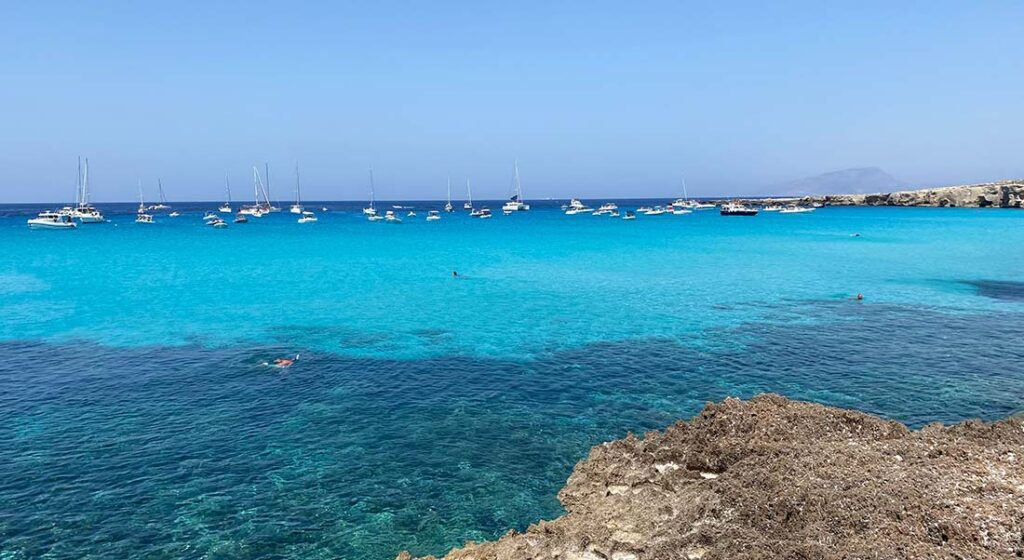
When I think back to my Sicily itinerary, the stop that makes me most nostalgic for the trip is Favignana, a small island off the coast of Trapani. The largest of the Egadi Islands (which also include Levanzo and Marettimo), Favignana can be visited as a day trip from Trapani, but on my next visit to the area I will be sure to stay for at least two or three nights. It’s just that amazing!
If you’re just taking a day trip to Favignana from Trapani, you can pack light. I wore a swimsuit under shorts and a tank top, and packed a tote bag with my boat tickets, a bottle of water, some cash, photocopies of my ID, water shoes, sunglasses and sunscreen. I left my passport, credit cards and most of my cash back in Trapani.
I’m not a confident cyclist, but I took the plunge and rented an eBike from one of the shops at the port. I looped around the east side of the island, visiting a number of famous beaches, but I ultimately returned to Cala Rossa (shown in the photo) for most of the day. It had the most beautiful, crystal clear water I’d ever seen and it was perfect for swimming.
#8 – Palermo

I made a terrible Italy travel mistake when booking my accommodation in Palermo. I chose a B&B with great reviews, but that was too far outside the historic center (down by Castello della Zisa) and poorly served by public transportation. When the temperatures hit forty-five degrees Celsius during my early-August visit, I could barely muster up the energy to walk to the nearest supermarket, much less all the way to the center.
If I was going to return to Palermo, I would stay right in the historic city center. I would probably start my search with Le Cupole if I was on a budget, or Hotel Principe de Lampedusa if I wanted to splurge a bit more. Both have great locations and great reviews.
Things to Do in Palermo
- Palermo has a lot of beautiful churches . However, unlike in Rome where you can walk freely into magnificent, world-famous churches like Saint Peter’s Basilica, it feels like every church in Palermo nickel and dimes you for an entrance fee. If you do pay to go inside, save your ticket as it often gives you a discount at the next church you visit.
- For me, the one church that was worth the admission price was Santa Caterina . The interior of the church itself is stunning, and a combined ticket gives you access to a number of vantage points on the upper level, as well as the historic monastery itself. Like Santo Spirito in Agrigento, the nuns here also prepare indulgent pastries and sweets that visitors can purchase.
- As you walk through the historic center you’ll also pass the Cathedral , the Quattro Canti (the Four Corners) and the Pretoria Fountain (pictured above).
- Although Palermo is famous for its street markets , I wasn’t particularly impressed. If you want to visit a street market in Sicily, I would recommend the fish market and surrounding streets in Catania instead.
Palermo Restaurant Recommendations
- Sicily is only 140 km from Tunisia, and the North African influence can be found in both the architecture and the food. Kus-Kus serves tagines (kind of like North African casseroles, you could say) with couscous (tiny pasta). I had their vegetarian couscous dish with hearty vegetables and flavorful broth, and can recommend it for anyone looking for a break from typical Italian dishes.
- There was one day in Palermo where I almost reached my breaking point. It was forty-five degrees out, I’d walked from my B&B into town, and then I’d walked to two restaurants that had good online reviews, only to find them both closed (despite their listed hours). I was ready to faint when I found Cuma , a restaurant focusing on healthy dishes like salads and poke bowls. The staff practically had to resuscitate me, but they did it with a smile! Poke Hawaiian Taste had a similar, but more limited, concept, and I also visited them for a salad one evening.
- Outside of the touristy area, but not impossibly far from the centre, Sapurito is a pizzeria and restaurant popular with locals. I had a lovely veggie pizza and glass of wine on their front terrace on my last evening in Palermo.
Keep reading for two great day trips from Palermo: Monreale and Cefalu.
#9 – Day Trip to Cefalu

Cefalu is an easy-peasy day trip by train from Palermo. The trip takes about an hour and is served by regional and intercity trains (I highly recommend the intercity trains as you can reserve a seat, while the regional trains can easily fill to standing room only during the high season). Once you arrive, it’s a short walk (less than ten minutes) to the beach, where there are free stretches of sand for the public, along with lots of sun chairs and umbrellas for rent from the beachfront bars and restaurants.
The water here can be quite rough. In fact, the beach was red-flagged for almost the entire day that I was there, with waves similar to those shown in the photo above (I went to add my own photo to the post and I realized I’d accidentally caught someone changing on the beach, so I decided to protect their modesty and use a stock photo!). If you’re not able to swim and don’t feel like suntanning, you can still explore the town’s attractions, including the beautiful Duomo (you can see its towers in the photo) and, rather funnily, the historic medieval laundry facilities (which are free to enter).
For lunch, I recommend Tatiana Melfa Bakery , where they have a surprisingly American-inspired menu (including veggie burgers and a scrambled egg breakfast… exactly what I’d been craving after eating so many brioches with gelato for the past three weeks!). On the way back to the station for the train ride home I detoured to L’Angolo delle Dolcezze , a gelateria popular with locals who flock to the little shop on the corner for creative, seasonal flavors. On a hot day you may have to queue, so leave yourself enough time!
Travel back to Palermo on the train and then onward to your next destination.
#10 – Day Trip to Monreale

From Palermo, it’s easy to travel to the hillside town of Monreale and its UNESCO World Heritage Site cathedral. I wrote an entire guide to the bus from Palermo to Monreale so that you’d have the most up-to-date information about bus stops, bus times, tickets and what to do when you arrive in Monreale. I recommend spending half a day in Monreale, and timing your trip to avoid the early-afternoon cathedral closure.
Travel back to Palermo on the bus and then onward to your next destination.
Sicily Itinerary Without a Car – Recommended Schedule
I followed this Sicily itinerary over about three weeks. Here is exactly how long I spent in each stop, and what I’d do next time:
- Catania – Three nights • Just right
- Siracusa & Ortigia – Three nights • Just right
- Noto – Day trip • Just right
- Taormina – Two nights • Either add a day (making one full beach day and one full town day) or eliminate entirely to add more time elsewhere
- Agrigento – Two nights • Just right
- Trapani – Three nights • Just right (when including a day trip to Favignana)
- Favignana – Day trip • Major regret! Stay at least one night!
- Palermo – Four nights • Move one night to Favignana
- Cefalu – Day trip • Just right
- Monreale – Day trip • Just right
- Overnight train to Rome – One night • Fixed duration
Should You Travel Around Sicily Without a Car Hire?
Absolutely!
Personally, I kind of went into Sicily without much of a plan, and I was so impressed by how well everything worked out for me, even without a car. It was so easy to get around and to find the things that I was looking for. Prices were generally quite low (outside Taormina) and even as a solo traveler I felt like I was getting a good deal on accommodation and dining out. If you’re able to visit in the shoulder season (April to mid-June, September and October) then you’ll get even better deals and encounter even fewer crowds.
Looking back, I am so glad that I chose Sicily as my Italian travel destination, and that I took the risk of managing the itinerary without a car. I can’t wait to return (seriously, I’m already thinking ahead to next summer and checking out apartment rentals on Booking.com)… maybe I’ll see you there!
Have you been to Sicily? What was your favorite spot on the island? Let me know in the comments!
(And of course, you can always ask me any Sicily travel questions in the comments too!)
Dreaming of Sicily? Pin this post for later!
Palermo to monreale by bus | how to visit monreale without a tour, how to get a pcr test in rome, italy for international travel, you may also like, the best things to do in cascais (a..., where to stay in calgary, canada – the..., is madrid worth visiting an honest traveler’s perspective, one day in barcelona, spain – an easy-to-follow..., what is the best time to visit the..., barcelona to paris train – tips for traveling..., visiting the alcazar of segovia – 10 things..., how to use the calgary transit app, the best places to visit in mumbai in..., a 7-day kerala itinerary (solo female traveler approved).
How to Travel in Southern Italy Without a Car
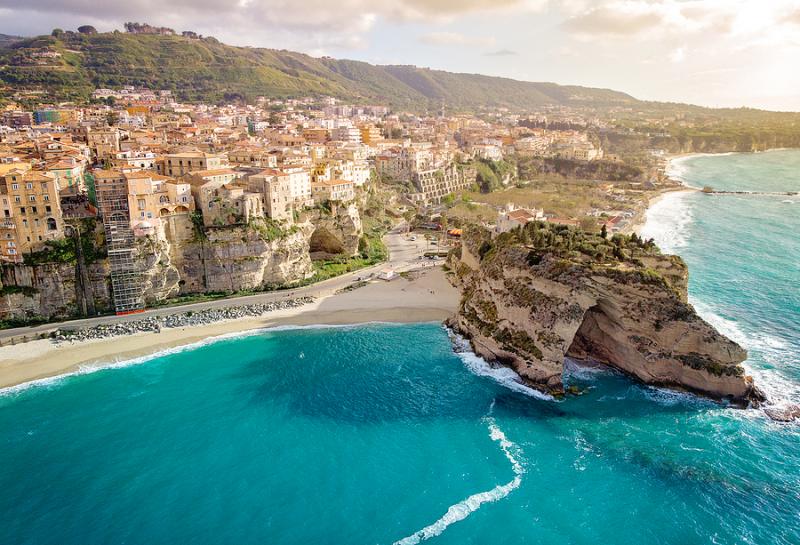
A word of advice: If you’re thinking of traveling around the mezzogiorno by public transport, don’t expect much help from the locals. " Ma sei matto ?!" implored one of my Puglian friends, Vanni, recently, when I told him about my plan to tackle the Gargano without a car, “It’s a crazy idea, man, don’t do it, I mean it. For your own sake!”
Vanni’s reaction was, on paper, understandable. The south and islands don’t make things easy for those who, voluntarily or otherwise, cannot drive in Italy. Train lines are limited and services infrequent. Buses are hot, cramped and forced to make their way along trafficky, pothole-filled roads. Navigating the inevitable delays and peculiar timetables is, I’m the first to admit, not for everyone.
For those with a bit of patience, though, things aren’t as insurmountable as they might first seem. The major cities, Naples and Palermo , are surprisingly well connected to the north. And even beyond, with a little effort, it’s possible to enjoy some beautiful less-trodden areas. And that’s the real joy of such a trip, isn’t it? Traversing varied and largely unspoiled landscapes, exploring anomalous towns and villages, where the air is fresh and the food is cheap and served in abundance.
Naysayers have laid waste to many such adventures. Don’t let them put you off. With a little foresight, and a sense of what realistically can and can’t be done, you can plan an itinerary that will be just as immersive as any journey behind the wheel.
Cross the boot, from Salerno to Bari
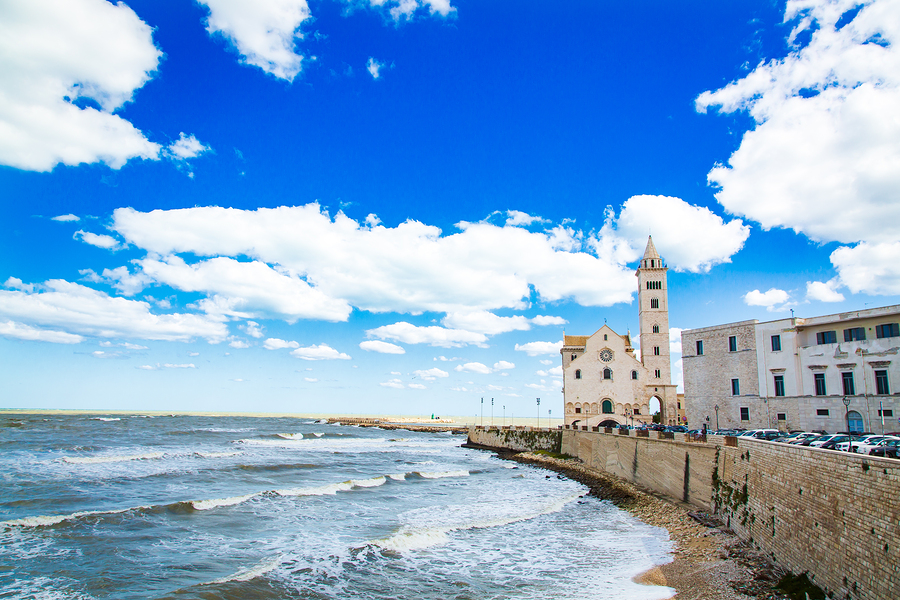
For first-timers south of Rome, this is a valid option and relatively easy to pull off. Start in the capital and take the fast train down towards Salerno. Instead of stopping there, though, get the connecting Italo bus to Matera which is celebrating its status as European capital of culture this year. You’ll need a couple of days to see the sassi , and take in the festivities. After that though, why not take the easy connection to Bari, the Puglian capital? The city itself has a bit of a dodgy reputation, but it really doesn’t deserve it. This is a beautiful, wind-lashed place, with a great white-washed old town. If the bustle is too much, though, and it is for some, a good option is to take one of the local regionale trains up and down the coast to find a quieter spot. While the beaches aren’t particularly glam, towns like Molfetta , Bisceglie and Trani are perfect places to stop for a few days, to take slow, ambling, passeggiate and enjoy the local seafood.
Give Salento a miss
There’s a fashion among Italians, and increasingly international travellers, for the southern tip of Puglia , and Salento in particular. It’s a charming area for sure, with beautiful clean sea, undulating dunes and wonderful tomatoes, bread and olive oil. For all its popularity, though, this corner of the peninsula remains pretty much inaccessible by public transport.
While all trains in the mezzogiorno come with delays, the Ferrovie del Sud Est takes the biscuit. I remember a few years ago asking the driver on a tiny, two-carriage, moving train, “Do you stop in Lecce?” to which he simply shrugged, “I don’t know.” To make matters worse, despite the relative calm of the farmlands and prati , the major seaside towns are still somehow overcrowded in the summer months. If you have a bike, it makes sense to stay just off the coast, in a small place like, say, Nardò away from the overpriced beach hotels. Given the other options, though, your energy is probably better spent elsewhere.
Slowly meander through Calabria
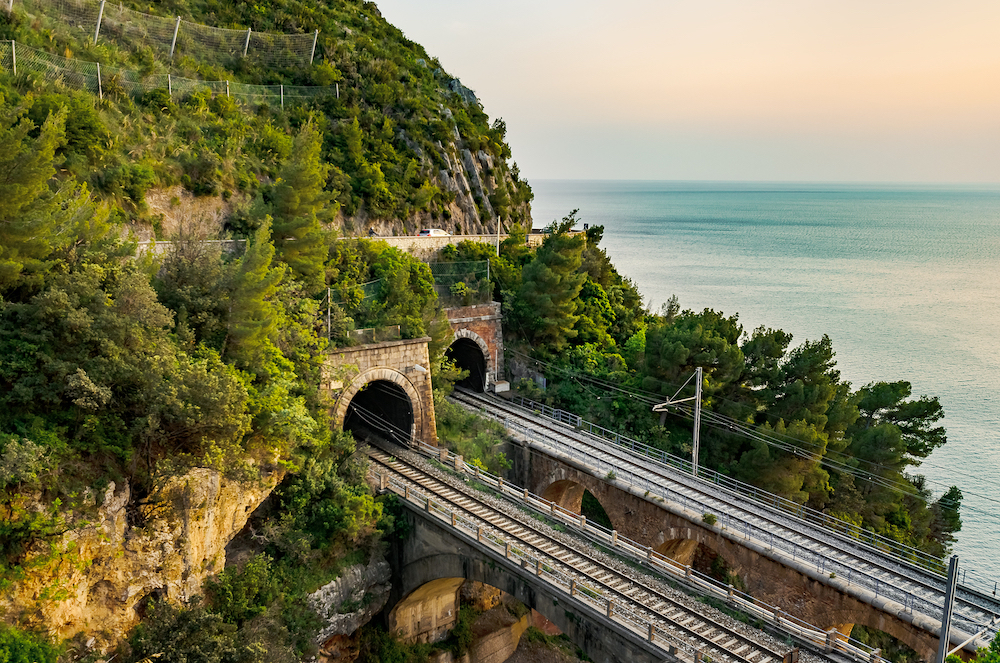
A picturesque view along a train route in Calabria
Even Italy’s most intrepid rail travelers are probably unaware that Calabria actually has a train line on its southern coast. The main ferrovia runs through the Tyrrhenian-facing towns like Tropea and Scilla which, it should be said, are valid destinations in their own rights. On the other side of the region, though, a more rickety and beautiful series of lines takes in a plethora of wilder, more romantic destinations. The area around Crotone in particular is a revelation. While blighted like much of the south by some ugly concrete resorts, it’s also home to long stretches of empty white sand and quiet historic towns. As the author Tim Parks recently put it in a piece for The Guardian, traveling in Calabria is not about instant gratification but simply accepting “the sun-struck languor of the hills and beaches, the odd mix of hospitality and indifference that characterises the locals, the general invitation to a warm, wine-fed fatalism.”
Take on Sicily — by bus
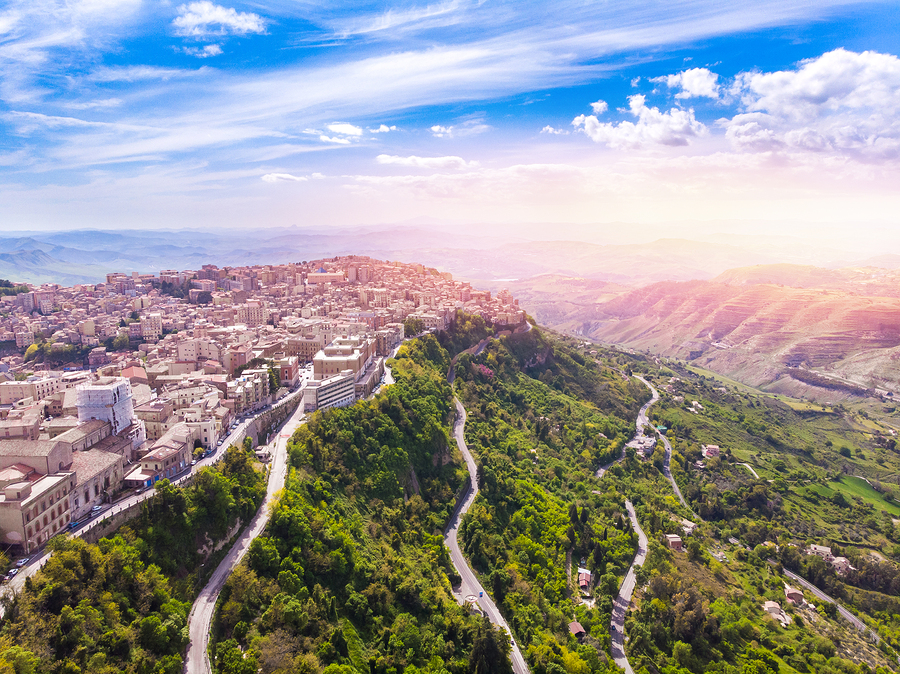
This last one is not for the fainthearted. If southern Italy is hard by public transport, Sicily, most people will tell you, is impossible. Yes, there’s an old train line, which stretches around the coast. It’s functional enough, but slow and a little dull. Adventurous travelers, though, might prefer a more unpredictable option. While native Sicilians staunchly deny their existence, local bus services do in fact exist, and, bizarre scheduling aside, boast quite comprehensive itineraries. Salemi and Interbus run services that loop Marsala , Mazara del Vallo and Enna to name just three often overlooked destinations.
The best base, though, is Ragusa , which is occasionally reachable by bus from Catania. Don’t be too alarmed if you find yourself unexpectedly dumped by a roadside in the blazing sun and told to change lines, whatever your ticket says. For better or worse that’s part of travelling on the island. If you pull it off, though, once in Ragusa you can use the local transport network to see the other baroque towns of Noto , Modica and Scicli . And that in itself should be reward enough.
You may also be interested in...
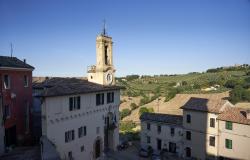
Latest property in Calabria
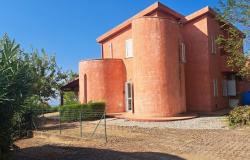
What to do in Calabria

Enjoying this Italy intel? You might also love:

Stay To Wander
Where To Around The World
Where to Stay in Lake Como Without a Car (5 Best Towns)
Note: Affiliate links may be used in this post. I may receive a small commission at no extra cost to you if you use my affiliate link to make a hotel booking. Full disclosure policy here.
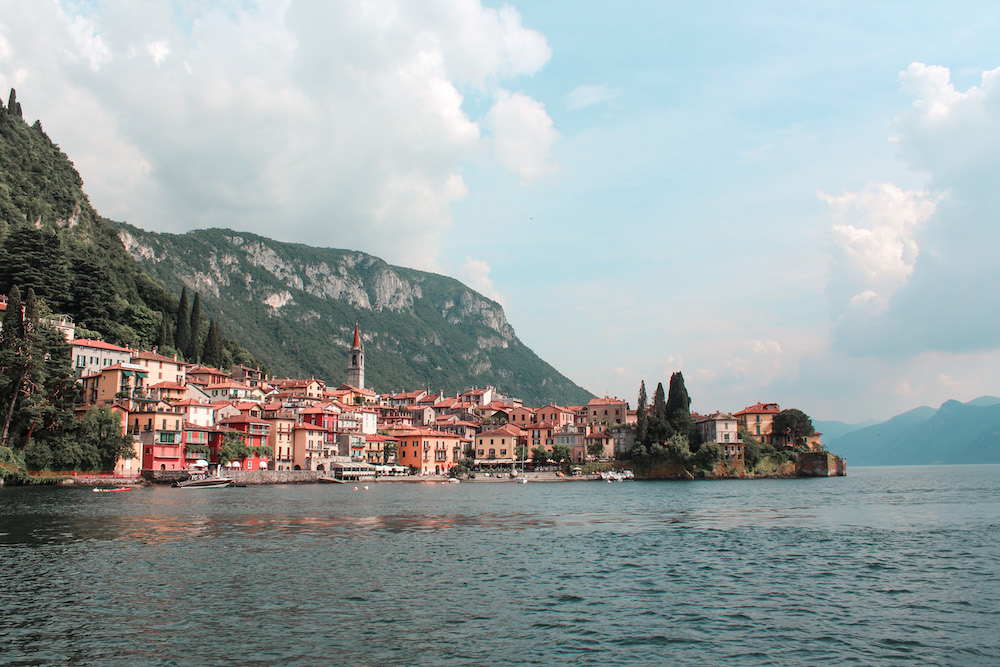
Are you wondering where to stay in Lake Como without a car?
Can Lake Como even be done without a car? (Don’t worry, the answer to that is yes!)
Here’s everything you need to know about visiting Lake Como, Italy without a car, including the best towns to stay in so that you can easily get around and explore all the lake has to offer.
Lake Como is a bucket list destination in northern Italy. While many travel guides suggest renting a car to explore Lake Como, it’s not a necessity, and you can still have a great trip without a car.
In fact, unless you’re an extremely confident driver, I would actually recommend not renting a car. Driving in Lake Como is not for the faint of heart, and a car-free trip can be much more relaxing.
However, it’s important to be strategic when choosing where to stay. Some towns around the lake are better than others when it comes to public transportation. If you only have a few days in Lake Como, you’ll want to make the most of your time and base yourself somewhere you can easily explore the lake from.
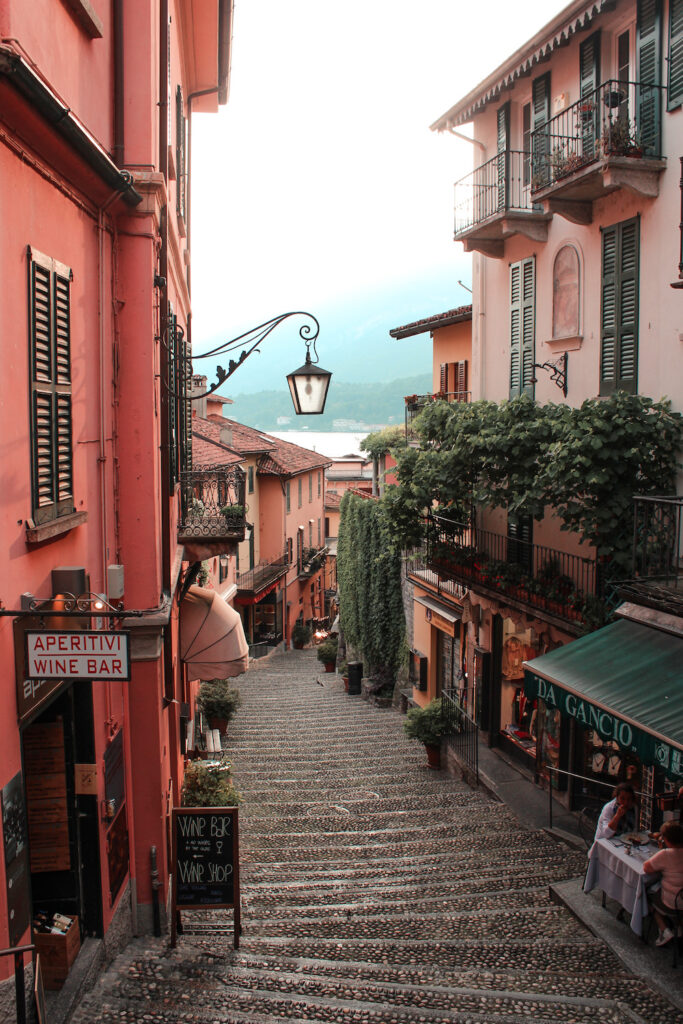
Getting Around Lake Como Without a Car
Is it easy to get around Lake Como without a car? Getting around Lake Como without a car is easier than you might think. While renting a car to visit Lake Como comes with some perks like more convenience and flexibility in your travel plans, it also comes with some serious drawbacks.
Many of the roads around Lake Como are extremely narrow and winding, and Italian drivers are notoriously crazy. This can make driving at Lake Como a nerve-wracking experience for less experienced drivers. Parking is also an issue, and you may end up wasting lots of precious time looking for a place to park.
Without a car, you have three main options for getting around Lake Como:
Only a few towns around the lake have train stations, but you’ll find that the ferry network and bus system are well-connected and get you where you need to go (although sometimes on “Italian time.”) I personally use the bus system a LOT when I’m in Lake Como and find it to be the best way to get around.
Lake Como is about 29 miles long and 2.5 miles wide, so it’s not all that large. It’s shaped just like an upside-down Y with one prong at the top that forks off into two prongs at the bottom.
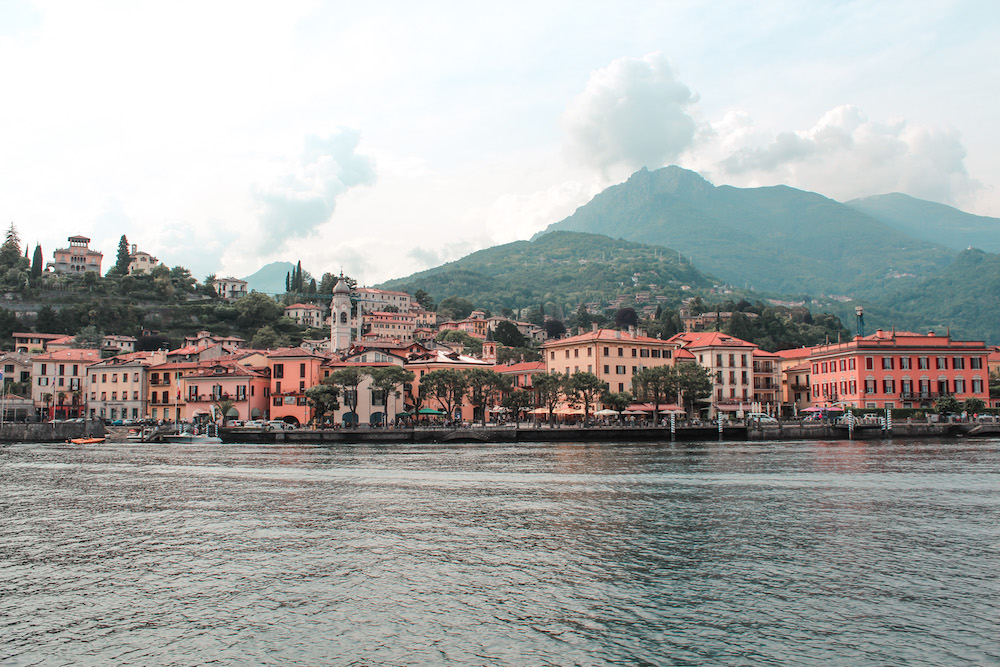
Best Towns in Lake Como Without a Car
I’ve been to Lake Como twice now without a car, and I’ve stayed in the same tiny village on the northern end of the lake both times. Gravedona is a beautiful and tranquil place, but it’s not necessarily the best place to base yourself for a trip to Lake Como, especially if you only have a few days to explore the lake.
While I wouldn’t recommend Graveona (as much as I personally love it), I would recommend the following five towns based on their transportation connections and overall charm and desirability.
All of these towns are perfect bases for your trip to Lake Como without a car based on access to trains, buses, ferries, and location on the lake. I’ve also included my top hotel recommendations for each town.
Tip: I use and recommend Booking.com for getting the best deal on hotels. If you book directly through a link on this page, I may earn a small commission at no cost to you. Thank you for supporting Stay To Wander!
Varenna is one of the best towns to stay in Lake Como without a car that combines charm and convenience. It’s one of the few towns on Lake Como with a train station, and you can get from Milan to Varenna in about 1.5 hours by train by taking the train from Milan to Lecco and then transferring on to Varenna.
Being located in the central part of the lake, it’s also convenient for visiting towns to the north and south. Varenna has good ferry routes and bus connections. It’s also known for being one of the most picturesque towns on the lake, so if you’re looking for a charming place to stay, this is one of your best bets.
Where to Stay: Hotel Villa Cipressi
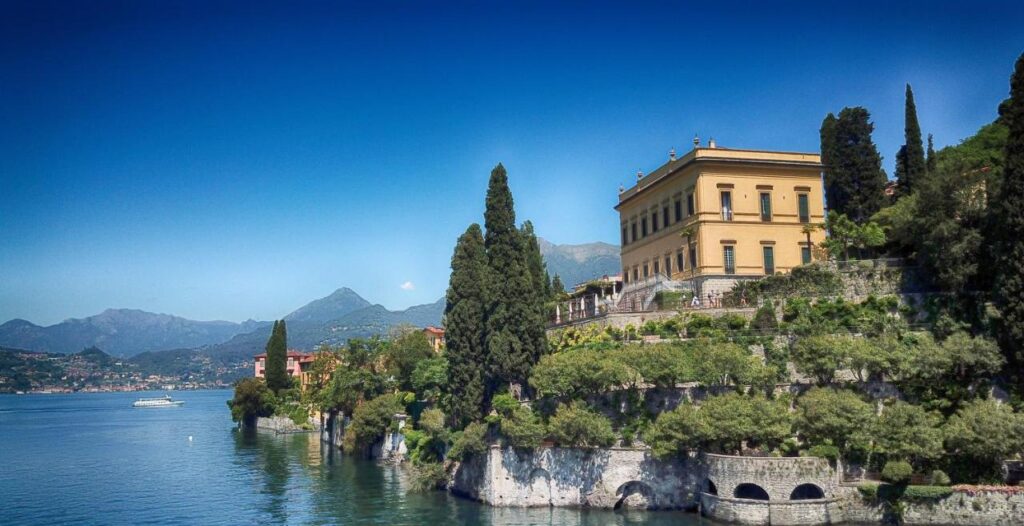
Hotel Villa Cipressi is one of the most impressive hotels in Varenna if you’re looking for an unforgettable stay. Perched on the edge of the water, this hotel is located on a beautiful property with botanic gardens you can wander while admiring views of the lake. Breakfast is included in your stay.
View on Booking.com | View on TripAdvisor
More hotels in Varenna, Italy:
- Luxury: Hotel Royal Victoria
- Mid-range: Albergo Del Sole
Como is the largest city of Lake Como located in the southwest fork of the lake. It’s a large city with almost half a million people, so keep that in mind if you choose to stay here. But it’s incredibly convenient, being located just forty minutes from Milan by train. It’s also the main transit hub of the lake.
Although it’s a larger city, it’s still incredibly beautiful, and you’ll have a lot more to choose from when it comes to things to do. Being larger, Como is also cheaper than some of the smaller towns along the lake. This is where to stay in Lake Como without a car if you’re on a budget or have limited time.
Where to Stay: Le Stanze del Lago Suites
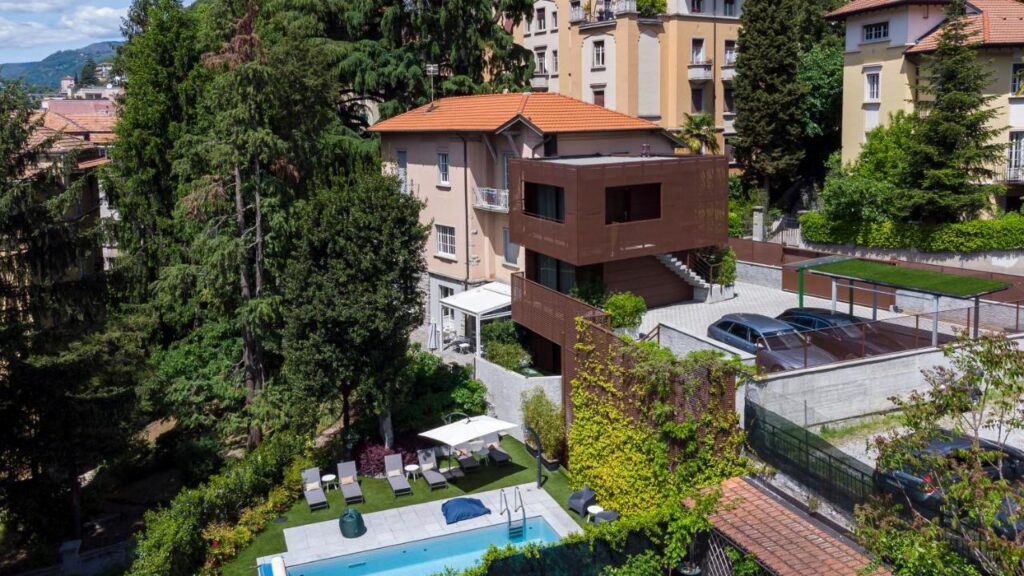
This affordable luxury hotel is located right in the heart of Como, making it a convenient place to base yourself for your trip. It’s a ten-minute walk from the train station and the Como lakefront promenade. This hotel also offers a pool, perfect for cooling off on a hot day if you’re visiting in the summer.
More hotels in Como, Italy:
- Luxury: Vista Palazzo
- Mid-range: Alessia’s Place
- Budget: Villa Corti
- Hostel: Ostello Bello Lake Como
Bellagio is one of the most famous towns in Lake Como because it’s extremely picturesque. However, this town doesn’t have a train station, so you may be wondering if it’s a good place to stay without a car.
The answer is yes, Bellagio is still a good place to stay in Lake Como without a car. Because it’s centrally located at the fork of the lake, you won’t have trouble with ferries or buses to get around. To reach Bellagio, you can take the train from Milan to Como, then transfer to the C30 bus or the ferry to get to Bellagio.
The train takes forty minutes, and then it’s an hour and ten minutes on the bus or 1.5 hours on the ferry to reach Bellagio. The town itself is small and looks like something out of a postcard.
Where to Stay: Grand Hotel Villa Serbelloni
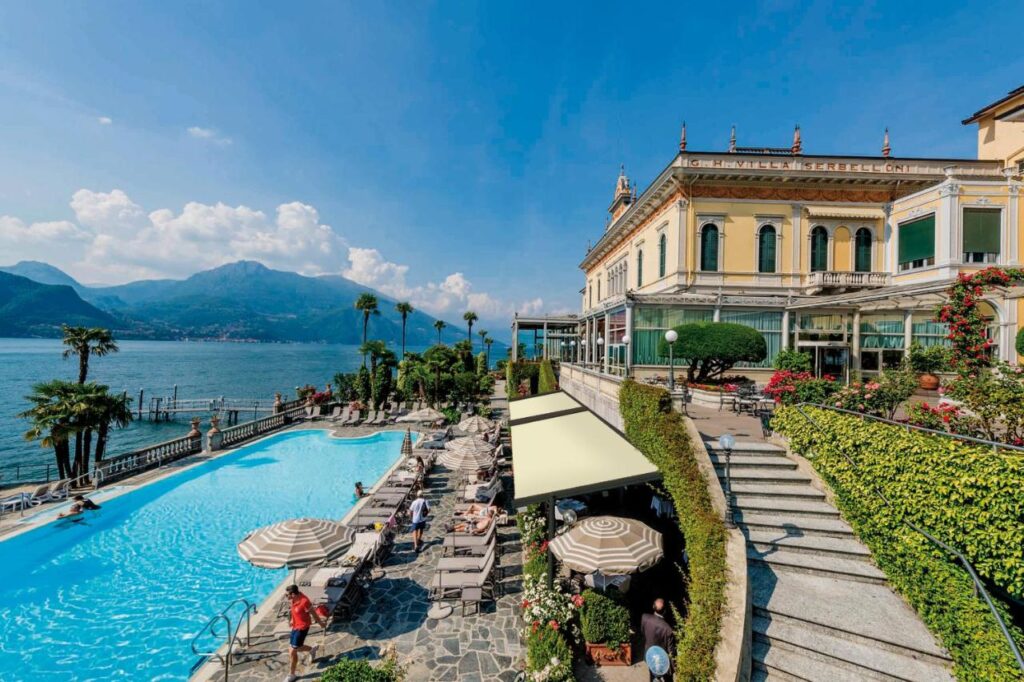
Grand Hotel Villa Serbelloni is one of the most luxurious hotels in Bellagio and offers stunning views of Lake Como. It features landscaped gardens, an indoor and outdoor swimming pool, and a spa. A delicious buffet breakfast is included with your stay. This is by far one of the best places to stay in Lake Como!
More hotels in Bellagio, Italy:
- Luxury: Hotel Belvedere
- Mid-range: Hotel Florence
Menaggio is another one of the best places to stay in Lake Como without a car. This lovely town in the central part of the lake blends quaint charm with convenient transportation options.
It’s another one of the few towns on the lake that has a train station, making it easy to get here. From Milan, you can take the train to Como, then transfer on to Menaggio. In total, it takes a little over two hours. This town also has excellent connections when it comes to the bus and ferry.
Where to Stay: Hotel Bellavista
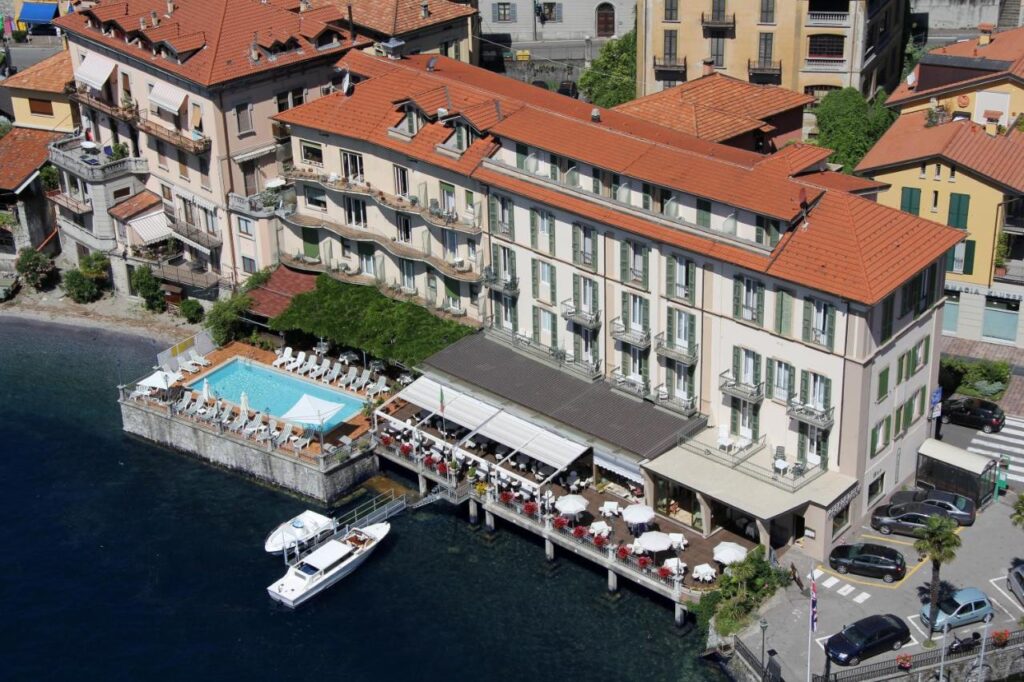
If you’re looking for where to stay in Lake Como without a car, Hotel Bellavista in Menaggio is a great option. This centrally-located hotel is just a two-minute walk from the train station and is positioned right on the waterfront. You’ll enjoy a lakeside swimming pool at this hotel, perfect for cooling off on a hot day.
More hotels in Menaggio, Italy:
- Luxury: Grand Hotel Victoria
- Mid-range: The Club Guest House
- Hostel: Lake Como Hostel
Finally, if you’re wondering where to stay in Lake Como without a car, Cernobbio is one more town that I would recommend if you’re looking for somewhere beautiful and quaint, yet still convenient.
While Cernobbio does not have a train station of its own, it’s one town away from the major transit hub of Como. This means that you can take the train from Milan to Como in forty minutes, then transfer to the C10 bus and reach Cernobbio in about twenty minutes, for a total journey time of just one hour.
Cernobbio is known for how picturesque it is, and it’s a lot smaller and quieter than bustling Como. You can also easily explore the other towns on the lake by bus or by ferry from Cernobbio.
Where to Stay: Hotel Asnigo
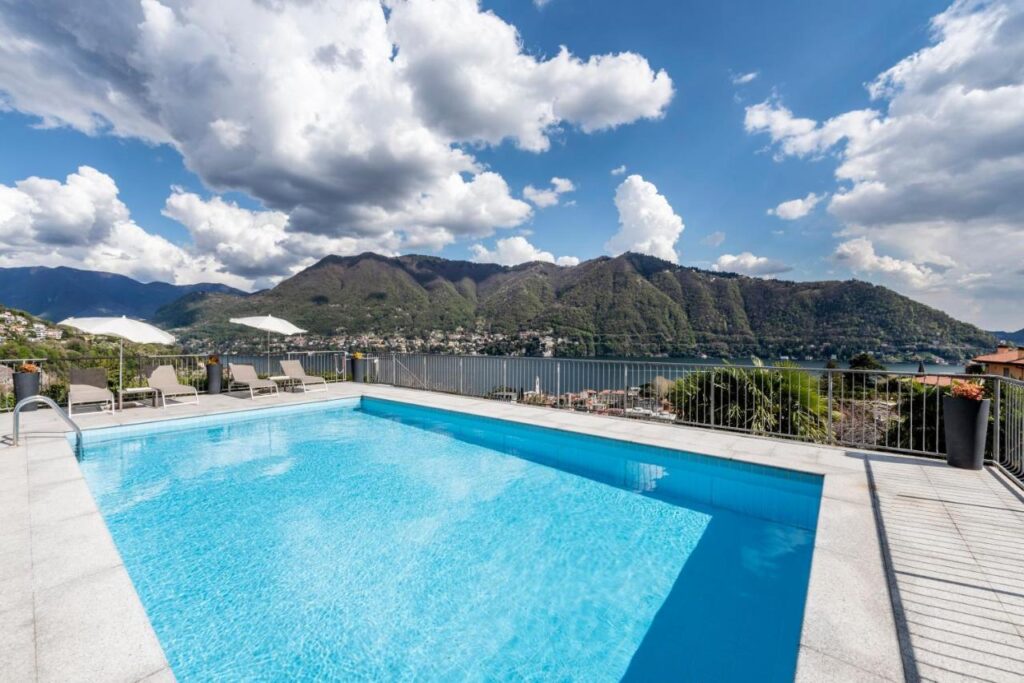
While Cernobbio is known for being home to the ultra-luxury $1,000+ a night Villa d’Este, Hotel Asnigo is a more reasonable alternative. If you’re looking for somewhere that’s affordable but still has great amenities like free breakfast and a swimming pool, this hotel is one of the best places to stay in Lake Como.
More hotels in Cernobbio, Italy:
- Mid-range: Hotel Centrale
- Budget: Albergo Giardino
Where to Stay in Lake Como Without a Car
This guide showed you where to stay in Lake Como without a car.
To recap, my top picks for where to stay are:
- Varenna: Hotel Villa Cipressi
- Como: Le Stanze del Lago Suites
- Bellagio: Grand Hotel Villa Serbelloni
- Menaggio: Hotel Bellavista
- Cernobbio: Hotel Asnigo
Have a great trip and enjoy your stay in Lake Como!
Related Guides:
- 10 Best Luxury Hotels in Venice, Italy
- Where to Stay in Cinque Terre, Italy (Best Towns & Hotels)
- Where to Stay in Florence, Italy (For Every Budget)
- 15 Best Luxury Hotels in Rome, Italy
- 12 Best Hotels in Ischia, Italy: Top Places to Stay
- 7 Best Luxury Hotels in Positano, Italy
You’ll Also Love
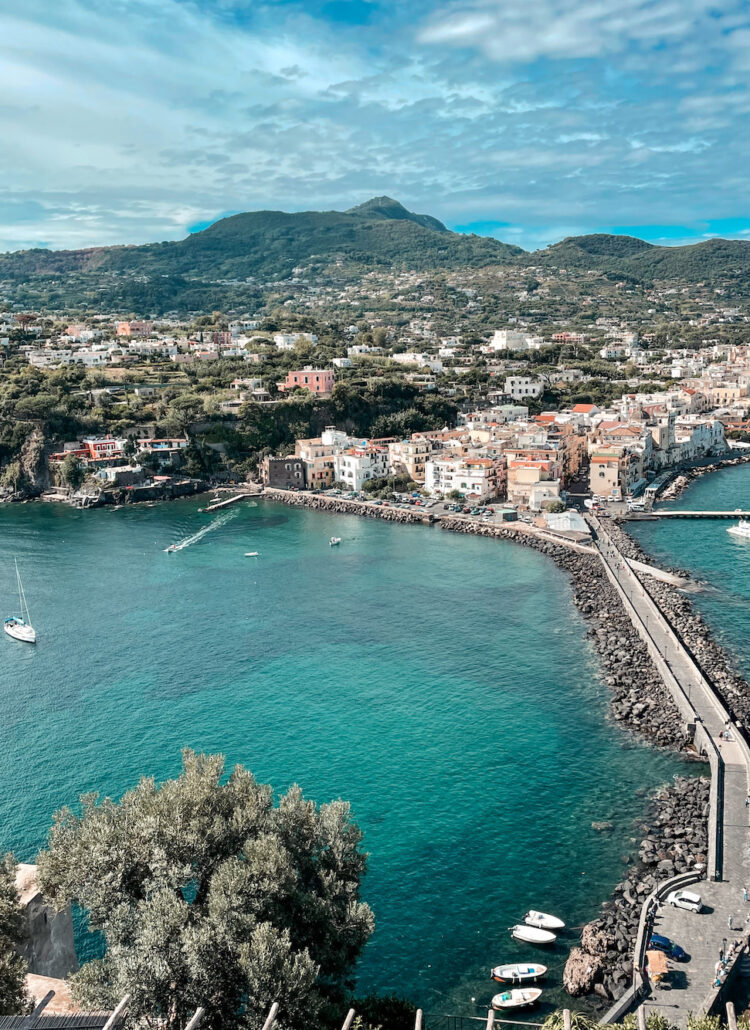
Where to Stay in Cusco, Peru
Copyright © 2024 Stay To Wander · Privacy Policy · Disclosure
- Jul 31, 2020
- 17 min read
How to travel through Puglia without a car: A complete two-week itinerary
Updated: Jan 21, 2021

You’ll hear many times that traveling in Puglia , the southeastern heel of Italy's boot, is easiest with a car. This is true. It gives you the flexibility to stop in quiet little villages with sparse public transportation, mozzarella-making farms in the trulli-studded countryside, and idyllic rocky beaches only accessible from narrow dirt roads. I enjoyed all of those things and more during a week of road-tripping with friends from Ostuni to Gallipoli to Matera in a trusty Jeep.
But experiencing Puglia is also possible and enjoyable without a car, which is great news for those jaunting through the region alone or those who simply would rather sit back and let a train do the navigating. I know because I did it myself, using public transportation (which is way cheaper than renting a car and still shows you amazing views of the sea and countryside) to visit five towns during a dreamy two-week solo trip in Puglia. Here’s where I went and what I think you should do when you go.
Route overview

Bari ---> Polignano a Mare ---> Monopoli ---> Locorotondo ---> Lecce
This itinerary is bookended by two main cities with three smaller towns in between. If you're entering and leaving Puglia from Italy, it's easy to do so via train, as there's a major station in Bari. If you're coming from a different country, you'll likely fly in and out of Bari or Brindisi, which is about a 1.5-hour train from Bari and a half-hour train from Lecce. See the "getting there" section below each stop for detailed instructions about transportation between each city.
Note: "Replacing" Locorotondo with Ostuni, a beautiful city in the same sub-region of Puglia, would make this journey a little bit easier in terms of transportation. However, I experienced Ostuni with a car and cannot vouch for its convenience otherwise — and Locorotondo is well worth the effort!

Luggage : Since this is a carless itinerary, packing light will make your life easier when you're walking between bus/train stations and your hotels (and leave you more room for souvenirs). Luckily, most of these walks should only take you about 15 minutes as long as your accommodations are in the city center. You can always do laundry while you're there.
Transportation : I'm providing transportation instructions below, but for booking tickets or double-checking details, Omio and Rome2Rio are really good resources. These don't always have complete information, though, especially for buses, so when in doubt, it's best to visit a tourist office.
Language : Most people working in the service industry in Puglia speak English, so you don't need to know Italian to communicate during your trip. One of the great pleasures of Puglia, though, is chatting with friendly strangers (especially the elderly, who usually don't speak English), so it's definitely a plus to know some phrases.
Siesta : All of Puglia totally shuts down after lunch between about 2 p.m. and 5 or 6 p.m., so expect shops and restaurants to close at that time. This is the perfect opportunity to lounge on the beach, nap in your room, or take walks and pictures of town with no photobombers.
Reservations : Even if you feel like you have a small town all to yourself, it's still best to make dinner reservations if you have your heart set on any particular restaurant.
Markets : Pugliese cities don't necessarily have big, open-air produce markets every day like they do in Florence or Rome. These are typically just once a week (refer to this article for schedules in each city). However, you'll always be able to find small kiosks and shops selling local produce throughout the city center.
Aperitivo : Though pre-dinner spritzes are very popular in Puglia, free snacks are not as typical as they are farther north, so don't be surprised if your glass of wine doesn't come with a complimentary bowl of chips. Just ask for taralli or crispy fava beans, and they'll only cost € 1 or so.

Two nights in Bari
Bari, the capital of Puglia, has the most electrifying energy, mainly because of the old town, Bari Vecchia. The neighborhood is a colorful maze of narrow streets, with laundry billowing in front of slender, three-story homes and loud-mouthed locals sitting in the open, doing anything from making orecchiette to dancing to the Black Eyed Peas. The Barese use the streets as their living room, which is why walking through Bari Vecchia feels like you’re in someone’s house — and why you should definitely say buongiorno or buonasera to everyone you pass. I’ve heard people call Bari dirty and dangerous (the same things they say about Naples), but I never felt unsafe, and it might have been my favorite city in Puglia.

Spend lots of time walking around Bari Vecchia , enjoying the colors and shade of the small streets, smiling at busy locals, and checking out the orecchiette-rolling technique of the pasta ladies who make this neighborhood famous. You’ll see them working at wooden tables in front of their homes, chatting and looking at passersby while their hands do quick work out of muscle memory. Largo Albicocca is a particularly beautiful square in the old town and is very happenin' at night.
Sights to look out for in Bari are the Basilica di San Nicola , Castello Normanno-Svevo, Piazza Mercantile , Basilica di San Sabino , and Petruzzelli Theater . You can visit these on your own or book an experience — maybe a historical walking tour, a street-food tour, or a cooking class. I joined Free Walking Tour Bari and loved it.
The Lungomare is a long path along the Adriatic sea. It's a scenic place to watch the sunset and provides free entertainment in the morning, when fishermen sell their day's catch, clean squids, and tenderize octopus by hurling it repeatedly against the pavement.
The modern part of the city is less charming than the old town, but you can find lots of shopping and trendy restaurants and cafes in the Murat district .

Where to stay
Unless you want a view of the sea, I'd suggest staying in the heart of the action in Bari Vecchia. I stayed in this Airbnb on Strada Barone and can’t recommend it enough. From my front door, I could see inside a pasta lady’s kitchen, where the table was always full of drying orecchiette. To left, a kind man ran a produce stand and promptly began his Peroni drinking at 10 a.m. And a few steps to the right, four ladies cranked out cavatelli and orecchiette, which was very convenient when I decided to buy pasta to cook at home, using ingredients from the fruit man and a nearby cheese shop.

What to eat and where to get it
On the street: One of my favorite things about Bari is that you don’t have to sit at a restaurant to eat well. It's fun (and cheap) to dedicate at least one evening to trying the city's best street foods, especially those of the fried variety. Some crispy delights include:
-- sgagliozze , deep-fried polenta squares (Try them at Try Donna Carmela ’s in Largo Albicocca or Maria ’s on Strada del Carmine)
-- panzerotti , pizza dough that’s stuffed with anything you like and fried ( Rosticceria Dirello near the San Sabino church fries them to order)
--and popizze , salty little balls of fried bread dough. Buy these along the Lungomare , where locals like to set up chairs, grills, and bubbling pots of oil so they can fry food and listen to music during the sunset.
--Non-fried but very luscious is the famous olive, tomato, and oregano focaccia Barese . El Focacciaro makes a good one.
At the butcher: In Puglia, it's common to visit the butcher not only for meat to cook at home but also for a snack, like the traditional Sunday-lunch dish braciole di cavallo , which are rolls of thinly sliced horse meat stuffed with parsley, cheese, and pork fat. I loved watching the cooks at Beccheria on Strada Vallisa grill meats for sandwiches right behind the butcher case, which is also stocked with beef, pork, chicken, and sausages.
From the sea: The freshest raw seafood can be found at the seafood markets on the piers surrounding Teatro Margherita. Go in the morning (ideally before 10 a.m.) for a snack of raw octopus , allìive (cuttlefish), or, if you're visiting between September and April, a plate sea urchins with crusty bread for scooping out the roe. You might also try raw mussels ; I got them from a friendly fisherman named Gino, and I'm still alive.
At home: Puglia produces some of the best olive oil, wine, and fruits and vegetables in Italy, which means staying in for dinner is a wonderful idea. You'll want to buy orecchiette from a pasta lady anyway, so why not cook it at its absolute freshest? Complete the meal with fresh meat or seafood, a typical vegetable like cime di rapa , and some in-season fruit for dessert.
Alla gelateria: Gelateria Piccinni is simply superb.
Finally, if you do sit down in a restaurant, be sure to eat the Barese specialty riso, patate, e cozze , which is a layered and baked dish of rice, potatoes, and mussels.
I wrote a story for Heated Mag about eating in Bari ; check it out for extra details.

1 night in Polignano a Mare
Polignano a Mare is best known for its famous beach, Lama Monachile, which you may have already seen on Instagram. It's a small rocky spot nestled between cliffs that tower over clear, turquoise water. It is the main attraction of the small town, which, though beautiful, I found to be a little bit Disney-fied and less sincere than the other cities I visited. Nevertheless, it is a very nice place to spend a day or one night.
Getting there from Bari
Easy. Trenitalia has a half-hour train from Bari Centrale (a 15-minute walk from the city center) to Polignano's train station (about 10 minutes from the city center).

I was happy to spend most of the afternoon at Lama Monachile , swimming in the cool water and watching braver-than-me children jump off the cliffs. Unless you show up first thing in the morning, the small beach will be very crowded. Just go with the flow, enjoy the people watching, and bring a sandwich for an inexpensive lunch.
After a day of swimming, clean up at home and head out in the evening for aperitivo in the piazza of your choice. Peaceful Piazza San Benedetto has top-notch cat-watching and SanB é , a good place for a Campari spritz and crispy dried fava beans.
Though Polignano is popular with tourists, its passeggiata time does feel like a true reflection of the Italian tradition. Before dinner, stroll through the city and take a break in a piazza, watching kids behave crazily and the elderly population shoot the breeze. Piazza Vittorio Emmanuele is the main square, but I preferred eating gelato in Piazza Aldo Moro , which was still lively after dinner.
Soak in views of the beach and the distant sea at sunrise and sunset from viewpoints scattered around the city.
Staying east of the beach means you'll still have easy walking access to the city center but will enjoy more peace and quiet. I found just that on Via Sirene at Dims Polignano .

Seafood may be the obvious choice in an oceanside town, but Polignano also loves its meat , which is apparent at Osteria Piga . They bring taralli (the region's famously hearty, tire-shaped crackers) out with the bread (a classic move in Puglia) and serve their delightful beef tartare with wasabi-scented candied orange. I also had their perfectly pillowy gnocchi with Gorgonzola sauce and taralli crumbs.
An obligatory try is Polignano’s Caffè Speciale , invented and made famous by Mario Campanella at Il Super Mago del Gelo , which translates awesomely to The Super Wizard of Frost. Caffè Speciale is a warm coffee drink with cream, sugar, lemon peel, and amaretto — sweet and citrusy yet not too aggressive for the morning.
When you want gelato (and you will, because it’s Italy), I kindly advise you not to indulge your curiosity of a certain sign reading “World-Famous Potato Gelato…” Instead, try Gusto Caruso .

3 nights in Monopoli
Peaceful Monopoli is the perfect accompaniment to chaotic Bari, but that doesn't mean it's boring. The fishing town has an old port, a castle, beaches, churches, and such a lovely look, thanks to its many white buildings with colorfully painted shutters and creatively adorned balconies. You hear all the time that certain Italian cities are perfect to "get lost in." Well, that's really true here. Though the beach and main streets are full of out-of-towners, you'll find plenty of small alleyways with no one in sight, and each one will seem prettier than the last.

Getting there from Polignano a Mare
Take the five-minute Trenitalia train to the Monopoli station, which is about a 15-minute walk from the historic center.

An introductory walk in Monopoli starts at Porto Vecchio , the old port, which is full of little blue fishing boats and socializing fishermen. Continue on to the Castle of Charles V , a fortress from the 1500s. You can't go inside, but you can admire details on the stone — like fossilized seashells. Keep walking, and you'll find bars, a bastion with cannons, and people tanning on big rocks in the water.
Eventually, you'll run into Cala Porta Vecchia , the main beach just outside of the city walls. Monopoli has a prime location along the Capitolo , a long stretch of clear-watered beaches, which means you can take the bus to any spot you like. But I was happy at this charmingly busy beach, lying in the sand and floating in the warm water with a view of the city.
Cattedrale Maria Santissima della Madia is the main church with a cool backstory. The original church, first built in 1117, didn't have money to finish the roof. Legend has it that a local man named Mercurio prayed for the material to build it, and the Madonna came to him in a dream, telling him to go to Porto Vecchio. He did, and sailing right into the port was a miracle: a wooden raft carrying a painting of the Madonna. The citizens carried the painting to the church and used the wood from the raft to finish the roof. You can still see the painting and the original wood in the new Baroque church today.
Look up close at the Chiesa di Santa Maria del Suffragio , and you'll see why it's nicknamed the Halloween Church. The purgatory church, built as a place for sinners to pray for forgiveness and get the golden ticket to heaven, is decked out with creepy skeletons on the outside and has 18th-century mummies inside — something different!
I'm not usually so churchy, but I guess something heavenly came over me in Monopoli. Chiesa di San Domenico , my favorite in the city, has a big rose window that's just lovely to look at during the sunset.
Monopoli isn't such a doing city. Take lots of walks and lots of sits, preferably in Piazza Vittorio Emanuele for the best people-watching in town — and a group of nice people selling extremely juicy olives.
While the pastel-colored old town is more picturesque, the bright orange, more modern part of the city is also sweet to explore. Check out the streets running from Piazza Vittorio Emanuele, and you'll find shops to buy everything from local wines and cheeses to fancy clothes and sunglasses.

You can't go wrong with a little hotel or B&B in the historic center. I loved watching people talk, walk, and eat from my balcony at this Airbnb .

Monopoli has no shortage of wonderful seafood . I really liked Il Guazzetto 's elegant crudo on ice, as well as their endless selection of pasta dishes and rendition of ciambotto , the Pugliese fish soup with a spicy tomato broth and croutons.
My favorite meal, though, was more of an assortment of classy snacks and booze at My Wine . There you can enjoy high-quality local wines for € 5 a glass with fabulous food, like sea bass carpaccio with dried raspberries and the best-presented plate of butter and anchovies you've ever seen.
It doesn't get more Pugliese than cavatelli with mussels and fava-bean purée . I ordered this at Trattoria San Domenico and ate every bite.
Apluvia had only been open for a week when I was in Monopoli, but you wouldn't know it. I had perfectly cooked rosemary-scented squid with pancetta and peas, and the people next to me seemed to be enjoying a very good aperitivo deal with lots of seafood snacks.
Make room daily for the perfect peach granita at frescolatte gelateria di puglia .

2 nights in Locorotondo
Alberobello is Puglia's most famous place to see trulli, 700-year-old stone houses with cone-shaped roofs, but Locorotondo feels like a more genuine home base in the Valle d'Itria. With pristine cobblestone streets, views over the trulli-dotted valley, and a unique architectural style called cummerse, Locorotondo looks like the setting of a fairy-tale. It has all of the makings to become overly touristic, but it isn't. I felt a sense of peace and comfort when I was there and wished I had stayed at least one night longer.
Getting there from Monopoli
Locorotondo is on the opposite side of a big hill from Monopoli, so there's no direct train. I took the Ferrovie del Sud (FSE) bus from Monopoli (the bus stop was about a 15-minute walk from the city center). About 45 minutes later, it dropped me off in the center of Locorotondo, just a five-minute walk from my B&B.

Meander through the city center to appreciate the cummerse , the name of Locortondo's slender rectangular buildings, whose steeply slanted stone roofs meet in a narrow, flat peak. The typical Locorotondo cummerse is bright white, has adorable chimneys, and is dutifully decorated with flowerpots. You'll also see alluring arches , tiny churches , and shops selling ceramics and paintings of Locorotondo.
A circular walkway surrounds Locorotondo (which means "round place"), and even though the sea is nowhere in sight, it's called the Lungomare . Even without the blue of the ocean, the view is pretty spectacular: trulli, vineyards, and endless haybales flecking the farmland.
The perfect passeggiata is through the park near Piazza Dante and along Corso XX Settembre, followed by aperitivo at Caffè della Villa , a truly joyful place to watch the evening transpire.
See more of the Valle d'Itria. You could take a day trip to Martina Franca or Cisternino, which are nearby and easily reachable by bus or train. Even better, you can explore the countryside by bike . I did a half-day tour with ebike Puglia that fulfilled all of my Pugliese dreams: crumbling trulli, cute goats, countless cacti sprouting from brick-red soil, and lunch at a farm, Masseria Madonna dell'Arco , which serves cheeses made by milk from its own gigantic cows.
If you're in town on a Friday, check out the morning market in Piazza Antonio Mitrano . It had one of the most tantalizing selections I've ever seen of local produce, cheese, and taralli in all flavors from sweet to spicy.
Look out for local wines . Locorotondo is famous for white wines made from Verdeca, Fiano, and Biano d'Alessano grapes, and its red wine made with Susumaniello is tasty and robust as well. I Pastini is a reputable winemaker with a tasting room in the city center and a nearby vineyard if you'd like to make a mini excursion.

It blows my mind that I was able to book a beautiful, three-room bed and breakfast in the heart of Locorotondo on my budget — but I was, and it was my favorite stay of my entire trip. Da Concavo e Convesso has lovely, comfortable rooms with balconies and stone walls, a rooftop with a bird's eye view of the cummerse and the Church of St. George, and cakes for breakfast cooked by the owner's mom. I will remember it very fondly.

Now that you're in the land of capocollo (the famous salume from Martina Franca), I'd suggest indulging in some Pugliese meat specialties, like bombette (rolls of pork or veal stuffed with capocollo and caciocavallo cheese) or pasta with polpette al sugo (meatballs in a rich tomato sauce). I had the latter and an excellent rabbit dish at Bina Ristorante .
U'Curdunn is another splendid place to try local dishes, including seafood. Their outdoor tables are particularly picturesque.
Since Locorotondo is smack in the middle of prime Pugliese farmland, I can't recommend lunch at a farm enough. It's the best (and most scenic) way to try local meats, cheeses, and produce in a sustainable and educational setting. It is hard without a car, though, so I would suggest joining the aforementioned bike tour or another experience that provides transportation to a masseria.

4 nights in Lecce
One day is long enough to see Lecce's historical center, but it's relaxing to take your time through Puglia's Baroque capital, nicknamed the Florence of the South because of its many fancifully designed buildings. In addition to ornate churches and Roman ruins, Lecce has easy access to small cities and beaches via bus, some of my favorite cheap eats in Puglia, and a beautiful golden hue at sunset.

Getting there from Locorotondo
This is the hardest part of our public-transportation journey, but it's really not that bad. Take the 30-minute FSE bus from Locorotondo to Fasano. From there, you could take another bus to the Fasano train station — which is almost 2 miles from the bus stop, too far to walk with luggage if you ask me — or call a taxi for no more than 15 euro. From there, you'll hop on an easy one-hour train to Lecce, whose station is just a 10-minute walk from the heart of the city.

Lecce's Duomo and belltower are grand and imposing, but even more striking is Basilica di Santa Croce , whose intricate facade has enough symbolism for a whole college course. It's worth taking a walking tour of Lecce (I did this one ) to get a better, more meaningful understanding of the church's design — as well as the other sights in the city.
Even without a tour guide, it's easy to appreciate the details of Leccese architecture , which has been influenced over the centuries by French, Spanish, Greek, Norman, and Roman visitors. See how many faces and figures you can spot carved over doorframes and supporting balconies, and notice how the yellowy Leccese limestone, which is very soft and malleable, has crumbled over time to give each building lots of different patterns and textures.
My favorite place in Lecce is the ancient Roman theater , which is hidden among quiet streets and full of resting cats. This is one of the city's main attractions but is mysteriously calm, which makes it a peaceful place to stop during a long stroll. You can also pay to enter the accompanying museum.
The Roman amphitheater is the other (and more bustling) Roman ruin in town, as it's located in the main square, Piazza Sant'Oronzo .
Lecce's city walls are accessible by four main porte, or doors. It's fun to go beyond the city walls to explore the more modern part of town. Just a quick walk down the block outside of Porta Napoli led me to two delicious bakeries and a more genuine view of local life.
You can obviously souvenir shop in any city, but I'm specifying it here because I noticed that Lecce has a particularly high concentration of shops selling pieces by local artists. Most of these are on major thoroughfares Via Palmieri and Via Libertini. They sell typical Pugliese products like paint-splattered dishes (made with dried olive branches) and pumi , ceramic good-luck charms that people often put on their balconies to keep evil spirits away. I found both and more at La Salentina and Il Ripostiglio di Atena .
Two things I would have done if I'd had time: 1) There's a Jewish Museum in Piazza Santa Croce, which was the heart of Lecce's Jewish neighborhood during the medieval age. 2) There are frequent buses to Otranto , a beautiful city with caves, a castle, and a fancy cathedral right on the sea. Many other beaches are accessible from Lecce; you can grab a bus schedule from one of the tourist offices.

You'll enjoy your stay anywhere in Lecce's city center, but try to avoid booking anything on Via Libertini, which can get very busy.

The pasticciotto : You can find these dense, cream-filled short-crust pastries, typically eaten for breakfast, anywhere in Puglia, but they come from Lecce and taste noticeably better there. They're shaped like oblong muffins and taste like sugar cookies with an eggy pastry cream center. My Airbnb host left me four of them from Pasticceria La Fornarina , and I happily ate one every day for breakfast.
The rustico : When I learned that these buttery discs of puff pastry with mozzarella and tomato also contain bechamel, I was like, "Is that really necessary?" It is. The addictive savory pastries are the best cheap lunch in Lecce. I loved them from La Fornarina and Schipa Serena .
The caffè Leccese : The special ingredient in Lecce's iced espresso is almond milk — but don't picture the sad, watery stuff from Blue Diamond (sorry). Almond milk in Salento is already sweet (so there's no sugar added to the coffee), and it has an almost syrupy consistency that makes this drink a real treat in the afternoon. Find it at any coffee bar.
Ciceri e tria : I first learned about this dish in, ironically, one of my culinary classes about nutritious food. The first ingredient, chickpeas (ciceri or ceci), is quite wholesome, but then they're combined with a deliciously luscious flat pasta called tria, half of which is boiled normally and half of which is fried into crispy, crouton-like bits. I love this dish because it transforms cheap, readily available ingredients into a really satisfying, multi-textured meal. That's why it has remained a staple of the Salento diet for the last 2,000 years. You can order it at almost any restaurant in Lecce, but I loved it at Trattoria Le Zie , which feels like someone's living room.
Spritzes and snacks : You must make it your mission to eat as much burrata as possible in Puglia. Luckily, cheese goes well with wine and spritzes, which is a wonderful reason to have snacks for dinner — or apericena. There are a lot of nice places to do this along Via Umberto and Via degli Ammirati . Enoteca Mamma Elvira can recommend local wines by the glass to go with their small plates, like burrata with chicory and eggplant rolls with scamorza, while Mamma Lupa has countless bruschette topped with typical Pugliese ingredients.
Gelato : Finally, make Baldogelato your go-to for airy gelato in flavors both classic and inventive — plus a special of the day.
Recent Posts
10 life lessons from 14 months in Italy
Why I love Puglia
10 fun facts from a month on a farm
1 commentaire
Great information.....We are two senior ladies ... who are looking for an interesting place to spend 4 nights in Italy before arriving in Malta to connect with a tour group from NY. Thinking of taking the train from Rome to ??? someplace in Puglia, an area that will have the advantage of day trips and close walkable restaurant's. So far your information is wonderful but the problem is time restraints and focus.
Thanks you. Gwen
How to travel around Italy: everything you need to know about driving, cycling and public transport

May 30, 2023 • 14 min read

A rented scooter can help you cut through traffic in Italy's busy cities © Ben Pipe Photography / Cultura RM Exclusive / Getty Images
Italy has more must-see sights than you could squeeze into a lifetime. From the exceptionally well-preserved Roman ruins of the capital to the blissful Mediterranean landscapes of Sicily and Sardinia, roaming around the boot-shaped peninsula is a journey of discovery that never fails to astonish.
With so much to see and do, it’s only natural to think that Italy must have set up an optimally functioning public-transportation system to make roaming around easy for the millions of visitors that travel to the country each year. Think twice. While major hotspots are well connected, getting off the beaten track can be tricky without your own vehicle and some planning.
With this article, we’ll guide you through all there is to know to get around Italy, from navigating the twisting roads of the rural countryside to booking a high-speed train ticket at the cheapest price. Whether you have your heart set on touring Tuscany , time-traveling in Rome or eating your way around Emilia-Romagna , here's what you need to know about touring Italy independently.
How to get around Italy without a car: understanding the public transport system
Ranging from snow-capped Alpine peaks surpassing 4,000m in altitude to wild Mediterranean archipelagos, the diverse geography of the Italian peninsula doesn’t allow for one single mode of transport to move people around the country. Trains, buses, ships and ferries all contribute to helping you reach your destination.

Travel by train for views of the stunning Italian countryside
Italy boasts an extensive rail network spanning the length of the country, meaning most major cities – including Rome , Florence , Naples , Bologna and Palermo – are connected by regular train services. Best of all, you can sit back and soak in the gorgeous scenery in between them.
The vast majority of trains are run by Trenitalia , Italy's national train operator, while a handful of high-velocity services are handled by privately owned Italo . Routes are well integrated into the Europe-wide Interrail and Eurail rail-pass system. Trains in Italy broadly fall into three main categories:
- Regionale: the slowest and cheapest trains, generally stopping at all or most stations en route
- InterCity (IC): faster services operating between major cities (their international counterparts are called EuroCity)
- Alta Velocità (AV): modern, high-velocity Frecciarossa, Frecciargento, Frecciabianca (operated by Trenitalia) and Italo trains, with speeds of up to 300km/h and good connections between major cities.
How do you book tickets?
Tickets can be reserved on the Trenitalia and Italo websites (which are now available in English as well as Italian), at railway station counters and at self-service ticketing machines, as well as through travel agents.
Note that when buying a paper ticket for regional and Intercity trains directly at the station – either at the ticket office or at the ticketing machines – it should be validated before entering the train, as these types of tickets are not date specific. When buying online, you can just jump on board without worrying about validation.
Do you have to book in advance?
You don’t need to worry about booking regional trains in advance – the price doesn’t change and seats are not numbered. While regional trains traveling to and from major cities can be packed during peak hours (from 7am to 9am and 5pm to 7pm) as commuters travel to and from work, outside such times they hardly fill up and allow for spontaneous adventures.
Tickets for high-speed trains can also be purchased on the same day of travel, although it is well worth booking in advance to get access to offers and discounts.
How much does it cost?
Ticket prices in Italy tend to be in line, if not slightly cheaper than, other Western European nations, and vary depending on train type and class. Most Italian trains have 1st- and 2nd-class seating, with a 1st-class ticket typically costing from a third to half more than 2nd-class.
How do you find discount fares?
Both Trenitalia and Italo offer decent discounts on advance purchases. Generally, the earlier you book, the greater the savings – though refunds and changes on such tickets are highly restricted. By signing up to Italo’s newsletter you’ll receive discount codes in your inbox when special offers are available (which happens frequently).
Trenitalia regularly offers discounts on its tickets to tourists. For instance, if you plan to travel over the weekend it is worth considering the Weekend Return Offer , which grants you a 40% discount on Intercity tickets. The Italia in Tour ticket allows for unlimited travel on regional trains for three or five consecutive days at a fixed price of €29 or €49.
Are you allowed to bring bikes onboard?
It is possible to take bicycles on many Italian trains by paying a small surcharge. When booking your ticket online, look out for the bicycle icon to know whether the train has a dedicated carriage for bikes.
Which trains offer the best views?
If it's classic Italian scenery you're after, plan your trip around some of Italy's dramatic mountain railway journeys.
The trip on the cute red Bernina Express train between Tirano and Chur, St Moritz or Davos in Switzerland is one of the best rail rides in the Alps. The “ Italian Trans-Siberian ” is a historic railway running from Sulmona to Isernia across the lower Apennines in Abruzzo and Molise, through spectacular mountainous landscapes. If you’d like to match nature with history and literature, you can travel on the Treno di Dante between Florence and Ravenna, in the footsteps of the great Tuscan poet.

Buses are the inexpensive way to explore Italy
Italy’s rail network does reach far and wide, but many areas are still not accessible by train. Suburban buses cover the distance between towns that are either too small or too remote to have a train station.
The public suburban bus network is typically managed on a regional level, meaning that there is no centralized website for purchasing tickets. Google is fairly reliable these days when it comes to schedules, together with the Moovit app. Intercity bus tickets can be bought in advance at newsagents and tobacconists.
Long-distance coaches are mostly managed by private companies, such as Flixbus , Itabus , Marinobus and Marozzi . Though slower than trains, coaches are a cheaper form of transport in Italy, with a web of routes that stretches to all corners of the country. Tickets can be purchased online through bus company websites.
Alternatively, in larger cities, most intercity bus companies have ticket offices (usually at or near the main bus station) or sell tickets through travel agencies. In villages and smaller towns, tickets are sold in bars or on the bus. Advanced booking is not generally required, though it is advisable for overnight or long-haul trips in high season.

Boats zip along the coast and out to the islands
Navi (large ferries) sail to Sicily and Sardinia, while traghetti (smaller ferries) and aliscafi (hydrofoils) serve the smaller islands. Most ferries carry vehicles, but hydrofoils do not. On long-haul ferries, travelers can usually book a two- to four-person cabin or a poltrona , an airline-style armchair. Deck class (which allows you to sit/sleep in lounge areas or on deck) is available only on some ferries.
The primary embarkation points for Sicily and Sardinia are Genoa , Livorno , Civitavecchia (near Rome) and Naples and involve a comfortable overnight trip across the Tyrrhenian Sea. Passenger tickets are cheap during the low season – a trip from Livorno to Olbia can cost as little as €25 – but rise in the summer. Taking your car onboard can be costly during the holiday season.
Ferries for Sicily also leave from Villa San Giovanni and Reggio Calabria . Main arrival points in Sardinia are Cagliari , Arbatax, Olbia and Porto Torres; in Sicily, Palermo, Catania , Trapani and Messina .
Local transport is inexpensive and efficient in urban areas
Most towns and cities have efficient local bus services, and some larger cities, such as Milan, Rome, and Naples, also have extensive metro networks. In Venice , water taxis, gondolas and vaporetti (small passenger ferries) perform the same role.
It's usually possible to reach nearby villages fairly easily by local bus. Bus tickets are sold at newsagents and tobacconists (stores marked with a T sign) and usually cost under €2. Buying tickets directly from the driver is possible, but it will incur a surcharge.
Taxis can be found around bus and train stations. If you call for a radio taxi by phone, the meter will usually start running when you place the call, not when you are picked up. Taxi drivers in major tourist destinations do not have a great reputation; make sure to ask in advance about the price and whether you can pay by card, and check that the meter is turned on.
Rideshares are limited in Italy. At the moment, services like Uber cannot legally operate in Italy as they do in many other European countries. Uber Black, used by licenced taxi drivers only, works in major cities.

Getting around by car, motorcycle or Vespa means maximum freedom
Unless you are planning to stick to art cities, having a private vehicle in Italy means you can travel at your own pace and visit regions with minimal public transport. This is particularly handy in the mountains, on the islands and in the rural countryside, where running buses are few and far between.
Driving your own car will allow you to sleep in isolated agriturismi (farm houses) and take all the time you need to admire the hilly scenery of the country’s interior. Car-hire companies operate throughout the country, allowing you to pick up and drop off vehicles in most major cities. Operators include Avis , Europcar , Hertz and Italy by Car , among others. Consider hiring a small compact car, as doing so will reduce your fuel expenses and make it easier to negotiate narrow city lanes and tight parking spaces.
In the past couple of years some of the regions that see a large influx of tourists during the summer – Sardinia and Tuscany, for instance – have experienced a shortage of rental cars. Much of that is a result of the pandemic: rental companies sold many of their vehicles as travel stopped, while people got increasingly used to relying on private rather than public transportation. As a consequence, prices skyrocket in the high season, so if you're planning to rent a car in the summer, book one in advance.
Who can rent a vehicle in Italy?
Renters must generally be 21 or over, with a credit card and home-country driving license or International Driving Permit. To drive a vehicle in Italy you must have insurance against personal and material damage. All car rental companies offer optional (but recommended) “kasko” coverage, a comprehensive insurance that covers all forms of damage, regardless of who caused it.
How much does it cost to rent a scooter?
Agencies throughout Italy rent motorcycles and scooters, ranging from small Vespas to large touring bikes. Prices start at around €35/150 per day/week for a small 50cc scooter and rise to more than €80/400 per day/week for a 650cc motorcycle. A license is required to ride a scooter – a car license will do for bikes up to 125cc; for anything over 125cc, you'll need a motorcycle license.
What rules do you need to know?
It's obligatory to wear seat belts (front and rear), to drive with your headlights on outside built-up areas, and to carry a warning triangle and fluorescent waistcoat in case of breakdown. Wearing a helmet is compulsory on all two-wheeled vehicles.
How are the driving conditions in Italy?
Road conditions are generally good, but lax maintenance in some areas means you should be prepared for potholes and rough, bumpy surfaces, particularly on smaller secondary roads. Local driving conditions can also take some getting used to. Roads can be narrow and traffic congestion is common. Parking can also be hard to find in urban areas (one reason for the huge popularity of scooters), and local drivers have a reputation for being impatient and quick to use their horns.
What do you need to know about the roads?
It is important to know where you can and cannot drive. Roads in Italy are split into three main categories: roads referred to as strada normale are those that run through urban centers and have a speed limit ranging between 30 and 70km/h. All vehicles can drive here.
A superstrada is a free, multi-lane state road marked by blue signs, with a speed limit of 90km/h. Scooters and bicycles are not allowed to enter such roads and doing so by mistake can be dangerous. The same goes for the autostrada, a toll motorway connecting major centers, where the speed limit reaches 130km/h.
When driving in historic centers you should also keep an eye out for the ZTL signs. A zona a traffico limitato is an area where non-residents are not allowed to enter with a car. Such areas are common, although typically only active during the day. Entering a ZTL translates into a guaranteed fine.

Internal flights are best reserved for longer trips
With Italy’s train and bus network being both cheap and reliable (and much more environmentally friendly) , flying is usually not the most convenient way to travel domestically in Italy. However, if you need to get from one part of the country to the other as quickly as possible, then air services are available, and most major cities have airports.
Italy's beleaguered flag carrier, Alitalia, was replaced in 2021 by a new state-backed airline called ITA Airways , with flights to cities across the Italian mainland and to Sardinia and Sicily . Several low-cost airlines also operate domestic flights, including easyJet and Ryanair . It’s cheaper to buy tickets in advance of travel.
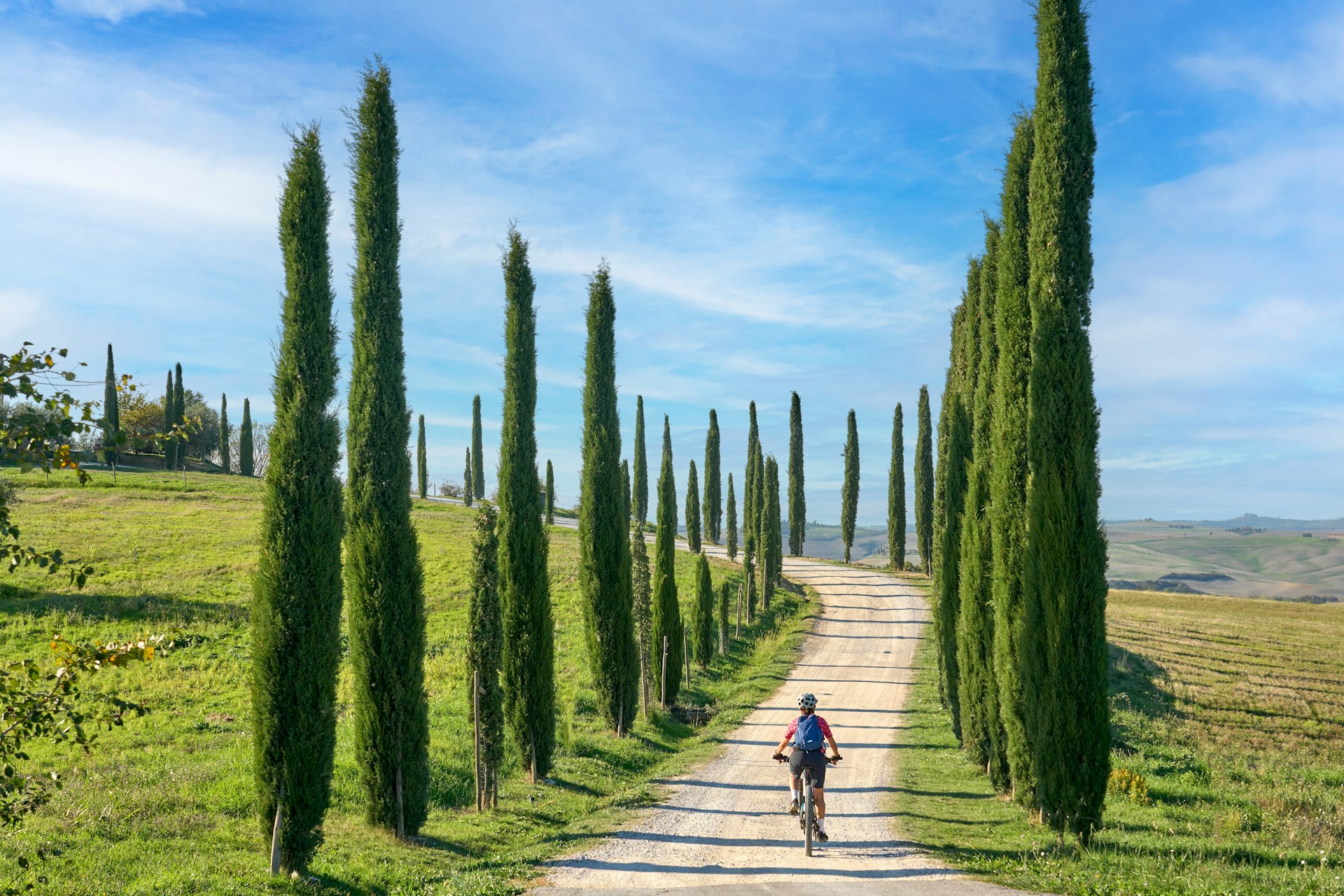
Cycling is a great way to explore the countryside in Italy
Road cycling has long been a popular sport in Italy, but in recent years many regions have invested in building bike paths and itineraries to make this form of sustainable travel accessible to more people. The spread of electric bikes has also contributed to getting people to tour on two wheels – Italy’s hilly and mountainous countryside is no longer an obstacle, thanks to technology.
Northern Italy, especially the Alps and Dolomites , is at the forefront of this shift toward green mobility, offering endless routes for every level of fitness that can be tackled during summer months. But the rest of the country is catching up quickly.
Flat, enjoyable cycling paths run through much of the coast of Liguria . Abruzzo has recently inaugurated its Via Verde – a 40km green lane running parallel to its Costa dei Trabocchi – and the 60km path encircling Umbria’s Lago Trasimeno was completed in 2023. In various parts of Italy, discontinued rail tracks have been converted into mountain-biking routes.
River banks offer the perfect conditions for cycling. Rome, known for its infamous traffic, has a 32km-long path for cyclists, running along the Tiber river through the city center. Tuscany is slowly completing its Ciclovia dell’Arno, which will follow the region’s largest river East to West across 270km, and the VENTO project – aiming to connect Venice with Turin via a 705km path along the Po river – has been in the works for more than a decade.
Bikes are prohibited on motorways, but they can be carried on some ferries and on regional trains displaying the bicycle logo, where you'll need to purchase a separate ticket known as a supplemento bici . Bikes are available for hire in most Italian towns from €12 per day. E-bikes start around €35 per day.

Accessible transportation in Italy
Italy is not an easy country for travelers with disabilities. Cobblestone streets and pavements blocked by parked cars and scooters make getting around difficult for wheelchair users. And while many buildings have lifts, they are not always wide enough for wheelchairs. Not a lot has been done to make life easier for hearing- or vision-impaired travelers either, though awareness of accessibility issues and a culture of inclusion are steadily growing.
If traveling by train, you can arrange assistance through SalaBlu online or by calling 800 90 60 60 (from a landline) or 02 32 32 32 (from a landline or mobile). You can also see the full list of services and details of barrier-free stations on the Rete Ferroviaria Italiana ’s accessible travel information page.
Many urban buses are wheelchair-accessible, though some of the stops may not be – check before you board. Some taxis are equipped to carry passengers in wheelchairs; ask for a taxi for a sedia a rotelle (wheelchair).
Two good online resources for disabled travelers are Village for All , which performs on-site audits of tourist facilities (namely accommodation providers) in Italy and San Marino, and Fondazione Cesare Serono , which provides a list (in Italian) of accessible beaches. For more information, download Lonely Planet's free Accessible Travel guide .
This article was first published May 2021 and updated May 2023
Explore related stories
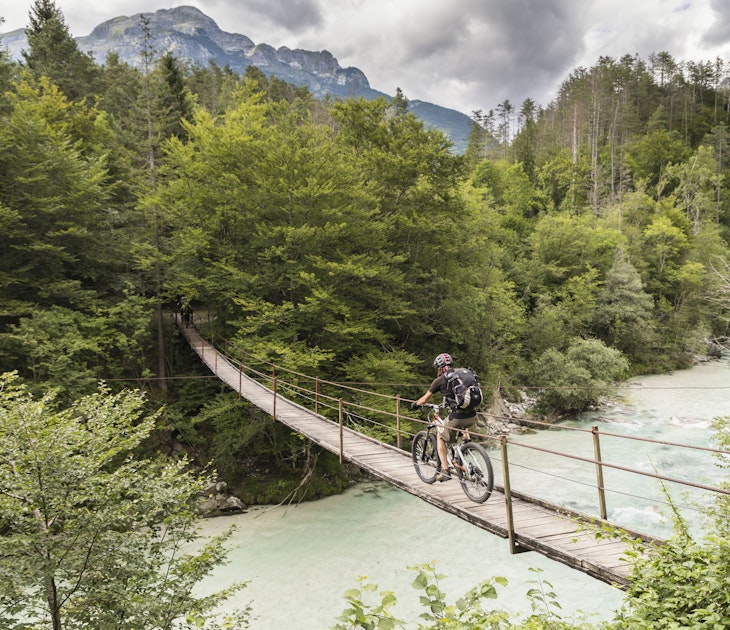
Budget Travel
Apr 27, 2024 • 5 min read
With affordable public transport, great food markets and discount cards, a visit to Slovenia needn't blow up your budget.
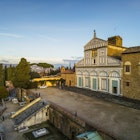
Apr 22, 2024 • 7 min read
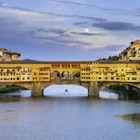
Apr 21, 2024 • 7 min read

Apr 19, 2024 • 7 min read

Apr 19, 2024 • 10 min read

Apr 17, 2024 • 6 min read

Apr 15, 2024 • 10 min read

Apr 9, 2024 • 7 min read

Apr 8, 2024 • 7 min read
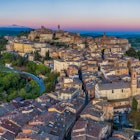
Apr 7, 2024 • 11 min read

Where to stay in Cinque Terre without a car: 5 Best areas
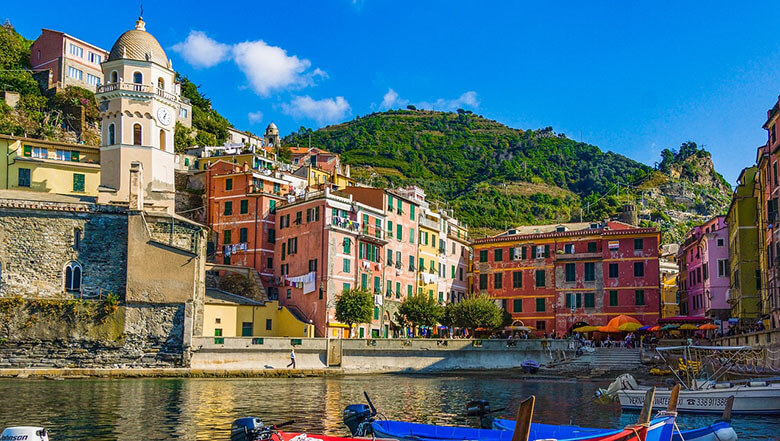
I love to explore places without a car, and on my website, I cover many topics for car-free travelers. In this article, we will visit Cinque Terre and help you find the best places to stay in Cinque Terre without a car.
I will share my recommendations for the top areas to stay in Cinque Terre without a car, along with a helpful map. I’ll also tell you where I stayed in Cinque Terre and suggest the best hotels in Cinque Terre.
Cinque Terre, which means Five Lands in Italian, is a group of five breathtaking coastal villages in the Liguria region of Italy: Monterosso al Mare, Riomaggiore, Vernazza, Corniglia, and Manarola.
The region is a UNESCO World Heritage Site and has become a popular tourist destination for its breathtaking scenery, terraced landscapes, hiking trails, and authentic Italian charm.
Visitors often explore the villages on foot, hiking along the scenic trails that connect them, such as the famous Sentiero Azzurro (Blue Trail). The beauty of Cinque Terre attracts not only tourists but also artists, photographers, and nature enthusiasts from around the world.
Can you get around Cinque Terre without a car?
Yes, you can easily explore and enjoy the beauty of Cinque Terre without a car. In fact, cars are generally not recommended within the villages, as the narrow, winding streets are not suitable for regular vehicle traffic. The most comfortable way to get around is by train, ferry, and on foot.
The train is the most popular and convenient mode of transportation between the five villages. The train connects all the villages, and the journey between them is short and scenic. Trains run frequently, making it easy to explore the entire area.
You can take a train from major Italian cities like Florence, Pisa, Genoa, and La Spezia to reach Cinque Terre. La Spezia is a major transportation hub in the region, and from there, you can easily transfer to trains heading to the Cinque Terre villages.
During the warmer months, you can use boats to travel between the villages. This provides a different perspective of the coastal scenery and can be a pleasant way to travel.
Cinque Terre is known for its beautiful hiking trails that connect the villages. The trails offer stunning views of the coastline and are a great way to experience the beauty of Cinque Terre at a slower pace. Keep in mind that some trails may be challenging, so wear appropriate footwear.
Table of Contents
Where to stay in Cinque Terre without a car?
- Riomaggiore
- Monterosso al Mare
The best areas to stay in Cinque Terre without a car are Riomaggiore, Monterosso al Mare, Vernazza, Manarola, and Corniglia. I recommend booking accommodations close to the train station, carrying light backpacks/luggages, and being prepared for lots of steps and stairs to ensure an enjoyable stay.
If you’re driving, it’s recommended to park in La Spezia or Levanto and then take the train to Cinque Terre. La Spezia and Levanto are the best places in Cinque Terre for travelers with a car.
Monterosso al Mare is the largest and flattest village in the region, making it a great base for families with young kids, and older people. Riomaggiore, Vernazza, Manarola, and Corniglia also have their unique charms and are well-connected by train.
Many accommodations offer free/paid pick up from the train station, and you can also use luggage transportation services if you have heavy luggages and cannot handle it.
During my trip to Cinque Terre, I had 5 wonderful nights at the Alla Marina Affittacamere . It was in a very convenient location, close to everything, including the train station, restaurants, and shops. There were lots of stairs though, but it is a part of the experience when visiting Cinque Terre.
Below is a map of the popular areas in Cinque Terre for car-free travelers. You can scroll down to view the live map.
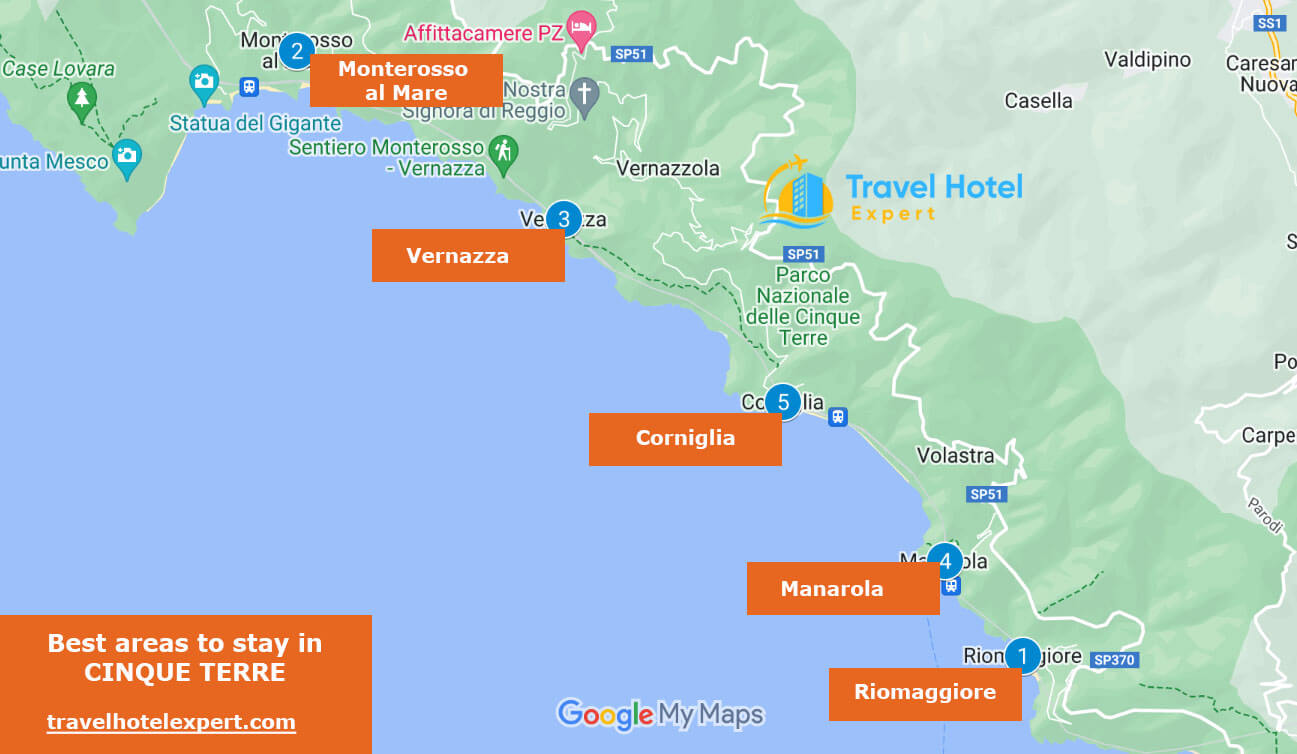
Let’s get into the details of the recommended areas to stay in Cinque Terre, especially for travelers without a car. I’ll provide you with some suggestions for the best places to stay in each area, catering to every budget.
All hotels in Cinque Terre have been carefully selected by me from well-known and secure booking sites such as booking.com, with guest review scores of at least 8.0 or higher at the time I chose them.
If you don’t like my suggestions (perhaps they don’t suit your budget or preferences), you can click the “MORE HOTEL DEALS” button where you can choose your own hotel.
5 Best areas to stay in Cinque Terre without a car are:
1. riomaggiore.
Riomaggiore is the southernmost village of the region and is one of the most popular areas to stay in Cinque Terre without a car. The village is well-connected by train, making it easy to explore other villages or travel to nearby cities. The train station is centrally located, making it convenient for transportation.
Riomaggiore offers stunning views with its colorful buildings and the Ligurian Sea. The village is a great place for photography and enjoying the coastal scenery.
This town has a relaxed and authentic atmosphere. It’s a good choice if you’re looking for a less touristy experience compared to some of the larger villages.
Riomaggiore, like the other Cinque Terre villages, offers delicious local cuisine. You can enjoy fresh seafood, pesto, and other regional specialties.
Like many Cinque Terre villages, Riomaggiore is built on steep hills. Be prepared for some uphill walking, and the streets can be narrow and steep.
Best places to stay in Cinque Terre in Riomaggiore without a car:
Mid-range ($$): Scorci Di Mare , popular accommodation located right at the harbor overlooking the water in Riomaggiore. Easy access to the ferry dock, train station, beach, restaurants and shops. There are narrow stairs to get to the room but it’s more manageable than other places. If you have a car, they can help arrange parking spots and luggage transportation.
Mid-range ($$): Alla Marina Affittacamere , great family-run accommodation in a wonderful location, short distance from local restaurants, shops, waterfront area, and train! You can communicate with the hotel for meetings at the train station, help with your luggage, or arrange car parking if you drive. They have air conditioning rooms and good breakfast.
Mid-range ($$): Sottocoperta , great apartment in a beautiful quiet location right on the main street Via Colombo. Within walking distance to many Bars and restaurants. Short walk from the train station and harbor where the trains/boats leave to the other villages. There are numerous steps to get to the apartment but it is standard of Cinque Terre and part of experience.
2. Monterosso al Mare
Monterosso al Mare is a great base for car-free travelers, families and those who want a beach destination with a lively atmosphere. It is the largest and northernmost of the five villages in Cinque Terre.
Monterosso is known for its beautiful beaches, making it an ideal choice if you enjoy spending time by the sea. The beaches here are larger and more accessible compared to some of the other villages.
As the largest village, Monterosso al Mare has more amenities, including a wider range of accommodation options, restaurants, shops, and services. It offers a bit more in terms of convenience and variety.
The train station in Monterosso is centrally located and well-connected, making it easy to explore other Cinque Terre villages and nearby towns.
While Monterosso is generally flatter than some of the other villages, there are still some hilly areas, and navigating the village may involve some uphill walking.
Best places to stay in Monterosso al Mare without a car:
Mid-range ($$): Albergo Degli Amici , popular 3-star hotel that has amazing breakfasts, stunning views from its terrace. It has a great location in the center of the old town, within walking distance from the train station, boating dock, restaurants, shops, beach, and Sentiero Azurro trailhead. Getting luggage from/to the hotel is less difficult than other places in Cinque Terre!
Mid-range ($$): Hotel Marina , great 3-star accommodation, located within a 7 mins walk from the train station and 3 mins from the beach. There are many great food options and shopping nearby. It has comfortable air conditioning, family rooms, an elevator, and exceptional breakfast on the lemon terrace.
Mid-range ($$): Stella Della Marina , 3-star good value for money hotel, located right in the middle of the old town close to everything, near Monterosso Train Station and the ferry. They provide wonderful breakfast on the beautiful sea-view terrace and air conditioned rooms.
3. Vernazza
Vernazza has a relaxed and authentic atmosphere. While it attracts tourists, it maintains a certain local charm that makes it a popular choice for those seeking a genuine Cinque Terre experience.
The harbor in Vernazza provides stunning views, and you can enjoy a meal or a drink at one of the waterfront cafes while taking in the scenery.
Vernazza is well-connected by train, making it easy to explore other Cinque Terre villages or venture further afield. The train station is conveniently located in the center of the village.
Best places to stay in Cinque Terre in Vernazza without a car:
Mid-range ($$): Camere Fontanavecchia , great accommodation in Vernazza, convenient base for car-free travelers as it is located in a quiet area right next to the train Station. Train can take you to La Spezia and other villages in the region. Also a short distance from the beach, trails, restaurants, cafés and shops. For older people over 60-65 years old, it is recommended to have light luggages/backpacks.
budget ($$): Rina Rooms , good value for money accommodation in a very nice location, close to everything, easy access to the main piazza and the train station.
budget ($$): Hotel Gianni Franzi , 2-star accommodation close to the harbor, the plaza, and the train station. A bit of a steep climb but it is to be expected when visiting Cinque Terre. You can enjoy having breakfast with stunning sea views on the area that is perched on the side of the cliff.
4. Manarola
Manarola is well-connected by train and is a great base for car-free travelers exploring the other villages. It is a fantastic option for an authentic experience with stunning views and good connectivity.
Manarola is celebrated for its breathtaking views and is often considered one of the most photogenic of the Cinque Terre villages. The sunset views over the sea from the harbor are particularly spectacular.
Manarola has a quaint and authentic atmosphere. The village is smaller than Monterosso but still offers a range of amenities, including restaurants serving local cuisine.
There are scenic walking trails in and around Manarola, offering opportunities to explore the surrounding hills and vineyards. The famous Via dell’Amore (Lover’s Lane) trail connects Manarola to Riomaggiore.
Best places to stay in Cinque Terre in Manarola without a car:
Mid-range ($$): Cà de Lelio , beautiful guest house situated in a great location, close to the train station and shop. It has an exceptional view of Manarola, a spacious bedroom, and a huge terrace.
Mid-range ($$): Luxury Seaview Apartments Manarola by Arbaspàa , sustainable apartment near Riomaggiore Beach, easy access to the train station. It features air-conditioned rooms, paid private parking, and paid airport shuttle services. Quiet area of town, but close to everything.
Mid-range ($$): Affittacamere San Giorgio , central location, great base to explore Cinque Terre. Great sunset views. Short walk from a few restaurants and bars. As any area in CInque Terre, it is recommended to prepare for a steep hike from the train station and pay a porter to carry your luggage up the hill to your accommodation.
5. Corniglia
Corniglia is the smallest and least visited of the five villages in Cinque Terre. It is an excellent choice for those seeking a quieter and more authentic experience in Cinque Terre.
Perched on a hill, Corniglia offers beautiful panoramic views of the surrounding vineyards and the sea. The village has a terrace with stunning vistas.
Corniglia is situated on a hill, and reaching the village requires climbing a staircase of around 370 steps from the train station. This might be challenging for individuals with mobility issues.
Best places to stay in Cinque Terre in Corniglia without a car:
Mid-range ($$): AMARE IL MARE Affittacamere , 1-star hotel, conveniently located in a wonderful location in Corniglia right on the trail to hike to Vernazza. Be prepared for lots of hike up from the train station though, but you can use a shuttle bus or ask the host to pick up. Also steps away from shops, restaurants, and marina.
Mid-range ($$): Affittacamere Arbasia De Ma, Terre Marine , great apartment in Corniglia village, 10 mins walk from the train station. The staff can pick you up from 7.30 to 11.30 pm from the train station.
Mid-range ($$): Affittacamere Le Terrazze , very nice apartment in the center of Corniglia. Easy access to the train station, and tourist amenities. Great base for an authentic Italian experience.
In conclusion, Riomaggiore, Monterosso al Mare, Vernazza, Manarola, and Corniglia are the best places to stay in Cinque Terre without a car . These are the five major towns in the region, so you’ll have easy access to tourist attractions and amenities by walking, hiking, and by using trains.
You can continue reading other popular tourist destinations in Italy in these articles:
- Best areas to Stay in Florence first time
- Best areas to Stay in Milan first time
- Best areas to stay in Rome without a car
- Best areas to stay in Bologna without a car
There you have it, my recommendations for the popular areas that you can stay during your car-free trip to Cinque Terre. I hope you found my article helpful and enjoy your holiday!
If you have any questions or would like to share your thoughts, please don’t hesitate to leave a comment below. Your feedback is invaluable and helps me continue to create more quality content.
About Author: Ocean Cameron
I'm Ocean, founder and main editor of travelhotelexpert.com. I’m a passionate traveler who specializes in uncovering the best hotels and locations in every city, especially for first-timers, all without the need for a car.
Disclosure: This page contains affiliate links. This means that, at absolutely no additional cost to you, I'll earn a small commission if you click through and purchase something I've recommended. I only recommend products that I use myself or firmly believe in. Thank you!
Leave a Comment Cancel reply
Save my name, email, and website in this browser for the next time I comment.
- Tour Account ›
- Travel Forum ›
- Travel Forum
- Sicily without a ...
Sicily without a car - 14 day itinerary
My wife and I are planning a trip to Sicily. 14 days, but we won't have a car. Our planned itinerary is as follow. Any feedback or advice is greatly appreciated. Fly into Catania. Catania - 3 nights Catania to Syracusa by train Syracusa - 2 nights Syracusa to Ragusa by train Ragusa - 2 nights Ragusa to Agrigento by train (or bus) Agrigento - 3 nights Agrigento to Palermo by train Palermo -2 nights Palermo to Catania by train Catania - 1 night Fly out of Catania
With this itinerary we would not be going to the Northeast part of Sicily. Is that a mistake?
I've only been there once. But I think the only reason to stay in Catania, is to visit Mt Etna. I'd trim a day or three from Catania and add to Syracusa. And fly out of Palermo - no need to backtrack. Or, if not interested in Mt Etna, fly in and out of Palermo. You can still reach the places on your list from there.
I agree with both suggestions. And in Syracusa, stay in Ortygia, an island (connected by a bridge) that is the historical center of Syracusa. Look for little circulator buses that can take you into Syracusa for the archeological park.
Two nights might be enough for Agrigento. Add the third night (and the final night in Catania) to Palermo.
This will give you a good taste of Sicily.
2 nights is definitely enough for Agrigento. 1 night could even do if you time it right; the upper town is interesting but I think that it can be skipped/seen in passing, the main draw is really the Temple Valley and that is not very large. And Siracusa and Palermo definitely deserve 1 extra night, each.
One full day, meaning two nights in each Catania and Agrigento, as already mentioned by Stan and balso, is more than enough. Catania’s highlights can be seen in half a day especially since you’re going to visit Agrigento. One can visit the Valley of the Temples in 3-4 hours and there’s nothing significant in the town itself. Seeing the temples lit up at night is pretty. I’d add a day to each Siracusa and Palermo. Then, you could take a half day trip from Palermo to Monreale and maybe from Siracusa to Noto. I can’t speak to trains or busses as we had a rental car.
Depending on how many of the baroque villages you want to see, you mght do better with 4 nights in Siracusa. You definitely will do better with 4 nights (I was happy to have more) in Palermo. It has a lot of sights, then you have the trips to Monreale and Cefalu.
I agree that 4 nights is way too many in Catania. If you must fly both in and out of that airport, it would be much more efficient to put all your Catania nights at the end of the trip. If you don't arrive in Catania too late, I recommend moving on to Siracusa immediately. Just don't count that as a sightseeing-in-Siracusa day. This might call for adding yet another night in that city.
Thank you for your feedback everyone! Making adjustments to my itinerary based on the feedback.
This topic has been automatically closed due to a period of inactivity.
- Italy Tourism
- Italy Hotels
- Italy Bed and Breakfast
- Italy Vacation Rentals
- Flights to Italy
- Italy Restaurants
- Things to Do in Italy
- Italy Travel Forum
- Italy Photos
- All Italy Hotels
- Italy Hotel Deals
- Last Minute Hotels in Italy
- Things to Do
- Restaurants
- Vacation Rentals
- Travel Stories
- Rental Cars
- Add a Place
- Travel Forum
- Travelers' Choice
- Help Center
Getting around Sicily without a car - Italy Forum
- Europe
- Italy
Getting around Sicily without a car
- United States Forums
- Europe Forums
- Canada Forums
- Asia Forums
- Central America Forums
- Africa Forums
- Caribbean Forums
- Mexico Forums
- South Pacific Forums
- South America Forums
- Middle East Forums
- Honeymoons and Romance
- Business Travel
- Train Travel
- Traveling With Disabilities
- Tripadvisor Support
- Solo Travel
- Bargain Travel
- Timeshares / Vacation Rentals
- Europe forums
- Italy forum

Any guidance as to whether Sicily is realistic to travel around by public transport, and the best regions to stay, would be so appreciated.
2 replies to this topic

Where are you coning from; where after Sicily?

Sicily is a large island, filled with treasures and optimally a two-week (or more) destination. Public transport is very doable if you visit the major cities and well-known/well-traveled highlighted destinations. It becomes less convenient if you wish to explore the countryside and/or smaller towns.
The "best regions" are those that are of interest to you. At this stage, I'd hop over to your nearest large bookstore's travel section and pick out an appealing guidebook on Sicily. Take time reading up and making notes of interest. For a week's travel, I would pick either the western region (flying in and out of Palermo ) or the east/southeast (flying in and out Catania ) and my preference for a first-time visit would be the east/southeast/Val di Noto area. For 7 days, I'd have no more than two base destinations and take reasonable day trips if desired.
July is going to be very hot and packed with visitors...and all popular seaside destinations will be quite crowded. Hopefully destination expert Vagabonda will be able to reply with her excellent guidance.
- 12 days Itinerary- Italy 9:27 pm
- St. Mark's Bell Tower Tickets? 9:23 pm
- Driving from Siena to Pienza at night? 9:20 pm
- Luggage storage at Stazione Marittima in Palermo 9:09 pm
- Flight after cruise - need your help in planning 8:57 pm
- A slight itinerary pickle - Portovenere to Puglia ;-) 8:43 pm
- Trains, ferries and buses late in the evening in Oct 8:42 pm
- Palermo - transfer from bus to ferry...luggage storage 8:42 pm
- staying in Bergamo or Lago D'Iseo 8:26 pm
- Spello to Montefalco by bicycle or e-bike? 8:15 pm
- Palau Ristorante and Wine Bars 8:12 pm
- Pisa-CinqueTerre(Manarola?)-Rome:Buy train tickets from now? 8:06 pm
- It is so busy already 8:04 pm
- SUV for Rome-Sorrento-Positano (maybe Amalfi)-Pompeii-Rome? 8:00 pm
- Best time of year to visit Italy 3 replies
- What to Buy in Italy? 5 replies
- BNL D'Italia Bank locations 35 replies
- Train from Milan to Monaco 2 replies
- train from Milan to Cinque Terre 13 replies
- 5 Best Cities to Visit 48 replies
- Frecciarossa vs Frecciargento 13 replies
- simple explanation please for "allora....alora " 6 replies
- Milan to Lucca 9 replies
- Northern Italy - Lake Como & Switzerland 4 replies
Italy Hotels and Places to Stay
- TIPS FOR FIRST TIME TRAVELLERS
- How to use the trains in Italy
- Thinking of renting a car? Read this first
- Ultimate Guide to Driving in Italy
- Tips for travellers to Italy (based on our recent travels)

Want to work remotely in Italy? The country just launched its new digital nomad visa.

Remote workers with dreams of working from the rolling hills of Tuscany or the cliffs of Positano are now one step closer to making that reality. Italy launched a new digital nomad visa.
Two years after its announcement, the highly anticipated digital nomad visa officially became available for those eligible on April 4.
“Italian-style, everything happens slowly,” said Nick Metta, a lawyer for the law firm Studio Legale Metta , which has helped Americans relocate to Italy for decades. “Now there is a pipeline of people waiting just to file the application. It's been a long-awaited visa.”
Most of Metta’s clients would previously apply for a student visa, which allowed them to work part time in Italy.
Under the new visa, people will be able to work from Italy for one year, with the option to renew once their visa is due for expiration. Without a visa, U.S. travelers could only stay in Italy for up to 90 days without the ability to work.
Learn more: Best travel insurance
The launch makes Italy the latest European country to offer a digital nomad visa , which has already been available in Greece and Hungary.
Here’s everything we know about the digital nomad visa for Italy:
Destinations behind a paywall? What to know about the increasing tourist fees worldwide.
Who can apply for a digital nomad visa in Italy?
According to the official decree , the visa is meant for those who “carry out a highly qualified work activity through the use of technological tools that allow you to work remotely.”
The regulations define eligible applicants as “digital nomads,” self-employed freelancers, “remote workers,” or those employed by a company outside of Italy and can work from anywhere, according to Studio Legale Metta.
To qualify for the visa, the applicant has to meet certain requirements:
◾ A university or college degree or an accredited professional license.
◾ Six months of work experience in the industry, or five years for applicants without a university degree.
◾ An existing employment contract.
◾ A criminal record check.
◾ Proof of an annual income of 28,000 euros (about $29,880.06).
◾ Evidence of housing in Italy.
◾ Evidence of health insurance coverage.
Applicants can also apply to have family members join them on their Italian move, but the government has to give the final approval.
How do I apply for the digital nomad visa in Italy?
Thankfully, Metta said the paperwork for the digital nomad visa isn’t “too complicated.”
The first stop for interested applicants will be the Italian Consulate for their area. “Consulates are basically the front of the government to receive the applications,” Metta said. Interested applicants can book an appointment with the consulate and start gathering their necessary documents. People can also apply by mailing in their application. (However, Metta did mention consulate websites are often confusing and outdated, so working with a relocation service can make things easier.)
To apply, applicants will also need a passport with an expiration date at least three months after the end of the visa period and two passport-sized photos.
Relocation services can also help people navigate the sometimes complicated process of applying for a visa, such as negotiating early termination penalties with landlords in Italy.
These services also help people with state and tax planning, especially if people own assets in the U.S., like a house. Once in Italy, people need to register their residency with the town hall, which will determine what sort of taxes they’ll pay. People can speak to an international tax specialist to figure out their future taxes as well.
How much will the visa cost?
According to Studio Legale Metta, the application fee is 116 euros (about $123.78) per person.
How long will the application process take?
Not too long, actually. Metta estimates the process could take just three weeks if applicants are “well-organized and have all your tax documents filed.”
Kathleen Wong is a travel reporter for USA TODAY based in Hawaii. You can reach her at [email protected] .

IMAGES
VIDEO
COMMENTS
1. The Car-free Village. At the top of our top 5 and in the far north of Italy is a smog-free, noise-free, stress-free village: Chamois, the only car-free municipality in Italy. A referendum in 1955 decided to abolish the circulation of cars in this enchanted little place.
4 Best Apps for Transportation in Italy. 4.1 Google Maps. 4.2 Citymapper. 4.3 Trenitalia and Italo. 4.4 RyanAir and EasyJet. 4.5 AppTaxi.it & Uber. 5 Planning Your Italian Itinerary Without a Car. 6 Tips for Traveling in Italy Without a Car. 7 Challenges for Visiting Italy Without a Car.
Don't let a rental car shortage keep you from these bucolic Italian destinations. By Elizabeth Heath. August 5, 2021 at 12:00 p.m. EDT. An aerial view of the harbor on the island of Ponza. The ...
How to Get to Alta Badia Without a Car. In summer (mid-June - mid-October), you can reach Alta Badia by bus from Val Gardena. Bus Line 473 connects Val Gardena with Val Badia (Colfosco and Corvara) with a transfer in Seilbahn Plan de Gralba/Funivia Plan de Gralba. 2024 Bus 473 timetable . It's also possible to travel from Cortina d ...
There are both trains and buses leaving from Lucca, so you have options for day trip transport. And, in the evenings, you can enjoy local Lucca life. Places you can easily visit from Lucca include: Train - Florence, Pisa, Pistoia, Viareggio. Bus - Collodi (village and Pinocchio Park ), Florence.
Visiting Tuscany to visit without a car: summary. In my opinion, the five best ways to explore Tuscany without a car are: Using the train, using Florence Pisa or Lucca as a bases. Using local buses, especially using Florence as a hub - best budget option.
Whether you are a local or tourist, you are able to travel in (and to) Tuscany without a car. Italy has incredible and affordable public transport. As Tuscany is one of the most popular tourist destinations, you can easily visit all of the towns and main attractions by bus, Vespa, bicycle or train. ... Italy By Car - www.italybycar.it ...
For example; Pisa, Lucca and Siena all have direct rail connections to Florence, meaning you can visit them as day trips. When planning your car-free Tuscany itinerary, the rail network map and train timetables are your best friends. There are two rail companies in Italy: Trenitalia and Italo.
7. Perfect itinerary for 5 days in the Dolomites (without a car needed) Day 1: Hiking Resciesa to Seceda. Day 2: Paragliding over Val Gardena and exploring Alpe di Siusi. Day 3: Hiking around the base of the Sassolungo Group. Day 4: Resciesa summit loop. Day 5: Exploring the Vallunga and spa afternoon. Bonus activities.
Fortunately, Rome is very well connected and there are plenty of alternatives to getting behind the wheel of a car. The best option for you will depend on where you're going to and from, but some of the most popular choices for how to get around in Rome include: Hop-On Hop-Off bus tour. Walking. Metro. Public bus. Tram.
Follow our guide and you'll be on your way to planning your own trip or choosing the right tour for you and your travel companions. Step 1 - Decide when you want to go and your budget. Step 2 - Do some preliminary research and preparation. Step 3 - Confirm your itinerary.
October 15, 2020. There's no question that the Dolomites are most commonly traveled by car, but I'm here to tell you that it is absolutely possible to spend three or more days hiking in the beautiful Northern Italian mountain range with no car. The following is an itinerary for three days, and we even ensured that we experienced different ...
Activities: For this itinerary, you can expect to pay around 62.90 EUR for activities, 38 EUR for the Seceda cable car and 24.90 EUR for the Alpe di Siusi cable car and that is it. Total Budget for 7 days in the Dolomites: 501.9 EUR.
Days 1+2: Bari, Puglia's capital and an underrated Italian city. Day 3: Alberobello, known for its unique Trulli houses ( optional: Locorotondo ). You can also visit Alberobello with a guided day tour. Day 4: Polignano a Mare + Monopoli, two magnificent coastal towns.
2.8K. This Sicily itinerary will show you exactly how to see the most amazing places on the island without a car. Using a combination of buses, trains, boats, one bicycle and your own two feet, you'll be able to see spectacular churches (like the one in Noto, above), breathtaking beaches (my favorite was on the island of Favignana) and charming medieval towns.
Take on Sicily — by bus. Sunset on Lombardy Castle, Sicily. This last one is not for the fainthearted. If southern Italy is hard by public transport, Sicily, most people will tell you, is impossible. Yes, there's an old train line, which stretches around the coast. It's functional enough, but slow and a little dull.
Varenna is one of the best towns to stay in Lake Como without a car that combines charm and convenience. It's one of the few towns on Lake Como with a train station, and you can get from Milan to Varenna in about 1.5 hours by train by taking the train from Milan to Lecco and then transferring on to Varenna. Being located in the central part ...
Bari: From Bari, you can explore Polignano a Mare and Monopoli by train. Martina Franca: It's cheaper than Alberobello, and it just takes 15 minutes by train to reach Trulli village. From Martina Franca, you can do a day trip to Locorotondo too. Ostuni: You can't miss the white village, the door to Salento.
Bari ---> Polignano a Mare ---> Monopoli ---> Locorotondo ---> Lecce. This itinerary is bookended by two main cities with three smaller towns in between. If you're entering and leaving Puglia from Italy, it's easy to do so via train, as there's a major station in Bari. If you're coming from a different country, you'll likely fly in and out of ...
4. Re: Where to Stay in Italy Without a Car. We've been going to Lake Garda for over 20 years and have never felt the need to have a car. We use the ferries and local buses to travel around other lake towns, and you can even walk between some of the towns using lakeside paths.
How to get around Italy without a car: understanding the public transport system. Ranging from snow-capped Alpine peaks surpassing 4,000m in altitude to wild Mediterranean archipelagos, the diverse geography of the Italian peninsula doesn't allow for one single mode of transport to move people around the country. Trains, buses, ships and ...
5 Best areas to stay in Cinque Terre without a car are: 1. Riomaggiore. Riomaggiore is the southernmost village of the region and is one of the most popular areas to stay in Cinque Terre without a car. The village is well-connected by train, making it easy to explore other villages or travel to nearby cities.
Jump to bottom. Posted by Sandor (Canada) on 03/30/22 06:12 AM. My wife and I are planning a trip to Sicily. 14 days, but we won't have a car. Our planned itinerary is as follow. Any feedback or advice is greatly appreciated. Fly into Catania. Catania - 3 nights. Catania to Syracusa by train. Syracusa - 2 nights.
Getting around Sicily without a car - Italy Forum. Europe ; Italy ; Italy Travel Forum; Search. Browse all 555,759 Italy topics » Getting around Sicily without a car Watch this Topic ... Any guidance as to whether Sicily is realistic to travel around by public transport, and the best regions to stay, would be so appreciated. Reply. Report ...
Under the new visa, people will be able to work from Italy for one year, with the option to renew once their visa is due for expiration. Without a visa, U.S. travelers could only stay in Italy for ...
In travel news this week: a gelato ban in Italy, runaway horses in central London, the orange fog that hit Athens and - if you're still feeling brave enough - the best dates and times to ...
Rewards: Earn 1 point per dollar on rent payments without the transaction fee (on up to 100,000 points each calendar year), 3 points per dollar on dining, 2 points per dollar on travel (when ...